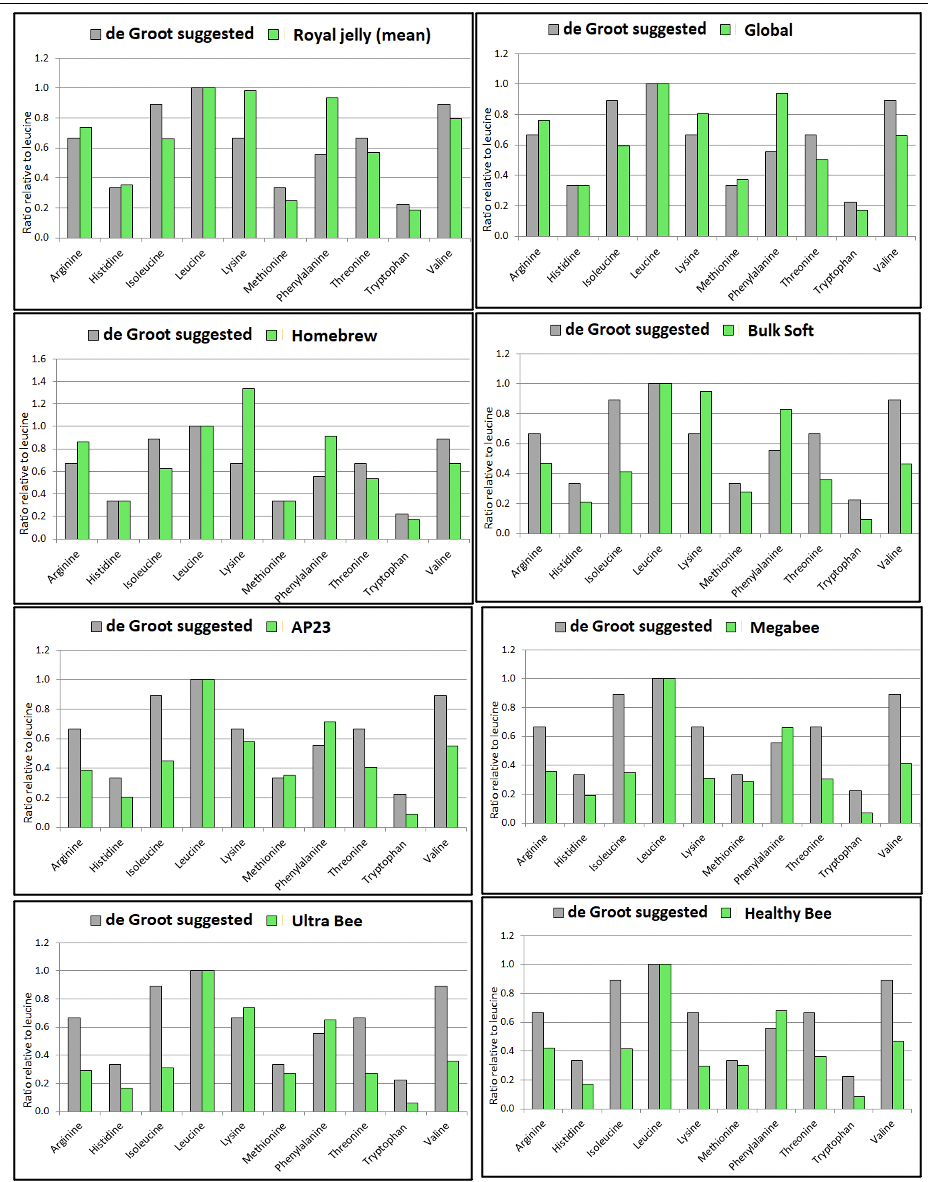Contents
An additional test of matrices and OA:gly ratios. 1
Cardboard Strips vs. Sponges. 3
Compostability of spent sponges. 3
A winter field trial 4
Methods. 5
Results. 9
Discussion. 11
The Elephant in the Room.. 12
Reality Check. 12
A possible easy solution for getting us legal 13
Citations and notes. 15
2022 Extended-release Oxalic (OAE) Update
Part 2
First published in ABJ April 2022
Randy Oliver
ScientificBeekeeping.com
I continue with my research on various application methods of extended-release oxalic acid (OAE), and my efforts to get the method registered with EPA.
An additional test of matrices and OA:gly ratios
I get suggestions from all over the world for absorbent matrices to test. So come autumn, I rustled up enough “leftover” colonies with elevated mite counts to run a small comparative trial. I wanted to compare Maximizer strips to ShamWow towels, and to New Zealand chipboard (cardboard) hung strips. In addition, since New Zealanders typically use a higher-glycerin 1:1.5 ratio, I gave that ratio a try on both the hung chipboard and the Maximizer strips.
The colonies were in double deeps, in poor shape due to dearth and mites, with 5-10-frame clusters. With help from visiting beekeepers Jim Veitch, Jennifer Radke, and Catherine Edwards, we applied the test strips and fed each colony a patty of pollen sub. Each hive got four 1¾“ x 7½” strips of Maximizer (lightweight) or ShamWow rayon microfiber cloth, laid across the top bars, or three chipboard strips (the recommended amount) hung over the top bars in each brood chamber (Figure 1). The treatments were assigned in a randomized block design, blocked by starting mite count.
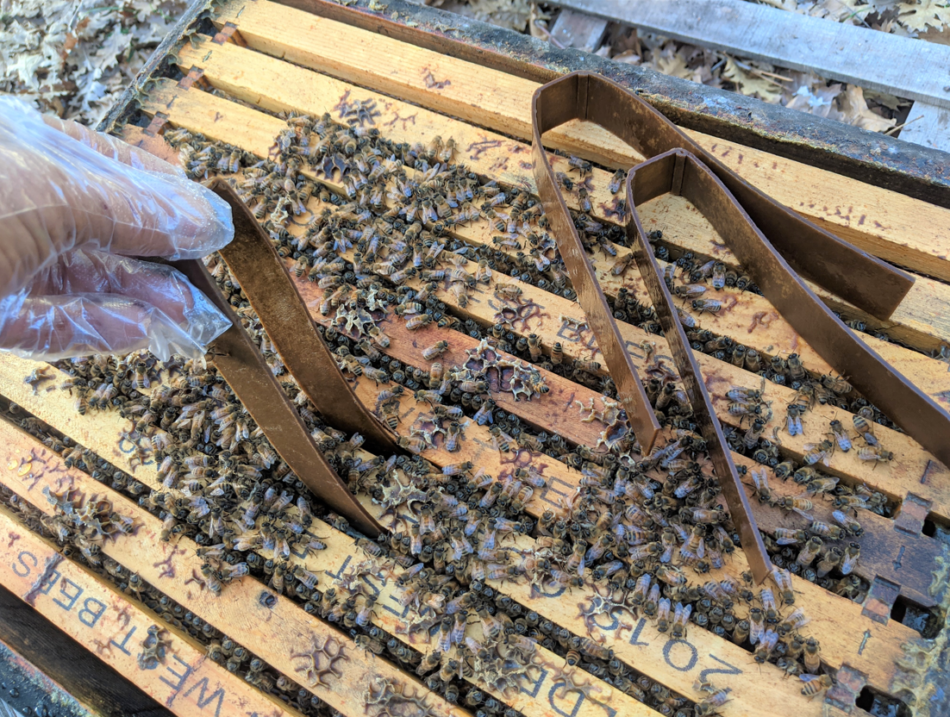
Fig. 1 I used Beequip chipboard strips from New Zealand, soaked in a 1:1.5 ratio of OA:gly, by weight. New Zealand supply houses carry a variety of such precut strips.
I ran the trial for 77 days, taking mite wash counts at start and finish (Table 1).
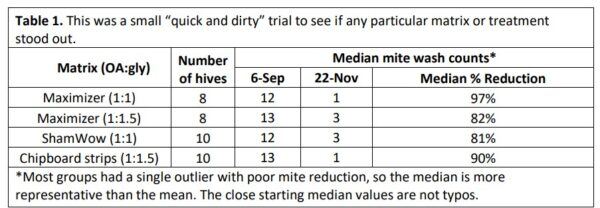
Practical application: All the tested matrices exhibited good mite reduction, with the Maximizer 1:1 and chipboard 1:1.5 strips having the most ending counts of zero or 1. Although Maximizers at the 1:1 ratio looked best (in either raw or worked data), I would like to test chipboard strips at the 1:1 ratio.
Chipboard Strips vs. Sponges
I’ve been focusing upon absorbent pads that can be quickly laid across the top bars of the lower brood chamber, rather than chipboard strips which need to be inserted between the frames of both brood chambers (which is far more time-consuming). But there are situations (such as in singles) in which there is not enough exposure area to the upper surface of a delivery pad to be effective, so the treatment would then need to be inserted between the frames. Chipboard strips are definitely easier to insert than are soft matrices such as sponges or Maximizers.
Practical application: One would expect that strips hung between the frames would have more contact with the bees’ bodies as they squeeze by, and thus be more effective at distributing the OA/gly onto the workers. Surprisingly, that does not appear to be the case. For full efficacy of OAE with pads laid across the top bars between the brood chambers, it takes about 55 sq in (355 cm2) of matrix surface area, holding 50 g of OA dissolved in 50 g of glycerin, per double-deep hive. For cardboard strips hung over the frames, based upon data from Aluen CAP, Dan Aurell, the New Zealand beekeepers, and my own, it actually requires more surface area when using strips (80-115 sq in/ 520 – 740 cm2 per double-deep hive). Go figure!
Compostability of spent sponges
Once an OAE matrix has largely dispensed its OA, it needs to be pulled or scraped out of the hive, since the bees generally don’t remove them. The spent strips still contain some amount of OA, and need to be handled appropriately during disposal. Some pieces invariably fall on the ground, so I favor using biodegradable strips, so that we don’t leave non-biodegradable plastic pollution in our yards (the ShamWows may not fit this bill [[1]]).
If a fallen strip gets hit by rain, the OA gets washed out, and the remaining cellulose gets treated by decomposition organisms similarly to that in a fallen leaf. I wondered whether a spent Swedish sponge still containing OA and glycerin would get decomposed if added to a compost pile. So I buried a few in an active compost pile in my garden (Figure 2).
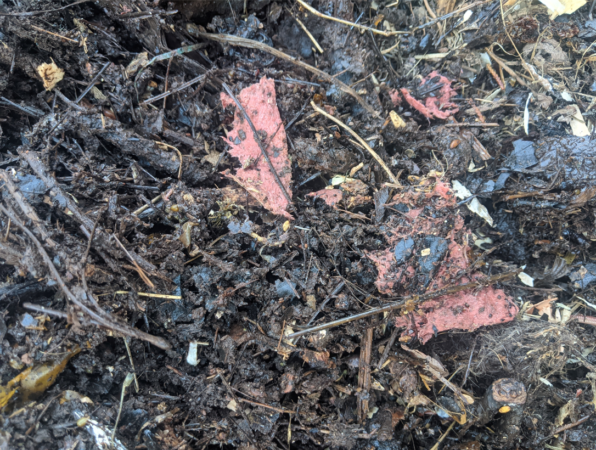
Fig. 2 After a few weeks, I had trouble locating any remnants of the pink sponges, since they were well along in the process of being decomposed.
Practical application: I abhor the way that we’re polluting our environment with plastic, so prefer using biodegradable cellulose matrices.
A winter field trial
By this time, we’ve gotten a good idea about the amount of OAE pad required for good efficacy against varroa during the summer, when colonies have an active broodnest. I also had preliminary data that it could be efficacious during winter and didn’t appear to harm the colony. So I decided to run a full-scale trial in a yard at an elevation that “normally” gets cold enough to cause a winter brood break (as if there were any weather “normal” any more in California).
There were two questions that I wanted to answer:
- Would treatment with OAE cause any adverse effects upon the long-lived winter bees due to prolonged exposure to OA, or otherwise adversely affect colony buildup prior to almond pollination?
- Could OAE be used to try to zero out mites over winter, giving colonies a clean start for their first rounds of brood rearing?
Methods
In early November, following a rough summer dearth, we graded 45 moderately-strong double-deep colonies for strength and took mite wash counts (the colonies had been previously treated with OAE strips). Most had ceased brood rearing a week or so earlier (due to cool weather and lack of incoming pollen), and had only a small amount of sealed brood (about to emerge) remaining. I assigned treatment in a randomized block design, first blocking by mite infestation rate, and then by colony strength, and then randomly assigning an OAE treatment to one of each matched pair of hives. We applied ½ of a Swedish sponge (saturated with a solution of 25 g each of OA and glycerin [1:1 formulation by weight]) to each hive in the Test group (Figure 3).
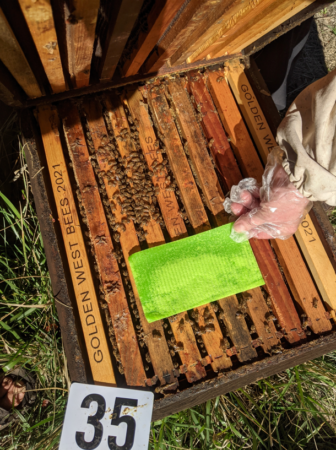
Fig. 3 We applied a half OAE sponge to each Test colony, placing it in the front third of the cluster. Although this location resulted in suboptimal exposure of the bees to the treatment, it left room for us to feed pollen sub in the middle of the clusters.
Practical application: Bees won’t consume pollen sub that’s come in contact with an OAE sponge, so one should leave a space between them. Another tip that I’ve received is to insert a ¼-inch shim between the brood chambers in order to give the bees more space above the OAE sponges for them to walk over, but I have not yet tested this.
To our surprise (something that we’re getting used to), the weather unexpectedly warmed up, hitting 70°F on the first of December! Plants responded, the bees started bringing in a little pollen, and the colonies resumed rearing a bit of brood. I’ve laid out the timeline in Figure 4.
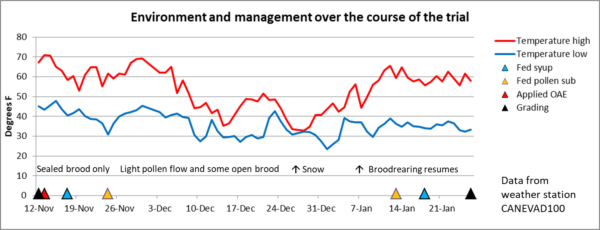
Fig. 4 The yard got slammed by a cold snowstorm on December 26, which really set back the “spring turnover” of the colonies. But by mid-January, the temperature rose, the alders started producing pollen, and the colonies resumed brood rearing in earnest.
The surprise subfreezing temperatures and coverage with snow hit the colonies hard, and many had piles of dead bees in front of them once the snow melted (Figure 5). We checked in front of every hive for the presence of dead bees, comparing it to treatment assignment, and did not observe any correlation with whether the colony had received OAE or not.
Practical application: The above observation suggests that OAE treatment did not cause elevated mortality of the aged adult bees.
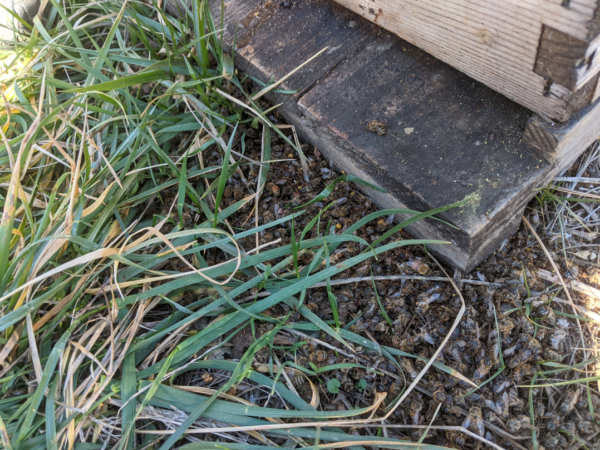
Fig. 5 I took samples of bees from the nine worst piles, and took them home for microscopic analysis, looking for the presence of nosema spores in a homogenized subsample of 10 bees — three subsamples had no nosema, three had a little, and three were fairly well infected.
Practical application: It didn’t appear that nosema was the main problem, since I would have expected to see nosema in dead older bees following a late-winter pollen flow (since pollen in the gut stimulates nosema reproduction).
Then it warmed up again, and by late January the colonies were full of a new round of sealed brood (Figure 6).
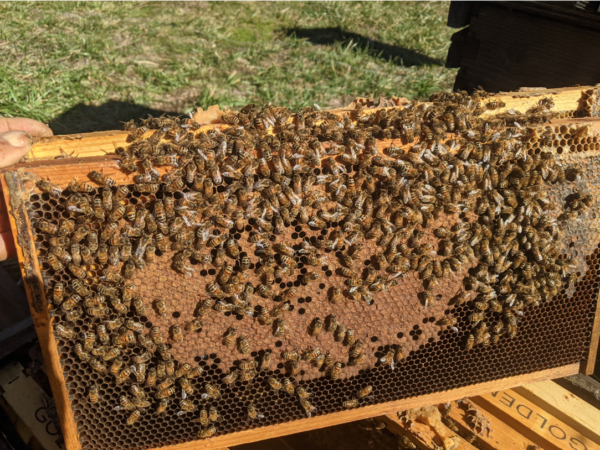 Fig. 6 I took this photo on the day of final grading. The cluster barely covered three frames, but was rearing as much brood as it could keep warm. There are about 1500 pupae on this side, and only 445 adult workers (yes, I counted ‘em). The 7-frame colonies contained three full frames of brood. It’s easy to see how colonies can grow quickly once pollen becomes available.
Fig. 6 I took this photo on the day of final grading. The cluster barely covered three frames, but was rearing as much brood as it could keep warm. There are about 1500 pupae on this side, and only 445 adult workers (yes, I counted ‘em). The 7-frame colonies contained three full frames of brood. It’s easy to see how colonies can grow quickly once pollen becomes available.
Although I would have liked to have performed one more grading after the sealed brood emerged, we needed to move the hives to almond pollination, so performed final grading on January 26.
Results
The raw data is presented in Figure 7.

Fig. 7 None of the colonies had yet rebuilt to their starting strengths. For analysis (including the graphs above), I removed four badly-dwindled outlier colonies from the Control group, so did the same for the OAE group as well.
Rather than the absolute values shown above, it may be more informative to compare the colonies’ relative changes in strength vs. their starting strengths (Figure 8).

Fig. 8 All the colonies were weaker in January than in November, but since they were full of sealed brood, they would be expected to greatly increase their sizes to above starting strength by time of grading in almonds. The OAE-treated group as a whole lost slightly more strength than did the Controls, but the difference was not statistically significant [[2]].
Practical application: So was there an adverse effect from treatment? It’s difficult to tease out from this small data set (with only one replicate). I now wish that I had prioritized colony strength (over initial mite count) when I assigned treatments, since larger clusters have a distinct advantage over smaller clusters as they initiate brood rearing [[3]]. As you can see in Fig. 7, the Control colonies wound up starting out stronger than the Test group, and thus would have been expected to overwinter and then grow better than the Test colonies. So I’m fairly confident that there was no adverse effect upon colony strength or buildup.
So far I haven’t discussed the possible benefit from treating with OAE in the first place — did it bring down the mite infestation rates? I fully expected over-winter treatment to zero out the varroa infestation rate, but it didn’t (Figure 9).
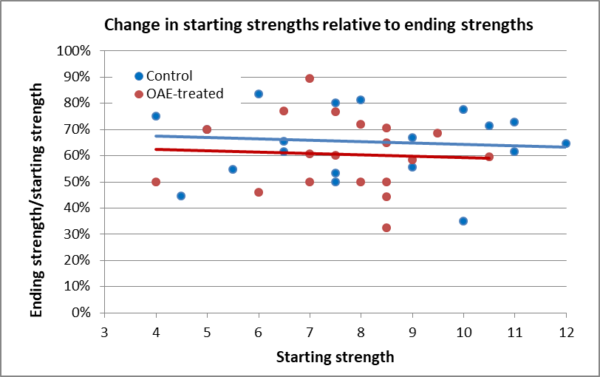
Fig. 9 The mite wash counts generally grew in the Control colonies over winter, but to my surprise, having an OAE pad in the hive did not zero out the infestation rates of the Treated group.
I was surprised by the lack of efficacy due to treatment after 71 days of exposure. The average mite count did go up by 55% in the Control group, but only decreased by a measly 3% in the treated group (Figure 10).
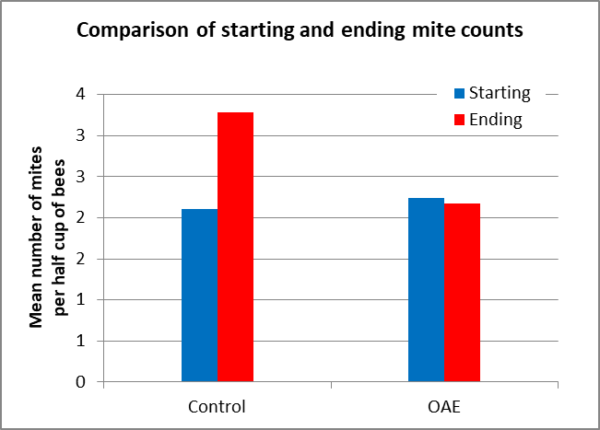
Fig. 10 I used the Henderson-Tilton formula to calculate average efficacy of the treatment, which worked out to only a disappointing 37%.
Discussion
Practical application: Although OAE appears not to cause harm to a colony over winter, it may not cause much harm to the varroa mites either! Although OAE can be highly efficacious during the summer, it remains to be determined whether it is appropriate for winter treatment.
The Elephant in the Room — our “scofflaw problem”
After the invasion of the varroa mite, researchers around the world published research on how this or that agricultural miticide (e.g., Mavrik, coumaphos, Taktic) could successfully be used to control varroa. Unfortunately, due to the frustratingly-slow registration process required by the EPA to register a product for use in bee hives, beekeepers, desperate to keep their colonies alive, would start using such treatments prior to approved formulated products being brought to the market [[4]].
Such “off-label” use of miticides is in violation of the law, and even when a legal product was finally brought to the market, many beekeepers continued to use the cheaper homemade treatments. It is no secret that our commercial industry remains widely dependent upon imported, unregistered, illegally-applied amitraz products for mite control. The fact that beekeepers, who often demand pesticide application compliance by farmers, are often pesticide scofflaws themselves, is a point not lost upon the EPA and its enforcement agents.
Our state apiary inspectors (as well as the EPA state lead agencies) have long turned a blind eye towards the illegal use of homemade miticide treatments for varroa management.
Practical application: Some inspectors are getting tired of this hypocrisy, and are calling upon the EPA to start enforcement actions. Not only that, but mites are finally starting to develop resistance to amitraz. Because of this, commercial beekeepers are looking for another effective way to manage varroa.
It occurs to me that now is a chance to get our industry back into compliance. One of the most promising miticides to replace amitraz is oxalic acid, for which there is only one currently registered (and high-priced) product, with only three approved application methods. What I was trying to do was to get the Registrant — USDA-ARS — to get the extended-release (in glycerin) application method added to the label (as well as some other improvements) Unfortunately, USDA recently decided to cease pursuing new registrations. A number of beekeepers have told me that they are disappointed in USDA-ARS, which hands out millions of dollars in grants to bee researchers each year, for not helping our industry by getting this additional application method approved while they were still the Registrant. So I’m back in discussion with EPA and others.
Reality Check
OAE is currently being researched in many countries. A formulated product — Aluen CAP — is registered for use in Argentina, Uruguay and Chile, and should soon be approved in other countries. In other regions, some beekeepers are jumping the gun and mixing their own, and due to its obvious safety, authorities often turn a blind eye to this practice. Generic 99.6% purity OA is readily available, meaning that no matter the law, many beekeepers will likely mix up their own OA treatments, rather than purchasing a pricey formulated registered product. What can we do in order to get us into compliance with the law?
Practical application: There is only a small profit margin of in commercial beekeeping, so professional beekeepers try to avoid any unnecessary costs. This means that there is a strong financial disincentive to purchase high-priced registered miticides. Thus, the use of inexpensive illegal treatments results in an unlevel playing field, giving those who use unapproved treatments an unfair competitive advantage over those professional beekeepers willing to use only approved mite treatments. I don’t want to break the law, but I also don’t want to pay through the nose for a registered oxalic product.
A possible easy solution for getting us legal
New Zealand’s Ministry for Primary Industries came up with a very workable solution. They allow beekeepers to prepare and apply generic oxalic acid to hives that they own, plus take full responsibility for applicator safety (Figure 11).
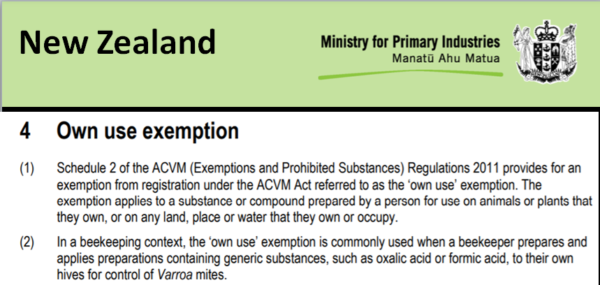
Fig. 11 I lifted the above snip from the actual document [[5]]. Beekeepers in New Zealand can legally prepare and apply generic oxalic and formic acids to their own colonies. This is a sensible solution, since neither substance poses “any unreasonable risk to man or the environment, or a human dietary risk from residues that result from a use of the pesticide” [[6]]
The Exemption does not allow the sale of any unregistered formulated product, but supply houses can sell the raw ingredients for beekeepers to mix up their own (Figure 12).
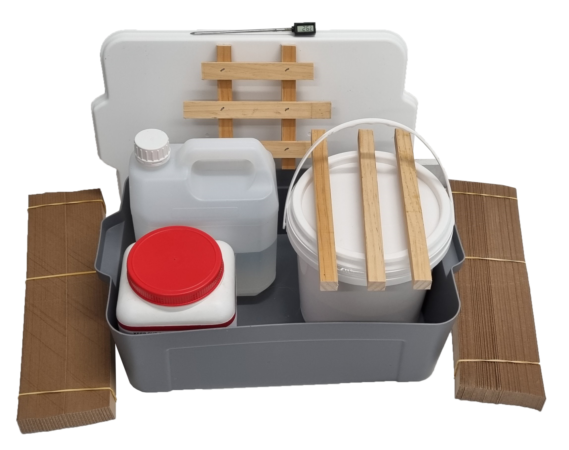
Fig. 12 This is a kit of the raw materials for making OAE strips, sold by Beequip.nz in New Zealand. Although a beekeeper is allowed to make them for their own use, selling a formulated product would require registration with New Zealand’s Environmental Protection Authority.
If EPA were to grant an Own Use Exemption, the Agency would be off the hook as far any safety responsibility or regulation of use of generic OA by beekeepers, and only be responsible for the registration and regulation of formulated products. This would be of huge benefit to beekeepers, since they would then be able to legally use inexpensive generic OA, and the State Lead Agencies would no longer need to turn a blind eye toward the practice. This could be a win-win for both the beekeeping industry and the EPA.
Unfortunately, in a recent meeting that I requested, EPA’s Office of Pesticide Programs was not open to granting us an Exemption. I’m not sure whether we’d get any traction by having our national organizations petition them. So I’m currently in discussion with some individual beekeepers about pursuing us becoming a Registrant in order to get the extended-release (in glycerin) application method approved, so that we could provide inexpensive “registered” OA, with the OAE application method on the label, to the beekeeping supply houses. Stay tuned — I may start a GoFundMe fundraiser to allow us beekeepers to legally pursue a solution to our “scofflaw problem.”
To be continued…
Citations and notes
[1] ShamWow is made of a blend of rayon and polypropylene. Rayon is a manufactured regenerated cellulose fiber. Polypropylene is a non-biodegradable plastic.
[2] Mann-Whitney one-tailed U-value is 119. The critical value of U at p < .05 is 102. Therefore, the result is not significant at p < .05. The z-score is 1.10566. The p-value is .1335. The result is not significant at p < .05.
[3] Nolan, WJ (1932) The development of package-bee colonies. USDA Technical Bulletin No. 309.
[4] Delaplane, K (1997) Practical science—research helping beekeepers 3. Varroa. Bee World 78(4): 155-164.
[5] Advertising and own use guidance for compounds for management of disease in beehives (mpi.govt.nz)
[6] Summary of the Federal Insecticide, Fungicide, and Rodenticide Act | US EPA
I’ve been speaking on a daily basis with one of the two beekeepers whose operations are infested, as well as others in the industry.
So far, over 1000 of their colonies have been euthanized, with many more planned to be burned. As you can imagine, this is very emotional for those beekeepers, who have also been prevented from selling their massive inventories of honey on hand.
The Department of Primary Industries appears to be doing a good job of “contact tracing”(epidemiological links) and so far, all detections have been linked to these two operations.
The key issue is to define the perimeter of how far mites have drifted from those infested colonies. My own tracking of marked bees indicates that there is considerable drift of bees from hive to hive to at least a half mile, and some to a mile. Not to mention that a bee carrying a mite can forage for several miles away from its hive, and perhaps bump into another uninfested bee on a flower.
The obvious questions are whether mites have gotten outside of the containment zone, or established in the feral population. If they are still limited to a small zone, there’s a feasible chance of eradication. The concern is that it is currently winter in Australia, and some of the infested hives had high enough mite counts that it’s obvious that they’ve had varroa since at least early last summer. This would have allowed time for considerable drift, perhaps into the hobby sector in Newcastle.
Those of us who have lived through the invasions of tracheal and varroa mites understand the futility of eradication if a mite is already well-established. The offspring of even a single female mite can relatively quickly spread throughout a continent, especially if aided by inadvertent human transportation.
For better detection screening, the DPI just received a large shipment of stickyboards from the U.S. (which I’ve made clear are more efficacious at detection than are alcohol washes). They are also working on getting registered colony treatments into the country. I hung out the past few days with one supplier in North America, whose phone was ringing off the hook for requests by Australian beekeeping supply houses.
When I was asked several years ago by the Department for recommendations for their incursion plans, I made the point that if they were not willing to take strong actions — including using fipronil bait stations to kill feral colonies — that their chances of eradication would be zero.
Although I have only had indirect communication with the DPI during this incursion, I am encouraged that they are indeed preparing to perform such baiting.
The commercial beekeepers in the country are well aware that the possibility of complete eradication are slim, but it’s clear that the agency, based upon lack of detections outside the containment zone, feels that they still have a fighting chance.
Since beekeepers will soon need to start moving colonies to pollinate the almond orchards, restrictions on movement will need to be put into place, to prevent the dispersion of varroa throughout the country. We all know that it only takes a single beekeeper to screw it up for an entire continent, so let’s cross our fingers that none do!
Aussie beekeepers have enjoyed having their honey and beeswax being miticide free. Suggestions have been made for treating all hives going to almond pollination with Apivar strips. There is of course pushback, since beekeepers don’t want residues in their hive products.
A big question is whether the strain of mites in the incursion are resistant to any miticides, so tests are being performed. If the introduced mites are “amitraz-naive” this might be a worthwhile consideration, since such treatment in my own amitraz-free operation can actually completely eliminate every mite from a colony.
If there are any Aussie beekeepers reading this, here are some suggestions:
- Keep a cool head. The DPI appears to be well informed, and doing a good job. I commend them for trying to act with transparency, and keeping the public informed. Beekeepers can help them by cooperating fully, especially since since there will be agents unfamiliar with bees.
- Since most Aussie beekeepers are completely unfamiliar with mites, they should view photos of mites in alcohol washes or on stickyboards, to train their eyes to recognize them. They are difficult for the untrained eye to spot, and you don’t want to miss a single one!
- Alcohol washes or sugar shakes of 300 bees can easily miss a low-level infestation. An “accelerated” stickyboard count, using formic acid, rapid-release amitraz, or even whole-colony sugar dusting, will have fewer false negatives.
- Although the chance of eradication of this incursion are slim, it is still possible, and well worth making the effort.
- Beekeepers who are required to have their colonies euthanized will be compensated, and should consider the sacrifice to be a heroic effort to save their industry. Australia will inevitably get infested by varroa, but the longer they can avoid it, the better for the beekeepers. Let’s all root for success in this containment and eradication of this incursion!
Extended-release oxalic acid for varroa management
Updated 6 June 2025
Legality of use
Understand that the EPA doesn’t give “approval to” any pesticide — it only grants registrations for applicants to distribute and sell specific formulated products for which the EPA has approved the label. That said, the EPA’s mandate for regulation comes from FIFRA [1], which is completely unclear about “own use” of a pesticide, as opposed to the production, distribution, or sale of a pesticide: ” The dilution by individuals of formulated pesticides for their own use and according to the directions on registered labels shall not of itself result in such individuals being included in the definition of ‘‘producer.” Furthermore, FIRA Section2(ee) TO USE ANY REGISTERED PESTICIDE IN A MANNER INCONSISTENT WITH ITS LABELING states: The term ‘‘to use any registered pesticide in a manner inconsistent with its labeling’’ means to use any registered pesticide in a manner not permitted by the labeling, except that the term shall not include (1) applying a pesticide at any dosage, concentration, or frequency less than that specified on the labeling unless the labeling specifically prohibits deviation from the specified dosage, concentration, or frequency, (2) applying a pesticide against any target pest not specified on the labeling if the application is to the crop, animal, or site specified on the labeling, unless the Administrator has required that the labeling specifically state that the pesticide may be used only for the pests specified on the labeling after the Administrator has determined that the use of the pesticide against other pests would cause an unreasonable adverse effect on the environment, (3) employing any method of application not prohibited by the labeling unless the labeling specifically states that the product may be applied only by the methods specified on the labeling.” (boldface mine).
The EPA has already registered two sources of oxalic acid (ApiBioxal and EZ-OX), and their labels do not prohibit mixing them with glycerin as an application method. I’m no attorney, but the above definitions from FIFRA indicate that a beekeeper could dilute either ApiBioxal or EZ-OX with glycerin when they apply it, so long as they did not exceed the allowed dose per hive. Since the approved label dose for VaroxSan is up to 56 g of oxalic acid dihydrate per 20 combs in the broodnest, that would suggest the EPA’s maximum allowed dose. However, EZ-OX is registered for only 4 g per double deep. so I’ll leave it at that.
The EPA is justifiably concerned about beekeepers contaminating their honey when they mix oxalic acid with other substances. Their 2024 Advisory states that “EPA considers any application of an unregistered pesticide for other than personal use to be a distribution of an unregistered pesticide and a violation of FIFRA.” And further ” An individual raising bees as a hobby and consuming themselves whatever honey is harvested might be considered “own personal use.” But as described above, an individual beekeeper cannot sell or distribute (which includes transportation) any unregistered pesticide and cannot sell or distribute any adulterated honey or other edible beehive products.”
The EPA attorneys danced around the subject of “personal use.” But according to the above, if you are not selling or distributing oxalic acid for pesticidal purposes to others, your own use in your own hives all boils to whether you are “adulterating” (contaminating) any honey for sale. So we need to understand how to interpret “adulteration.”
To continue from the Advisory: “Off-the-shelf products that contain active ingredients but are not registered may contain “other ingredients” or may be combined with other substances for which tolerances or exemptions have not been established. Honey that contains residues of a formulation comprised of multiple substances (e.g., an active ingredient and other ingredients) where those residues are not covered by a tolerance or exemption from the requirement of a tolerance, would be considered adulterated. The sale and distribution of adulterated honey would be a violation of the FFDCA.“
Again, I’m no attorney, but since both glycerin and cellulose are on the EPA’s Minimal Risk Inerts list [2], and thus exempt from a tolerance, so as long as you don’t include any other contaminates, it appears that although the EPA would place no restrictions upon one’s creating and applying their own uncontaminated oxalic/glycerin strips on an uncontaminated cellulose matrix to their own hives (but couldn’t sell them).
Note that the above applies only to the use of a registered source of the OA (we are working on trying to get EPA to put it on the Minimal Risk list). It wouldn’t count for use of generic oxalic acid.
Practical application: The advantage of making your own sponges or strips using EZ-OX (if bought in bulk) is that you could cook up a 50-g dose of strips or pads for about $3.00, compared to $12 for the same dose of VarroxSan.
Action item: We need beekeepers in every state to ask their State Lead Agency to allow them to formulate their own extended-release oxalic acid in glycerin strips, using either EZ-OX or generic 99.6% oxalic acid.
Disclaimer: I am not giving legal advice! Enforcement is up to your State Lead Agency, as is the decision whether they will allow you to use unregistered off-the-shelf OA for varroa control. I experiment with mite treatments under a Pesticide Research Authorization, and do not promote the use of any treatments restricted by your State. I have been researching OAE for some years now, always under a PRA, and am continuing to improve the method. The information below is only a “current report” on an application method that has to date shown the best efficacy and least adverse effects.
[1] The FEDERAL INSECTICIDE, FUNGICIDE, AND RODENTICIDE ACT
[2] Inert Ingredients Eligible for FIFRA 25(b) Pesticide Products
The Concept
Oxalic acid applied by dribble or vaporization is highly efficacious if a colony does not contain any sealed brood, but not so if there is brood present. By extending a slow release of OA on a pad or from hung strips, there is a brief drop of mites over the first few days, but then a slow reduction of the mite population over the next two months (we’re not completely clear on how it works). There is no buildup of OA in the hive, and it does not contaminate the honey. Although it can usually bring down high mite levels, it takes two months to do so. So it is best applied proactively in springtime or early summer. The purpose of the glycerin is to absorb moisture from the air within the cluster, which then dissolves and activates the OA in the matrix. Once a pad “goes dry,” it is no longer efficacious (if you touch a pad lightly with a dry fingertip, your fingertip should taste like you’ve touched lemon juice). Caution: do not perform more than 1000 taste tests per day, or you may exceed the amount of OA found in a serving of spinach).
Safety
Although oxalic acid is not as reactive as stronger mineral acids, it can still cause eye damage, and if left on the skin, tissue damage. Always wear safety glasses and waterproof gloves (we find 5 mil vinyl or even disposable restaurant gloves to be adequate) during preparation, and be careful to avoid splashing. Tip: when handling acids, rub dry baking soda on your hands before putting on gloves.
Always keep a jug of strong baking soda solution at hand! Mixed at the rate of 1 cup of baking soda per gallon of water.

After preparation or application, wash your hands and equipment with soap and warm water to remove any acid residues, or better yet, neutralize any acid on hands, hive tools, or smoker with the baking soda solution, which will immediately neutralize any acids.

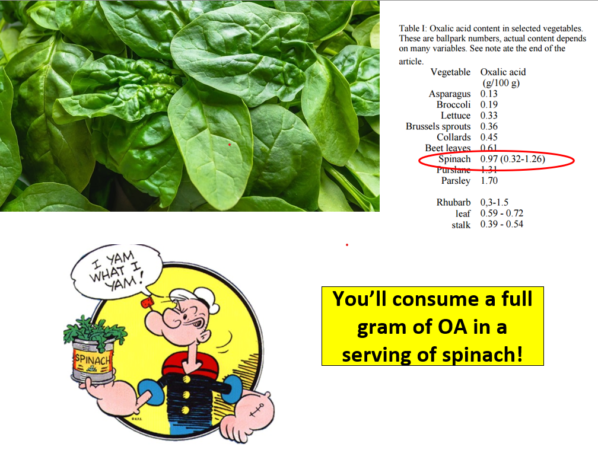
After preparation or use of oxalic acid, I always taste my fingers to see whether there are any acid residues on them. If there are, they will taste sour like lemonade. Wash or neutralize them before touching anything else (door handles, your eyes or nose, or taking a leak).
Dosage and delivery matrices
For extended-release application of oxalic acid, it can be dissolved into glycerin (I prefer soy rather than palm oil, since it does not involve the destruction of orangutan habitat), and applied to the hive by either laying pads across the top bars (if applied between two brood chambers), or by hanging strips over the top bars, extending down into the interspaces between the frames. The delivery strips or pads must be applied so that bees freely contact the surfaces.
Biodegradable cellulose matrices such as cardboard (chipboard), Swedish sponges, or cotton absorbent fabrics may be used (https://scientificbeekeeping.com/8466-2/). For full efficacy, roughly 55 – 60 square inches (365 cm2) of delivery matrix must be used if applied across the top bars, or 100 square inches (645 cm2) if hung between the frames. The instructions below are for moisturizer-free Swedish sponges, which hold 100 g of 1:1 (weight to weight) solution of oxalic acid dihydrate to glycerin. Other matrices, or different ratios of acid to glycerin, will require different preparation.

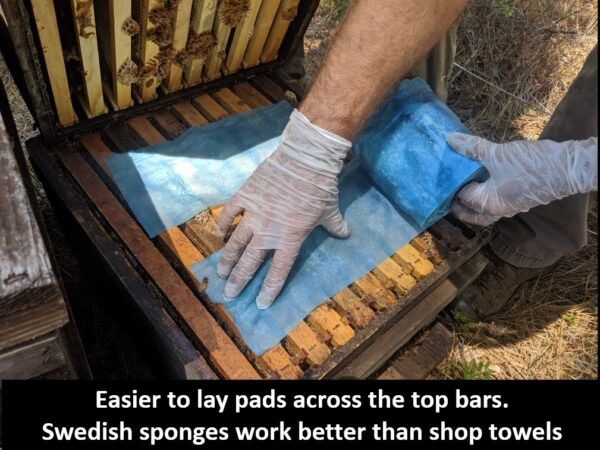
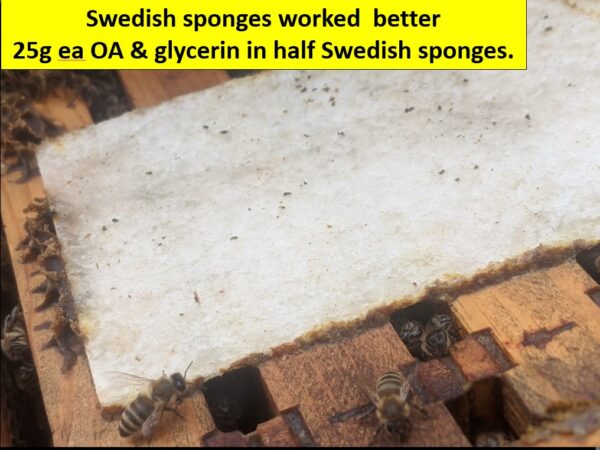
Preparation
For extended-release application, oxalic acid can be dissolved in glycerin, absorbed into any number of absorbent matrices. Field data suggest that for a double-deep hive, there should be roughly 60 square inches of matrix, holding roughly 100 g of 1:1 OA:glycerin (weight to weight), although other ratios may be used (our testing indicates that the 1:1 ratio gives better results than a higher glycerin ratio). Surprisingly , chipboard (cardboard) strips t hung over the top bars,require more total surface area for efficacy (at the recommended 8 strips for a double-deep broodnest, that would be 180 square inches — three times as much surface area! (Saturated chipboard laid flat requires more the 60 sq. in. for efficacy).
Preparation of sponges or Maximizer pads*
You should not put anything into a hive that is producing honey any product that may contain chemicals that could contaminate the honey. This also applies to the matrices uses for application of extended-release OA. For that reason, I favor biodegradable matrices that don’t contain plastics, and that are essentially food-grade, and on the EPA’s Minimal Risk Inerts list (which includes cellulose). I’ve tried a number of brands of Swedish sponges, was happy with the If You Care brand, so approached the company to give discounts for large orders by beekeepers. Contact Oliver Weiss <oliver@ossipee.biz> to buy packages of 500.
To prepare enough Swedish sponge pads to treat 10 full-sized colonies in double deep boxes (one full sponge per hive):
- First prepare the sponges by cutting them in half (into 3½” x 8” pads), each half of which will absorb 50 grams of the solution (50 g oxalic acid dose per hive).
- Wear safety glasses and waterproof gloves when preparing the solution. Have a neutralizing solution of 1 cup of baking soda dissolved in 1 gallon of water on hand, to neutralize any spills.
- Cut the Swedish sponges in half, so that you can apply two halves between the brood chambers, laid across the top bars, one towards the front of the hive and one to the rear (this leaves room for pollen sub in the middle, and avoids any syrup leakage from a top feeder can or jar.
- For each full sponge (two halves), mix 50g of oxalic acid (dihydrate) with 50 g of glycerin. Multiply this ratio for batches.
- For 10 hive treatments, prepare a batch of 20 sponge halves. Place 500g OA dihydrate into a stainless steel pan, then add 500g (400 mL) vegetable glycerin (add the glycerin second in order to avoid splashing of the solution).
- We particularly like using 7″W x 13″L x 4″deep restaurant steam table inserts (pans) over an induction plate. The photo below shows how 10 sponges cut lengthwise fit nicely on edge (to allow for even absorption) with plenty of room for expansion.
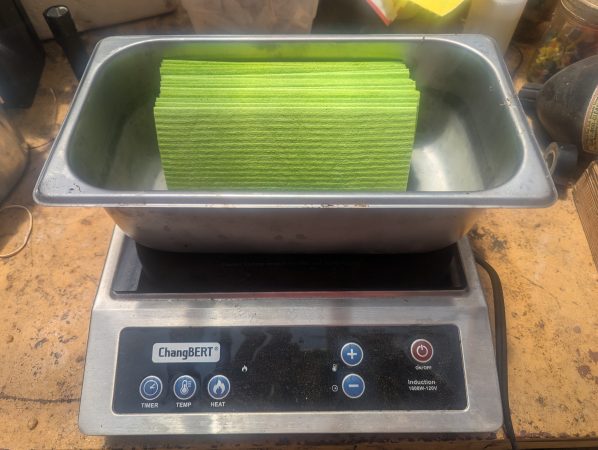
- Heat the ingredients while stirring, closely monitoring the temperature, not to exceed 160°F (70°C) (the acid crystals will dissolve at as low as 110°F, the solution will start to bubble if the temperature exceeds 170°F due to a chemical reaction for which it is unclear whether it is of benefit.).
- Continually stir gently until the acid crystals are completely dissolved (it is important to stir, since the oxalic crystals will melt and form a clear layer under the glycerin, which will float above, thus resulting in the oxalic acid overheating). Once the solution is completely clear, remove the pan from heat.
- While the solution is still hot, (A) add the pads on edge into the pan and allow them to absorb the solution, or (B) place the pads into a separate plastic container and slowly and carefully pour the still-hot solution over them. With either method, you may need to use tongs to carefully turn the pads over to obtain full absorption (which must take place before the solution cools). Be careful to avoid splashing of the solution! The hot solution will be absorbed rapidly, so long as the solution is hot. If you’re using an induction plate, set the temp for 160F during absorption, otherwise ou may need to reheat the pan, or as sugested by beekeeper Dave Gaetano, wrap the pan in insulation.
- Note if you are working in an area with high humidity: place an airtight cover over the the hot solution and the matrices to minimize absorption of moisture from the air, otherwise the glycerin will absorb considerable moisture. One maker suggests working in a dehumidified room.
- If all the solution does not absorb, the excess should be drained off before allowing the pads to completely cool.
- For easier handling, allow the pads to cool (sealed from the air if you are in high humidity) for at least a day before application. The oxalic acid will recrystallize during this time, and make the pads easier to handle and apply, with no dripping of solution.
- Storage: The pads can be stored in a labeled sealed container for up to 2 months, by which time the cellulose will slowly start to degrade. If exposed to of high humidity, the pads will absorb moisture and be much messier to apply. Once inserted within the cluster, they quickly absorb moisture and “wet up.”
- Checkbacks during the course of treatment: We spot-check regularly to make sure that the pads or sponges are moist on the surface, and if touched with the fingertip, have a strong sour taste. If they dry out and don’t pass the taste test, they are no longer active.
*Using maximizer lightweight pads
For commercial beekeepers, Maximizer pads are cheaper than sponges, and easier to scrape out at the end of their lives. We also like them, although they do contain a fire retardant salt of little concern. The company is working on offering a product without the retardant. Note: these pads contain a fire retardant. I can’t disclose what it is, but it’s not one that causes me concern, but it may be of concern to regulatory agencies.
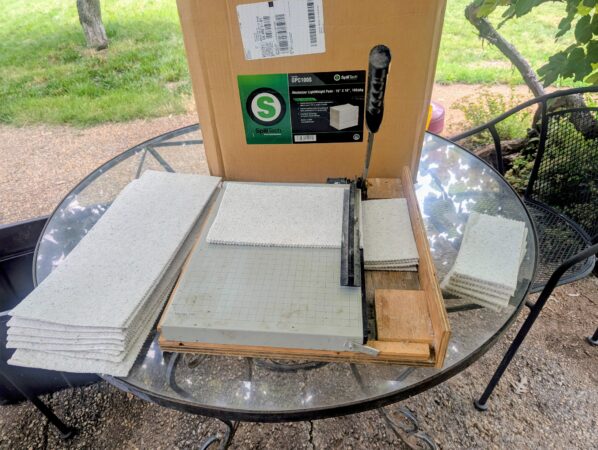
For cutting Maximizer pads, make a jig for a high-quality paper cutter with a hold-down arm. You get 5 pads per strip (10 per full sheet). We get ten 3.25″ x 7.375″ pads per Maximizer (lightweight, part number GPC 100S) sheet. We apply two pads per hive between the brood chambers.
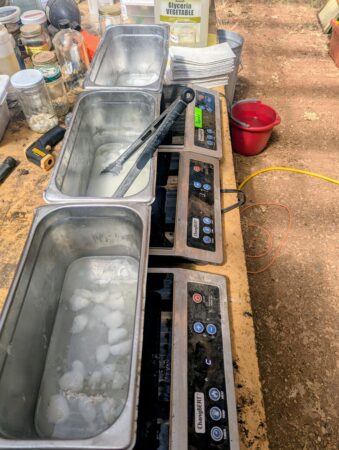
Using induction plates for preparing pads or sponges. I like the ChangBERT plates, since they have not only a heating setting, but you can also control the temperature of the pan once the OA has dissolved, setting it at 160F to keep the solution warm while you are allowing the pads to absorb it. We put 500g of OA and 400mL of glycerin into a stainless steel insert, heat to dissolve, then place 15 pads on edge into the pan to absorb the solution, flipping them once.
Preparation of chipboard strips
- Cut chipboard into 1.5” x 15” chipboard strips (each will absorb ~20 g of solution).
- For 500g OA:500 g glycerin, place fifty (50) 1.5” x 15”(6.35 x 38 cm) strips into the solution.
- Caution: The chipboard strips should not be bent when placing them in the solution, since they can spring and splash! Use a 6″ x 18″ stainless steel steam table pan as shown below

- Chipboard absorbs the solution more slowly than does Swedish sponge — allow it to absorb for hours or overnight.
Notes on crystallization
The 1:1 ratio is a supersaturated solution, and will crystallize at room temperature.
It’s OK to reheat it to dissolve the OA crystals.
It’s OK for the crystals to form on the pads (we actually prefer them that way).
Once the pads are placed within the cluster, the glycerin will absorb water from the atmosphere and the crystals will re-dissolve.
Sources for Swedish Sponges
I prefer to use Swedish sponges that are free of moisturizers or plastic mesh, and that are biodegradable in my compost pile.
If You Care brand fits the bill, and are readily available on Amazon. They are cheaper in orders of 500 or 1000; contact Paul Bliss <paul@blipservices.com>
Another company in Colorado sells seconds to beekeepers; go to https://swededishcloths.com/pages/bees
Other Matrices
I am continually experimenting with other matrices, limiting myself to biodegradeable ones without added chemicals. See 2023 Field Trial of Matrices and Formulations for Extended-Release Oxalic Acid
Application
- Optimal timing of this treatment in treatment rotation is to apply the pads into the brood chamber at time of placement of the honey supers. This treatment should only be used once while colonies are rearing brood, rotating with miticides with other modes of action, such as formic acid, thymol, amitraz, or fluvalinate. An oxalic dribble or vaporization can then be used during the winter brood break.
- Wear waterproof gloves.
- Using gloved hands or tongs, apply two pads between the brood chambers, placed so as to be within the cluster (avoid placing under a top feeder where syrup may spill, or directly against pollen substitute). Placement of the pads must allow for movement of the bees over both surfaces. The pads or cardboard strips can also be hung over the top bars, inserting them spread between the two brood chambers. For cardboard strips, 3-4 will be needed per brood chamber.
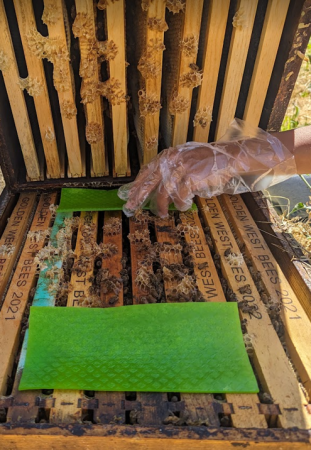
2022 Extended-Release Oxalic Update
Part 1
Randy Oliver
ScientificBeekeeping.com
First published in ABJ March 2022
As more and more beekeepers try to wean themselves off amitraz, there is great interest in oxalic acid. Unfortunately, a dose of OA by any of the currently-approved application methods exhibits little residual action, so has limited efficacy if a colony is rearing brood. However, as with other miticides sold in extended-release strips or formulations, oxalic can be applied in a similar manner.
REVIEW OF MY FINDINGS ON EXTENDED-RELEASE OXALIC ACID (OAE) TO DATE
My sons and I have experimented, by permit [[1]], with OAE for some time, testing a range of ratios of oxalic to glycerin, as well as with a variety of delivery matrices. So far, we’ve determined that:
- We like the handling characteristics and efficacy of the 1:1 (by weight) ratio.
- Swedish sponges make a great delivery matrix, but are pricey.
- OAE has the potential to take mite infestation rates down to zero, but it is a long-term treatment. It doesn’t cause as rapid a reduction of mite levels as do most other treatments (formic is the quickest). It requires about two months to exhibit full efficacy.
- Very importantly, due to its slow action, highest efficacy is attained in yards where there is little mite immigration.
- Its efficacy does not appear to be affected by temperature or humidity (since broodnest environment is regulated by the bees).
- It’s best applied proactively (early in the season), rather than reactively (waiting until the mite level gets high).
- It’s easy on the bees and brood.
- It’s not a worry as far as contamination of honey or the combs.
- Unfortunately, this application method is not yet approved by EPA, and I in no way encourage or endorse the use of it without a proper permit.
OAE HOLDS GREAT PROMISE
Although this application method of oxalic acid is not yet approved by our slow-moving EPA [[2]], it is clear to me that it is going to be a game changer for varroa management. My sons and I are impressed by how it has performed in our own authorized experiments. I also get reports from beekeepers in countries where it is approved or allowed [[3]], as well as from beekeepers elsewhere (Figure 1).
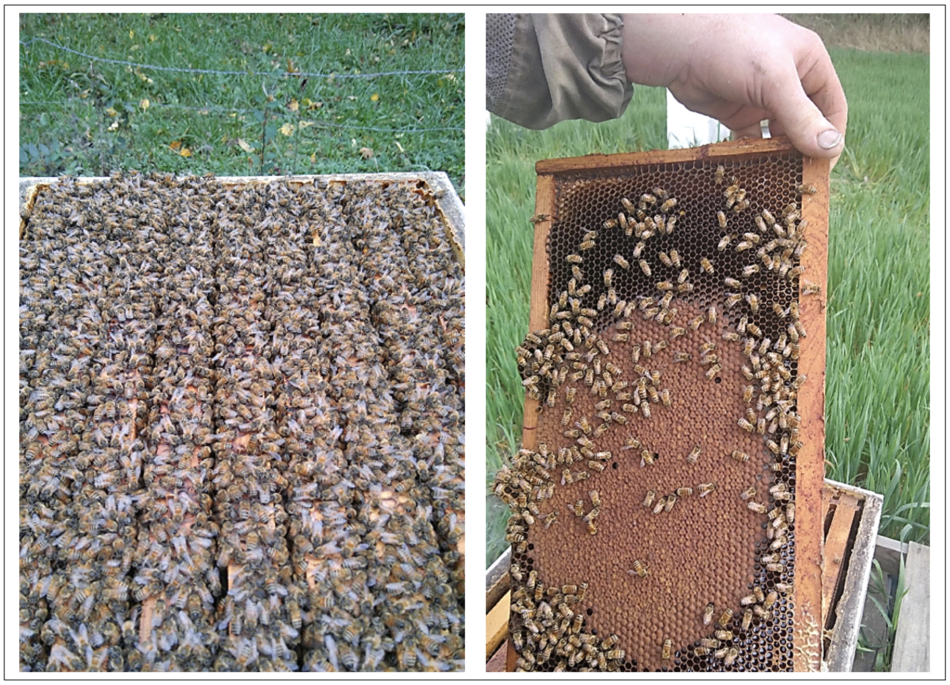
Fig. 1 Beekeepers from all over the world send me glowing reports on how well OAE can work. The photos above are from a professional East Coast beekeeper (whom I assume is permitted), who waxed poetic about how OAE treatment resulted in the strongest, healthiest, and most honey-productive colonies in memory, holding the mite levels in his busting colonies to low levels. His photos speak for themselves.
Practical application: I’m not trying to sell or promote this application method (especially since it’s not yet approved). It’s not a panacea, and is best used proactively. And as with other treatments, there are always outlier colonies in which mite levels somehow don’t respond, and the treatment may not be able to keep up with heavy mite immigration.
But because it would fit very well into our own commercial operation (since we eschew comb-contaminating synthetic miticides), my sons and I continue to perform permitted research not only for the benefit of the beekeeping industry, but also in own interest — and for that of our poor bees, who beg for relief from this parasite. In the long run, OAE may help us to stave off varroa until mite-resistant bees become widely available [[4]].
TESTING VARIOUS MATRICES
The concept of OAE is to provide sustained release — from an inert delivery matrix — of the oxalic acid onto the bees. Glycerin acts as the solvent and carrier of the acid, and also has the advantages of being inexpensive, food-grade, a humectant (which helps the acid to be effective), an adhesive (that helps the acid to stick to the bees), and has the added benefit of being distasteful to the bees (so they’re less likely to consume the acid). But what’s the best matrix to use?
I’ve scoured catalogs and stores for suitable absorbent sheets or pads (preferably biodegradable), and gotten suggestions from beekeepers everywhere. This spring I chose seven matrices to compare to the successful Swedish sponges (which work better than do the shop towels and cardboard that I’d previously experimented with).
I had purchased a number of different brands and shapes of cotton wipes and pads to try, and decided to use the Q-tips brand, since it had crimped edges. Because they happened to be round, for comparative testing I measured their surface area (4 in2), and cut rectangular strips of identical surface area from the other matrices.
I prepared six pads of each matrix, using a single batch of OA/gly solution, and then allowed them to come into equilibrium at a fixed temperature and humidity in an incubator. After weighing the pads, beekeepers Brion and Alice Dunbar helped me to haphazardly place one pad of each matrix into each of six hives (Fig. 2), and allowed the bees to walk over them for 20 days (7 April to 27 April).
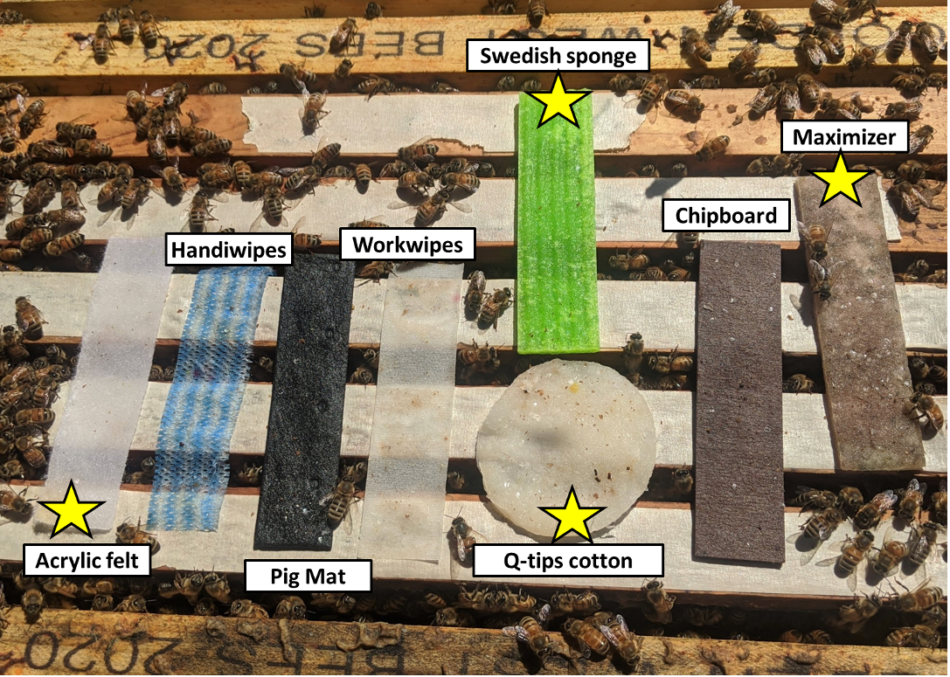
Fig. 2 In order to determine how well each matrix dispersed the OA/gly solution onto the bees, we covered the top bars of the lower brood chambers of six hives with masking tape to prevent absorption, and weighed the saturated strips before and after 20 days in the hive. The yellow-starred matrices looked to be the most promising.
We then collected the pads, again allowed them to come into equilibrium in the incubator, and reweighed them as a group in order to determine the average amount of weight lost per pad (Table 1).

Table 1. The tested matrices, ordered by weight loss. None lost as much as the sponges, but some were close. I’ve highlighted the most important cells.
Three of the matrices showed promise, due to their amount of absorption or release, as well as other characteristics (the lowest two had been removed by the bees). So I made up a batch of them, along with some sponges (Figure 3).
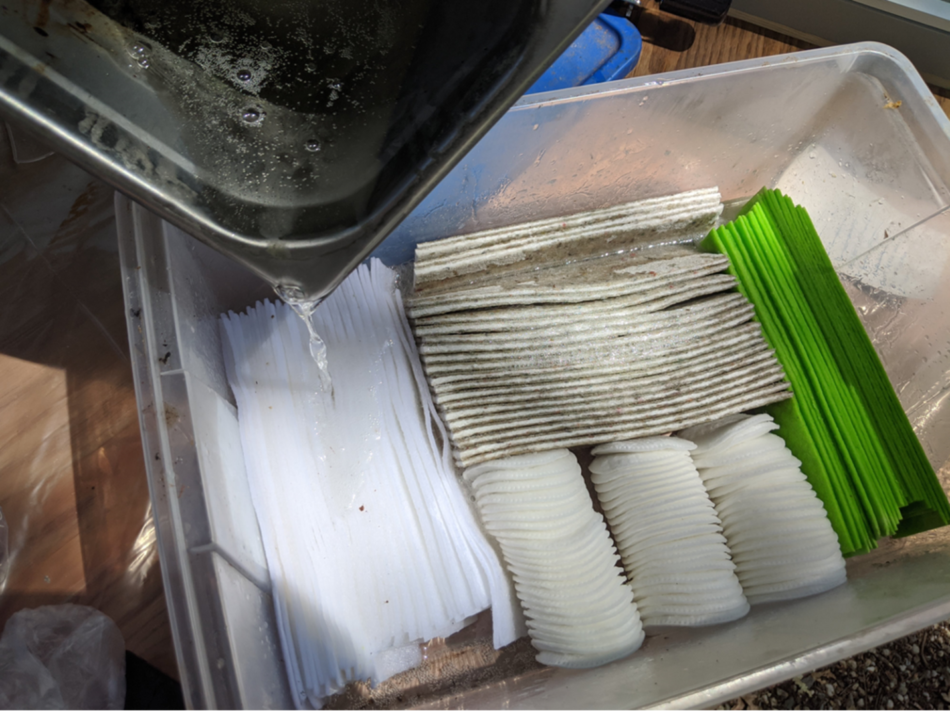
Fig. 3 I prepared the four matrices to be tested with the same batch of OA/gly solution at the 1:1 ratio. Tip: for full absorption, it’s important to give any matrix enough room to expand.
I then ran a quickie trial of the four, testing them by seeing how much they increased the rate of mite drop after application (in 2 colonies for each matrix, randomly blocked by starting mite count) (Figure 4).
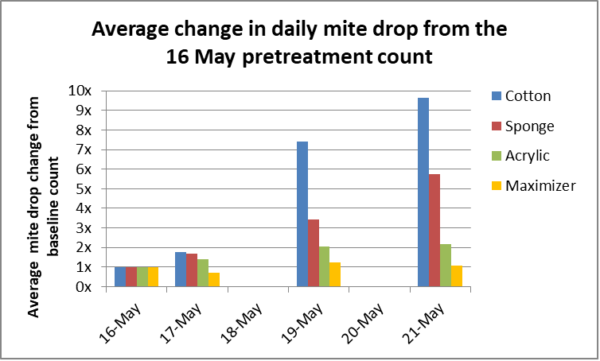
Fig. 4 In my preliminary trial of the four most promising matrices, I was unfortunately only able to track mite drops for five days (16-May was the pretreatment baseline count). The cotton pads caused by far the greatest short-term increase in mite drop.
Wow, cotton pads looked really promising! I had hoped that the bees might tug the saturated cotton fibers off, and drag them down through the colony (Figure 5).
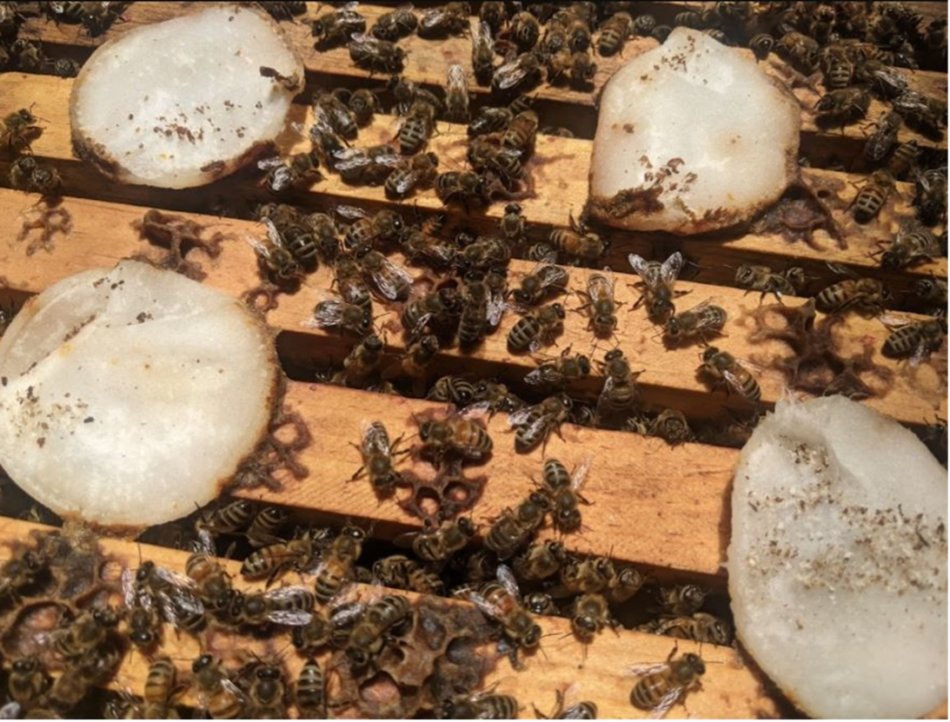
Fig. 5 The above photo was taken after the pads being in the hive 10 days. There didn’t appear to be the amount of tugging of the fibers that I’d hoped for. Note the slight propolization around the edges.
Unfortunately, the facial pads were difficult to separate after preparation, and would require 13 round pads to equal the surface area of a single Swedish sponge. So I didn’t follow up any more with them this season.
Practical application: Cotton in some form still remains a very promising candidate (I plan to try terrycloth or other absorbent fabric, and plastic-free feminine-hygiene pads). I also experimented with adding thymol to the pads, but it didn’t appear to improve performance. Properties to consider with any matrix are its handling characteristics, including preparation, field application, and ease of removal from the top bars after treatment.
SOME QUESTIONS TO ANSWER
As I reported last year [[5]], we had, in late spring and early summer, applied a quarter-sponge strip of OAE to a large number of colonies growing from nucs in experimental hives in several yards, and found that a minimal-dose treatment largely suppressed increase in mite wash counts for a few months. So we were curious as to whether such a low-dose treatment would prove to be efficacious in larger low-mite colonies. And based upon our preliminary experimentation with the alternative matrices above, I thought that we could run a single comparative field trial to answer three questions:
- How do Swedish sponges, Maximizer pads, or acrylic felt compare in efficacy at reducing mite loads?
- Is there a minimal surface area (as opposed to amount of OA) of OAE pads necessary to obtain good efficacy in double deeps?
- Can you dose with OAE proportional to the mite infestation rate? e., can you use fewer strips in a low-mite colony?
For experimentation, we had set aside a bunch of intentionally-untreated colonies with 2nd-year queens, grown from March and April nucs split from colonies returned from almond pollination, in four different yards. So in late May — as their mite infestation rates climbed — I thought up an experimental design to attempt to answer the questions above.
A LARGE-SCALE FIELD TRIAL
Last year we learned that one half-sponge reduced mite levels substantially, and two half-sponges exhibited very good efficacy. I figured that if we cut the pads into strips the same size as a quarter of a Swedish sponge, and then apply only a single strip to the lowest-mite hives, going up to 4 strips for the highest-mite ones, that we could perhaps fine-tune the optimal dose.
We started the trial by taking mite wash counts from all the hives in the yards on May 20-21, sorted them by starting mite level, and randomly assigned treatment types accordingly (Table 2).

Table 2. We unfortunately didn’t have many colonies with mite counts above 30, and in retrospect, I should have assigned the 4-strip treatment to more colonies in the 11-30 mite groups.
Scientific note: We randomly assigned the treatments, blocked by starting mite count. We didn’t run any negative Control (untreated) groups, since we were testing for comparative, rather than absolute efficacy (and it would have taken eight Control groups). If you look at the dates of all these experiments, you can see that we were performing experiments back-to-back in short order, rushing against the season and mite buildup. I had to make quick, on-the-spot decisions, and in retrospect sometimes wish that I had done something differently.
We applied the strips on May 26-27 (Figure 6). On June 30 we spot checked colonies for strip condition and mite wash counts. At that time point, the acrylic felt did not appear to be performing, so we removed those colonies from the trial.
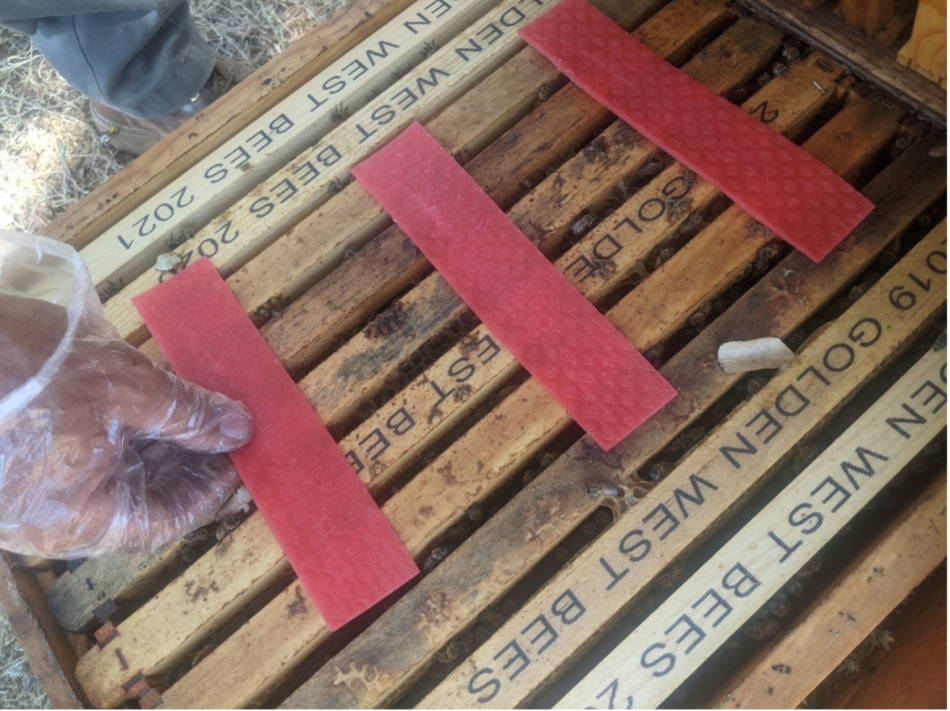
Fig. 6 According to the starting mite wash count, we applied from one to four 1¾ “ x 7½ ” strips per hive after smoking the bees off of the top bars.
On July 20 (after 55 days of treatment) we took ending mite wash counts.
RESULTS FOR THE SWEDISH SPONGES
The results are shown in Figures 7 and 8 — the more blue you see relative to red means the more efficacious the treatment.
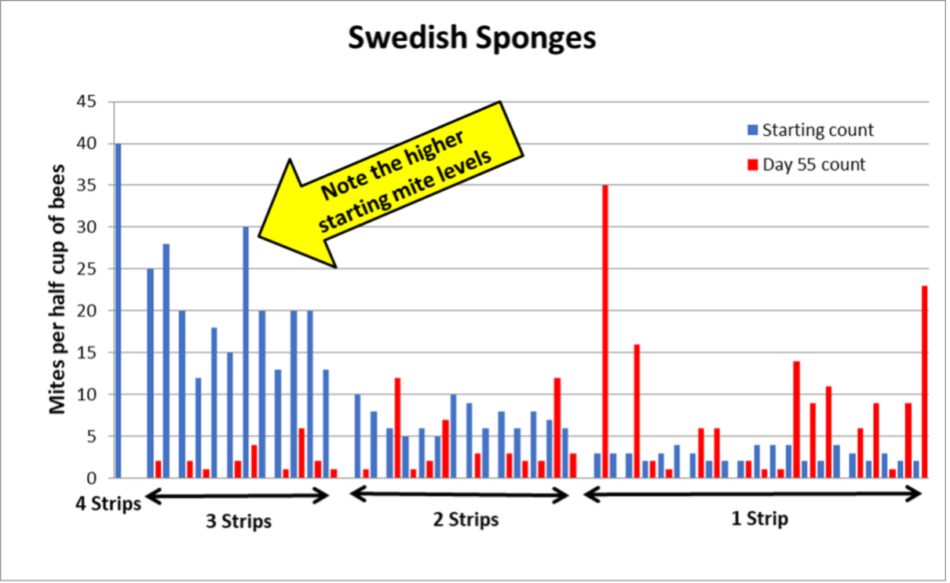
Fig. 7 Contrary to our observations the previous year, applying only a quarter sponge to low-mite colonies did not do the trick (too many had their infestation rates increase substantially). But similar to last year’s results, two strips (a half sponge equivalent) reduced the mites, and a full-sponge equivalent (4-strips) nailed it. Note that some of the highest-mite hives went to counts of zero.
Practical application: When I shared the results with my sons, it was clear that a 4-strip equivalent (two half-sponges) would now be our standard OAE treatment for full-strength colonies.
RESULTS FOR THE MAXIMIZER PADS
The results for the Maximizers were quite similar to those for the Sponges (Figure 8).
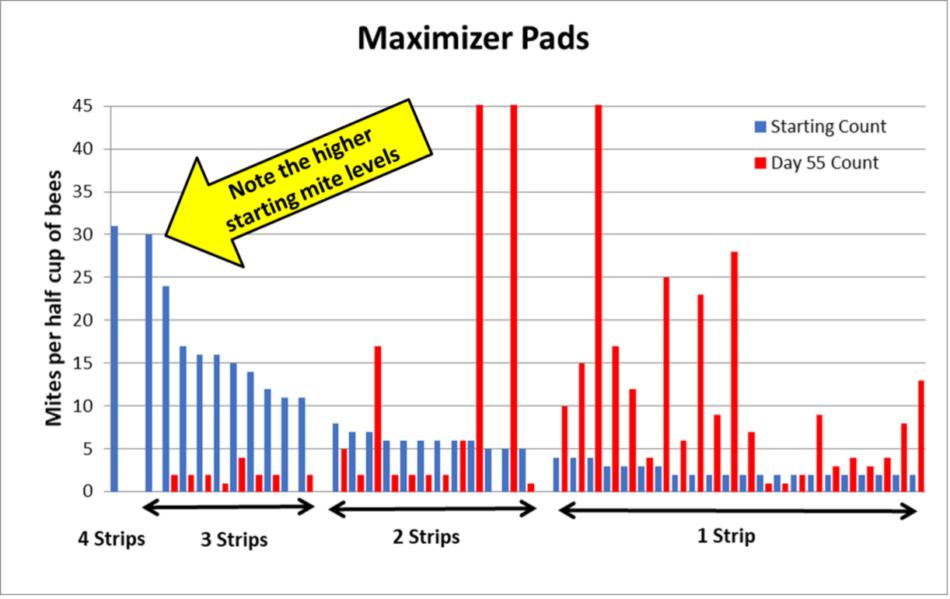
Fig. 8 It looks as though the Maximizers may be slightly less efficacious than the sponges at low dose. As with with the sponges, the 4-strip hive zeroed out.
Practical application: Once a colony’s virus infection gets too high due to having an elevated mite load, it may not be able to be saved by any treatment. I’ve been surprised that in our previous trials, virtually all high-mite colonies recovered if given an OAE treatment. In this trial, one of the two highest-mite 4-strip colonies for each matrix type did not make it, but the other one not only survived, but ended up with a mite count of zero!
MITE REDUCTION AND EFFICACY CALCULATIONS
Let’s take a look at the comparative effect of treating with either 1 or 3 strips of the two matrices. To do so, I simply totaled the mite counts for all the colonies in each treatment group at the start and end points (Figure 9).
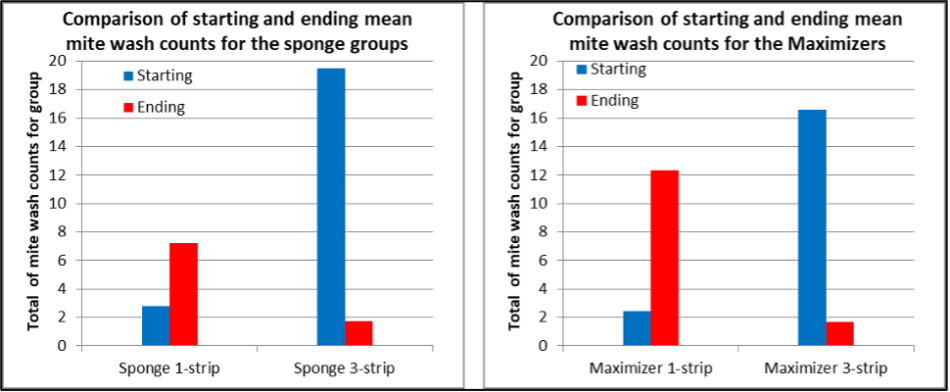
Fig. 9 Note that the 1-strip groups started with much lower mite levels, which went up, whereas the 3-strip groups started with much higher mite levels, which then went way down. The absolute reductions were 91% for the Sponges, 90% for the Maximizers. (n = 21 for 1-sponge, 12 for 3-sponge, 22 for 1-Maxi, 10 for 3-Maxi).
Those absolute reductions (as opposed to calculated efficacies) are pretty impressive in their own right, but don’t take into account the expected increase that could have been factored in had there been comparative data from legitimate controls.
To legitimately calculate efficacy of a treatment, the Test and Control groups would need to start at the same infestation rate. But a problem with testing varroa treatments is that with a high starting count, the Control colonies may succumb to the mite and virus load.
Unfortunately, one can’t just start the Control group with lower infestation rates than the Treatment group, since my previous data indicate that high-mite colonies tend to exhibit higher efficacy values than those for colonies with lower starting mite counts [[6]]. So I wondered whether that trend held over the range of starting mite counts for the 22 hives in the two 3-strip test groups combined together (Figure 10).
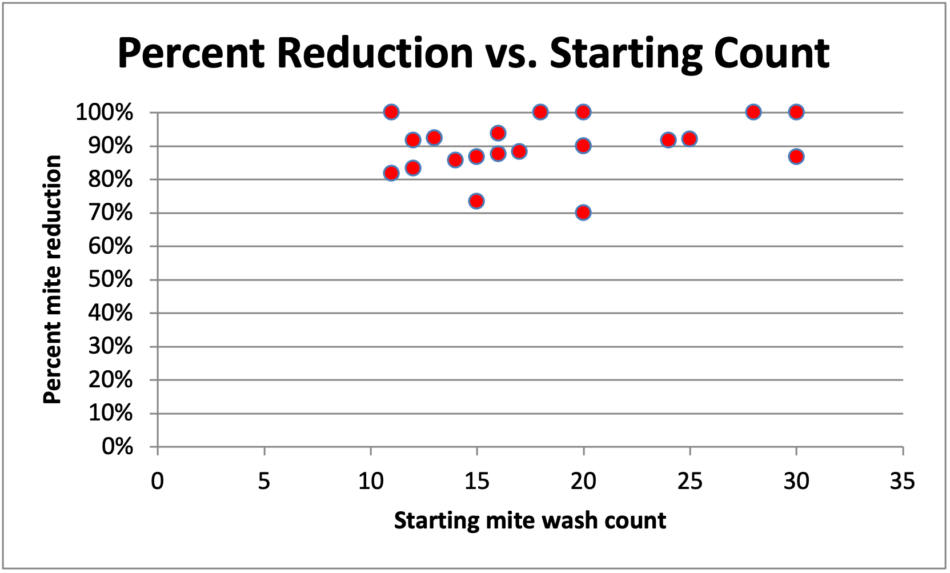
Fig. 10 Correlations between the starting counts and percent mite reduction from treatment for the 22 colonies in the two 3-strip groups combined. There was no apparent correlation.
In light of the above, and with the important caveat that any efficacy calculation for this trial cannot be considered legitimate (due to the Control group not starting at the same infestation rate), I feel that it is still informative to run the Henderson-Tilton calculation anyway, using the 1-strip applications as the “controls.” Doing so, the calculated efficacies are 97% for the Sponges, and 98% for the Maximizers!
Practical application: The 90% absolute reductions, and admittedly-questionable 97% efficacy values are what we were looking for. The much-cheaper Maximizers are looking pretty good!
TAKE HOMES:
- For full efficacy of OAE for mite control by using an absorbent matrix laid across the top bars between the brood chambers, it takes about 55 in2 of matrix holding 50 g of OA dissolved in 50 g of glycerin.
- We don’t yet know whether it helps to divide the matrix, but got good results last year with it divided into two pieces.
- Maximizer pads (Figure 11) are a lower-cost alternative to Swedish sponges, and are a bit easier to scrape off the top bars after treatment.
- We do know that strips can alternatively be draped over the top bars down between the combs with good results, but I have not done much research on this method of placement.
- My preliminary research, substantiated by recent work by Dan Aurell [[7]], indicates that Aluen CAP strips (10 g OA per strip), hung between the frames, requires more than 4 strips for equivalent efficacy in a double deep.
- Aluen CAP uses a 1:2.5 ratio of OA to glycerin; we like a 1:1 ratio; New Zealanders typically use an intermediate dilution.
- Higher-glycerin formulations (and perhaps cotton pads) release the OA more quickly, and can potentially cause short-term adverse effects.
- We’ve learned a lot so far, but need to continue our research!
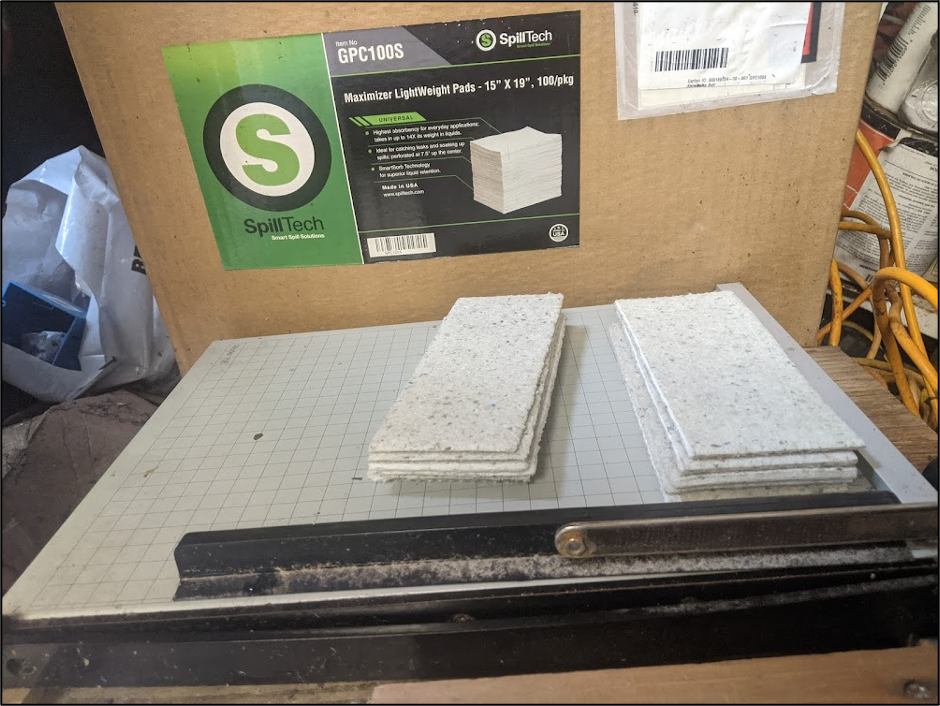
Fig. 11 A dedicated paper cutter with a built-in clamp allows for quick cutting of matrices. Here are ½-sponge equivalents of Maximizer lightweight pads, which are a readily-available alternative to Swedish sponges.
Update: This is only a report on my experimental trials. I do not make any recommendations, so please do not write me for such. The Spilltech Maximizer pads above (Item # GPC100S) contain a little bit of plastic fiber, and a flame retardant (that does not appear to be harmful to the bees). We tested the lightweight version, and will test the heavyweight version this year.
To be continued…
ACKNOWLEDGEMENTS
Thanks to Brion and Alice Dunbar, my sons and crew of Golden West Bees, and to all the beekeepers who have offered suggestions and observations.
CITATIONS AND NOTES
[1] Obtaining each year a Pesticide Research Authorization from the California Department of Pesticide Regulation.
[2] Me and a few other beekeepers had a meeting with EPA’s Office of Pesticide Programs as I wrote this article in January. I’ll write about it next month.
[3] New Zealand very reasonably has determined that beekeeper use of the organic acids for mite management poses scant risk to the public or environment, allows beekeepers to use them at their own discretion. More on this next month…
[4] More on this in an upcoming article. I just returned from one of our outyards, in which 50% of the colonies have exhibited strong mite resistance this season, and required no treatment at all.
[5] Mite Control While Honey is on the Hive: Part 3 – Scientific Beekeeping
[6] https://scientificbeekeeping.com/mite-control-while-honey-is-on-the-hive-part-2/
[7] Pers. comm. and presented at the 2022 ABRC.
An Online Model for Varroa Management
Randy Oliver and Trish Harness
First published in ABJ February 2022
Beekeepers worldwide have been using Randy’s Varroa Model with great success since its release in 2017. But there has been a demand for an online version that did not require Excel, and could be used on a cell phone. Trish started working on such an app in 2018, and now has it ready for release!
No single varroa management strategy is appropriate for every beekeeper, since we keep bees in dissimilar climates, with short or long brood breaks, diverse colony population dynamics, various treatment windows of opportunity, preferred mite treatments, and disparate goals and limitations (almond pollination, honey production, avoidance of comb-contaminating miticides or wish to use “organic”methods, labor costs, etc.).
For that reason, with no background whatsoever in modeling or spreadsheets, Randy painstakingly worked for over a year to create his open-source varroa management model, first publishing it in 2017 [[1]]. The logic for the model is laid out in Figure 1.
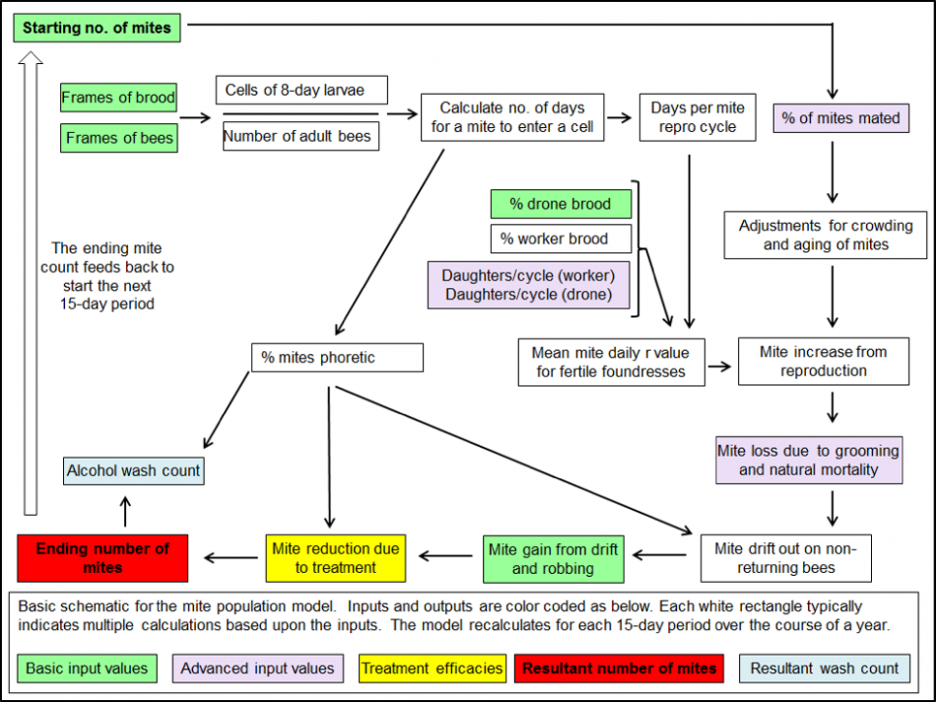
Fig. 1 The inputs for the model are details that can be measured or estimated by the beekeeper: the mite wash count, cluster size and amount of brood over the course of the season, the amount of mite immigration, and the expected efficacy of each treatment.
After inputting a few values for the above parameters, the model then indicates the expected impact of treatments, and allows a beekeeper to customize his or her management strategy (Figure 2).

Fig. 2 A beekeeper can run simulations of various management strategies with the goal of avoiding the red crash indicator — it doesn’t cost you anything to lose a colony on the computer! In this simulation, a 50% efficacious mite treatment in May (when high efficacy is tough to attain, due to the amount of mites in the brood), followed by an 80% efficacious treatment on the first of October, didn’t do the trick, and the colony would be expected to crash.
Note: Since there are far too many variables involved for any model to predict the degree of colony morbidity due to increasing virus transmission due to mite buildup, or colony performance with changing forage or weather, the model assumes that the infestation rate is kept to a low enough level to not change the expected colony structure. Thus, the “crash” indicator is only a rough approximation, and can be adjusted.
Randy encouraged, and fully expected, bee researchers or professional modelers to take his crude model and improve it, but it’s been mostly beekeepers themselves who have caught errors and offered suggestions. So over the years he’s updated it continually — the current iteration is Version 19, available for download at [[2]].
To those familiar with using Excel spreadsheets, this varroa model is simple to learn to use, and for those with a deeper understanding of varroa and honey bee biology and reproduction, is fully customizable for any bee stock or conditions anywhere in the world.
However, not every beekeeper has Excel on their computer (or even has a computer), or is comfortable with using spreadsheets, so some asked for a simpler version that they could download to their beloved cell phone. Not being a programmer himself, Randy put out the word for help…
TRISH STEPS UP TO THE PLATE
In 2018, beekeeper/computer science undergrad Trish Harness recruited an upper-level computer science class at Hiram College to collaborate on developing an online version of the varroa model. After the class term ended, she continued to work diligently on it herself, going through countless iterations over the years, bouncing ideas and prototypes back and forth between us. We’ve finally arrived at a version that we’re both happy with. All you need to do on your cell phone or laptop is to go to chickabuzz.com/model.html and type in a few input values. So let’s run a few simulations to show how to use it, starting with Figure 3.

Fig. 3 A screenshot of Trish’s model (on a cell phone, best viewed sideways), using the same inputs as for Fig. 2 (the blue cells indicate the inputted treatments). She also allows the user to choose which parameters they want to have shown in the chart — in this example, all are checked.
For Trish’s simplified app, she wanted to make the varroa infestation stand out. So the varroa population (red line) is shown at a 10x multiple (topping out at 5000 mites), and the mite wash count for a sample of a half cup of bees tops out at 45 (a 14% infestation rate). From a management standpoint, hitting either of the top-out limits indicates that immediate treatment is called for.
Compare the above results for the same simulation, but instead of only two treatments, the beekeeper checked the upper grey boxes to apply three moderately-efficacious (80% reduction) treatments in April, August and November (Figure 4).
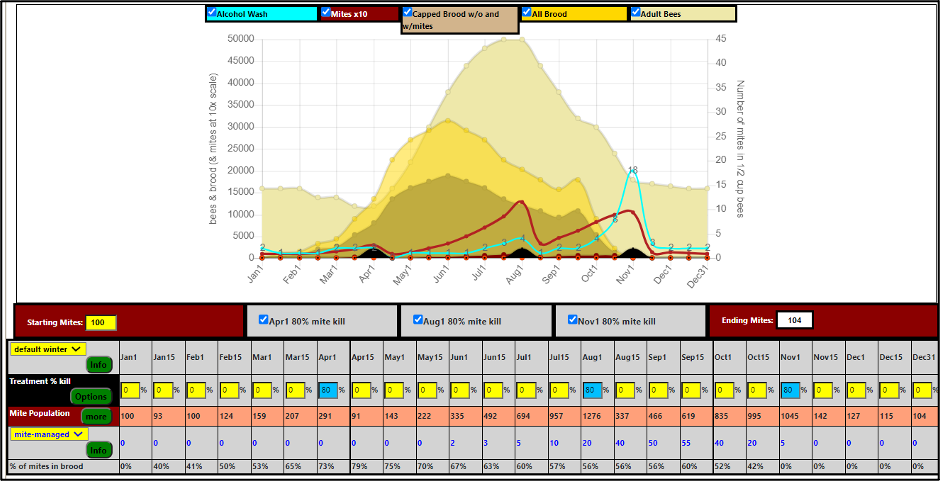
Fig. 4 Success — no crash! This treatment regimen prevented the mite population or brood infestation rate from climbing too high, and the colony would be expected to survive the winter. Note that this treatment regime would be sustainable, since the starting and ending mite counts (100 and 104) are essentially the same.
For another example, let’s show a simulation for a beekeeper who purchased a nuc in early April, with a starting varroa population of only 50 m ites (Figure 5).

Fig. 5 A starting wash of a half cup of bees from this nuc would typically detect zero mites. In this simulation, instead of indicating total brood, it’s clicked to show only the amount of sealed brood. The beekeeper applied a 50% efficacious treatment at the first of August, and then a 90% efficacious treatment on November 1st, as the last of the sealed brood was emerging.
If this happened to be the beekeeper’s first colony, they would be impressed by their low mite counts in April and December, but the colony may still have been suffering from a late-season Deformed Wing Virus infection due to its high mite level in October and November, and might not make it through the winter. And even if it did, it would begin the season with 157 mites — three times as many as it started with in the previous year. So this varroa management strategy would not be sustainable.
In the simulation below (Figure 6), the beekeeper proactively applied a formic acid treatment in March, and then applied 5 OAVs every 15 days starting in mid-August. The model indicates the expected proportion of the mites in the brood at any time (bottom row), which helps you to estimate the efficacy of various treatments. For example, a 30-second oxalic acid vaporization (OAV), using 1 g per brood chamber may only kill around 80% of the mites on the adult bees, and none under the cappings. So for the first application, since an estimated 56% of the mites would be in the brood, that would leave 44% out on the bees, for which an 80% kill rate would result in an overall reduction of the mite population of 35% (44% x 80% = 35%, the figure that the beekeeper would enter). For each subsequent OAV, the expected overall efficacy could again be estimated as shown.
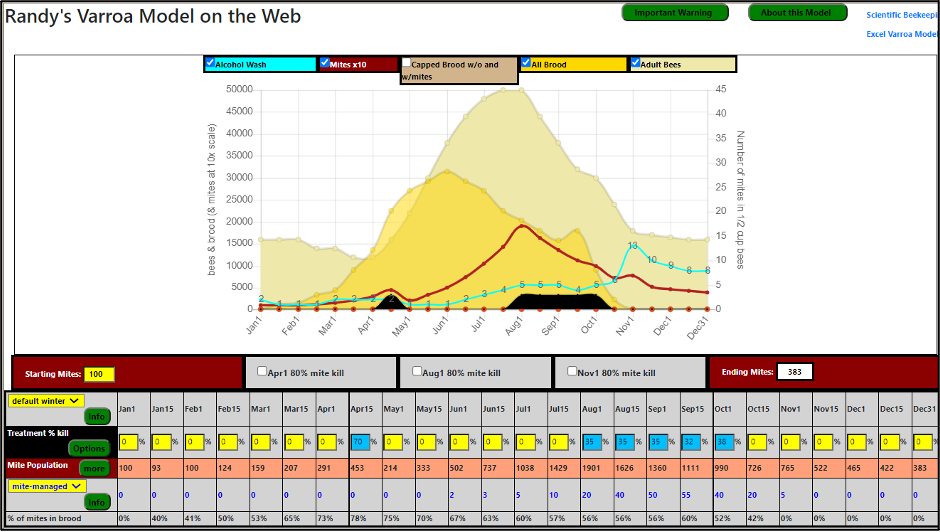
Fig. 6 By proactively hitting the mites in April (and perhaps suppressing the swarm impulse by the brood break induced by a formic treatment), the beekeeper got by with a series of late-summer low-efficacy OAVs while the colony still contained brood, taking it into the winter with a barely-acceptable infestation rate of 8 mites in a wash. But note that the ending mite population was nearly 4 times that of the start, which would spell trouble the next season.
Note: Randy’s been analyzing data sets from several beekeepers who have taken mite drop counts following repeated OAVs. It appears that repeated applications of 1 g per brood chamber, applied in a 30-second blast, although “safe” for the colony, may result in relatively low overall efficacy, even if repeated at 4-day intervals, especially if much mite immigration is taking place (there was moderate immigration in the above simulation). Indeed, mite wash counts might even give the impression of no efficacy (as recently observed by Berry [[3]]). Note that in the above simulation, the mite wash counts (the numbers on the blue line) over the course of 5 OAV applications did not change, despite reducing the total mite population by two-thirds.
For a last simulation, let’s switch to a Mediterranean California climate, with a nectar and pollen flow in September and October, and with a bit more mite immigration during late summer from surrounding neighbors’ hives (Figure 7).
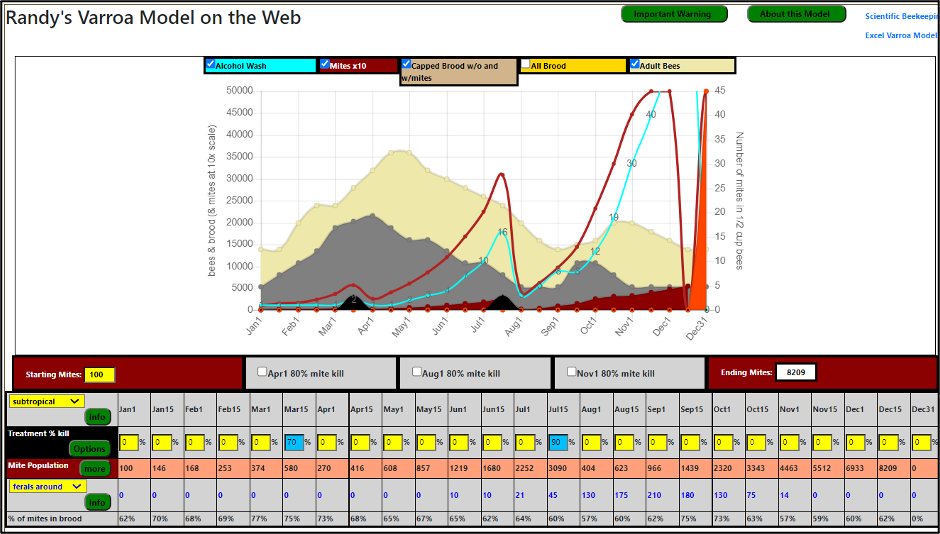
Fig. 7 This San Francisco beekeeper was also proactive by treating in mid-March, but got only 70% mite reduction due to the large amount of sealed brood. By mid-July, there was much less brood due to the summer dearth, and she obtained 90% efficacy with a double application of Apiguard (thymol). But then a new spike in broodrearing, coupled with troublesome mite immigration, allowed the mites to rebound. Notice how the proportion of brood cells infested by at least one mite (dark red area) built up to a point of no return by late November, causing all her bees to “disappear” while she was distracted by the holidays. What a bummer of a way to start the New Year!
By running simulations, one can start to better understand mite population dynamics, and response to various treatments.
USING MITE MODELS AS A REALITY CHECK
No model of a complex biological system can be perfect, but these simulations, based upon Randy’s experience in his own operation, as well as feedback from other beekeepers worldwide, indicates that they generally hit the mark. Randy continually checks the base model against data from others to confirm its accuracy.
The full model requires inputs of only:
- A starting mite infestation rate, estimated by working backwards from an actual mite wash count from a bee sample taken from a frame adjacent to brood at any time point,
- A choice of colony type (or customize for your location by inputting the number of frames covered with bees and amount of brood over the course of your season),
- An estimate of mite immigration (several options given, or customize).
- And any treatments applied (the models list expected efficacies of various treatments).
Trish’s model lacks some of the customization options, but can be used right in the field on your cell phone.
There’s no reason to be surprised by mites unexpectedly getting out of control in your hives. By running simulations, you can test out various mite management strategies for your colonies in advance, adjusting them for your available treatment windows, working around honey flows, and rotating different treatments to avoid breeding resistant mites.
Practical application: We’ve found that the most successful strategy is to deal with varroa proactivelyrather than reactively. Get ahead of the mites as early in the spring as possible, so that you go into the honey flow with an extremely low infestation rate, then harvest your honey as soon as you can after the flow, and knock the mites back before your colonies are producing their last rounds of brood before winter.
A NOTE FROM RANDY
Trish has worked hard and long to create this mobile version of my varroa model, and plans to continue to improve and update it (always check for the latest version). She doesn’t get paid for this, so if you find it to be useful, please send her a donation. Her website is Chickabuzz.com [[4]] and her online model can be accessed at chickabuzz.com/model.html
MORE INFORMATION AND DOWNLOADS
[1] https://scientificbeekeeping.com/the-varroa-problem-part-12/
[2] https://scientificbeekeeping.com/randys-varroa-model/
[3] Berry, Jennifer (2021) Multiple applications of vaporized oxalic acid. Bee Culture Dec. 2021: 70-73.
[4] Trish’s website: https://chickabuzz.com/
HOPGUARD 3 AS A SUMMER TREATMENT
Beekeeper-Funded Research
Randy Oliver, with collaboration by Aris Roberts
First published in ABJ February 2022
In the summer of 2020, I tested using Hopguard 3 to control varroa. Unfortunately, the label was not clear, and I didn’t realize that for summer treatment I was allowed to repeat the application of the strips. So I ran another test.
INTRODUCTION
If varroa starts to get ahead of you while your bees are putting on honey intended for harvest, there are only two currently-approved treatments to get the mites back under control — formic acid (MAQS or Formic Pro), or Hopguard. I’ve already shown my results for Formic Pro [[1]], and have discussed with Hopguard’s manufacturer suggestions for rewriting the label in order to make it more understandable.
The active ingredient of Hopguard — “potassium salts of hops beta acids” — is extracted (using liquified CO2) from the same type of hops flowers used to add the bitter flavor to beer. Preliminary investigations indicated that bees tolerate hops beta acids about six times better than can varroa [[2]], thus the development of this product as a food-grade “biopesticide” for controlling the mite.
Hopguard has gone through three iterations as a formulated product, each an improvement over the previous. The main limitation for Hopguard and Hopguard II was the brevity of its “residual activity” [[3], [4]], meaning that although it caused a quick kill of mites on the adult bees, its action tapered off within a few days (and thus would not affect the remaining mites in the brood as they emerged). The current iteration, Hopguard 3, is an improved formulation that extends the action for several days, and can be very efficacious if applied to colonies lacking brood [[5]]. It also appears to be gentler on the colony, as evidenced by fewer dead bees in front of the hives after application, compared to that from Hopguard II (personal observation).
However, during summer, when at least 50% of the varroa population is hidden under the cappings [[6]], Hopguard must be reapplied in order to obtain good efficacy. Gregorc, after testing it, concluded that three consecutive treatments would be required [[7]]. Luckily, the label allows for Hopguard 3 to be applied up to four times a year, and specifies applying consecutive treatments two weeks apart (although that interval could use further exploration, based upon the research previously cited).
In order to answer the optimal reapplication interval question, I ran a field trial beginning at the end of June. In addition, high-school student Aris Roberts volunteered to independently collect data on daily mite drops following August application of Hopguard 3 strips in his hives in Virginia. Although Aris’ data was collected secondly, it’s worthwhile to look at it first.
ARIS’ MITE DROP COUNTS
Aris painstakingly counted daily mite drop on the stickyboards of six hives every day for 37 days. After establishing baseline counts prior to treatment, he applied Hopguard 3 at the rate of 1 strip per 5 frames of bees, reapplying strips first after 7 days, and then after another 10 days (Figure 1).
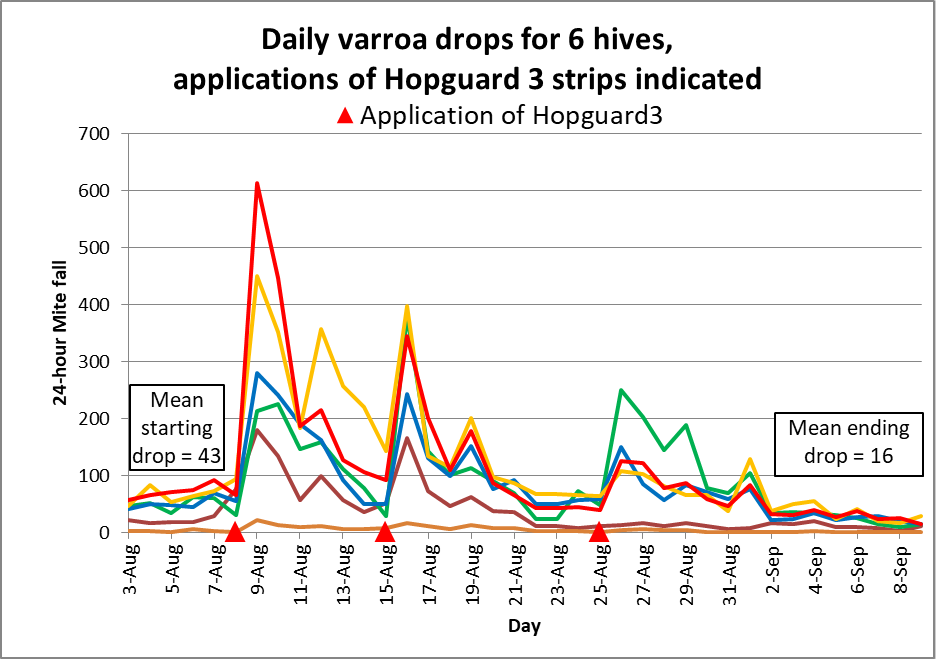
Fig. 1 There was an apparent wide range of varroa infestation rates of the monitored colonies, based upon their baseline and immediate post-treatment mite fall counts. Note how for even the highest-mite colonies, three treatments of Hopguard 3 brought daily mite drops down to low levels.
For better comparison, I summed up all the mite drop counts for the six hives each day, and compared them to the baseline count from the day before first application of Hopguard 3 (Figure 2).
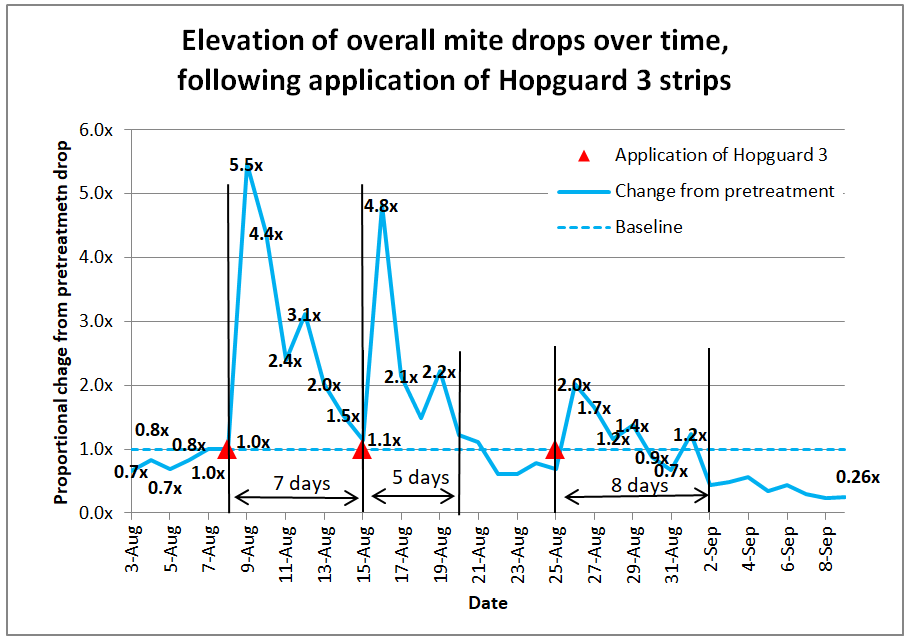
Fig. 2 By a month from the start, three repeated treatments with Hopguard 3 had steadily decreased daily mite drop down to a quarter of the baseline counts. In answer to the question of the residual activity of the strips, the effect appears to drop off by around 7 days. Data from Aris Roberts.
Practical application: Hopguard 3 may have extended the strips’ residual activity, but Aris’ data above suggests that it isn’t doing much after a week. So retreatment should be done within two weeks, in order to minimize the number of mites emerging from, and then reentering brood cells during the interim. Unfortunately, the above data were collected before I wrote the protocol for my own field test in California.
SUGGESTIONS FOR BEEKEEPERS WANTING TO DO RESEARCH
Aris shows us how even a teenage hobby beekeeper can collect very useful data of use to the beekeeping community. For more information on how you or a group can perform meaningful research yourselves, I’ve recently posted the slides for a presentation that I put together on how to perform bee research at [[8]]. I’m generally happy to help beekeepers with experimental design and protocols, and am willing to post good research by others at ScientificBeekeeping.com.
A FIELD TRIAL IN CALIFORNIA
Not yet knowing the optimal retreatment schedule for Hopguard 3, I consulted with Fabiana Ahumada, now at BetaTec Hop Products, who has been continually involved with the development of Hopguard since its early testing at the USDA Tucson Lab. We decided that I should test three applications at either 7- or 14-day intervals.
MATERIALS AND METHODS
I started the trial toward the end of the honey flow in late June, while there was still some incoming nectar and pollen. The weather was very hot and dry (Figure 3). Unfortunately, we had by that time controlled varroa in most of our yards, and the only colonies with mite levels high enough for collecting efficacy data were a group of untreated hives in my home yard, consisting mostly of “potential breeder queens” that had gone without mite treatment for over a year, but now had mite counts going up. I presciently wrote in my notes at the time that “the rate of mite increase in these colonies may be depressed relative to colonies that had not previously exhibited some degree of resistance to mite buildup.” As we’ll see, this concern turned out to be valid.
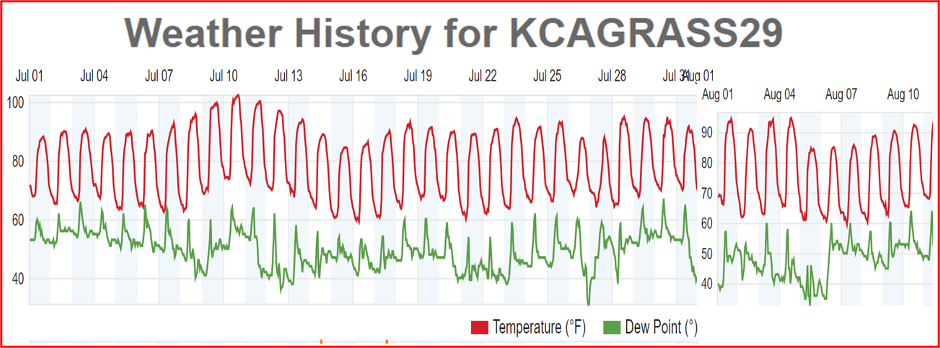
Fig. 3 The trial was run during hot weather in July and August, with daily highs typically in the 90s F.
All colonies were in double deeps, headed by 2nd-year queens. Colony strength ranged from 15-20 frames covered with bees (they had earlier been reduced in size to prevent swarming), all with brood in both boxes, and plenty of honey in the upper box.
We performed pretreatment mite washes on 27-28 June, taking level ½- cup samples of bees from frames adjacent to brood in the upper brood chamber, mechanically agitated them, and recorded the number of mites. I unfortunately could come up with only 18 hives with high enough mite counts to use for the trial. I assigned treatments in a randomized block design, blocked by starting mite count, with 7 hives in the weekly application group, 7 in the 14-day application group, and 4 hives with midrange counts [[9]] in the Control group. We took follow-up mite wash counts after one and two full bee brood cycles after first application of the strips, and again after 66 days, in order to determine the long-term effect of treatment. The experimental design is shown in Table 1.

We applied the first treatment to all hives the day after taking the first mite counts (Figure 4).
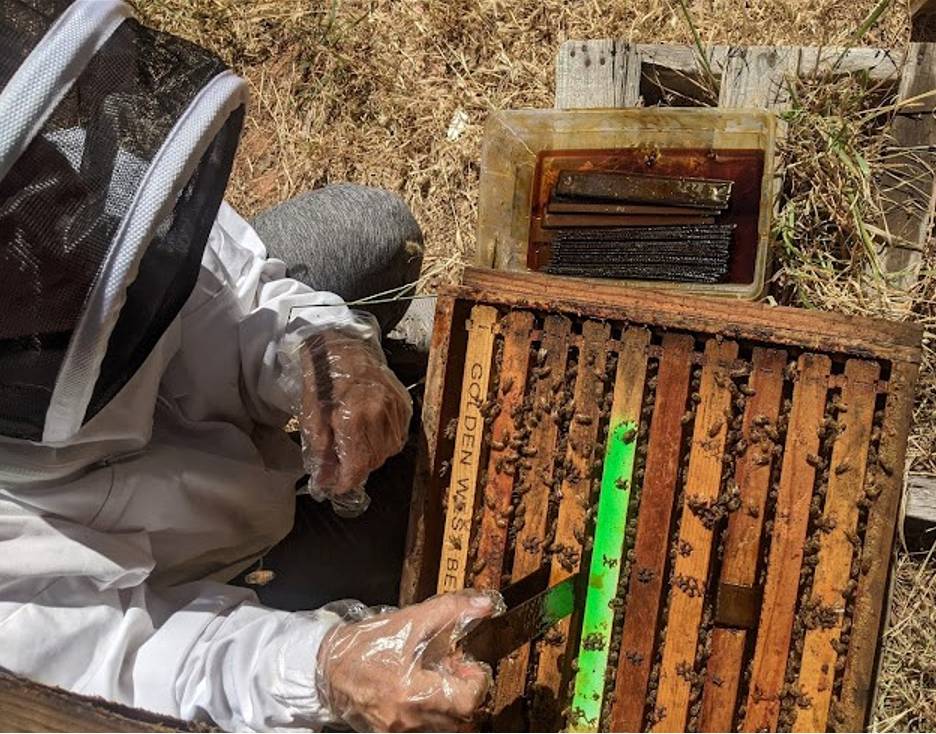
Fig. 4 Application of Hopguard 3 strips. We applied them (generously) as per label instructions of 1 strip per every 5 frames of bees. Most colonies got four strips, but the few with only 15-frame starting strength got only three. We removed the previous strips at each retreatment.
No mite treatment is completely harmless to the bees. The manufacturer cautions to smoke the top bars to cause the queen to move out of the way of a sticky strip as you insert it. If a bee gets rolled by a strip during the insertion process, we’ll find it dead on the landing board the next morning (Figure 5).
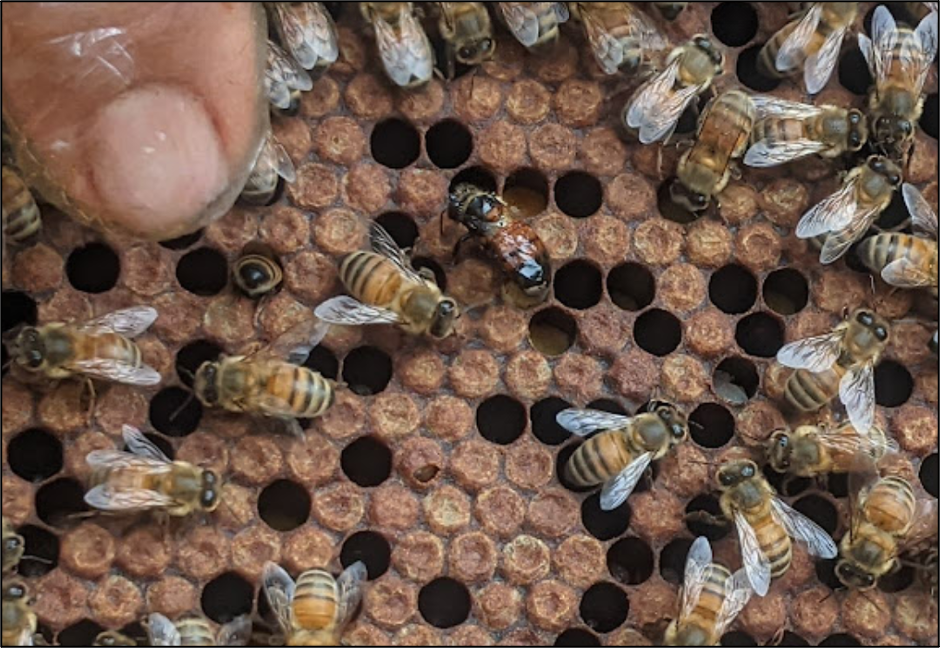
Fig. 5 The unfortunate wetted bee in the center of the photo will likely die from being rolled by an inserted strip. However, we’ve applied Hopguard to many hives, and have yet to see a queen get killed.
Application of Hopguard strips initially causes the bees to move broodrearing away from the strips (Figures 6 & 7).
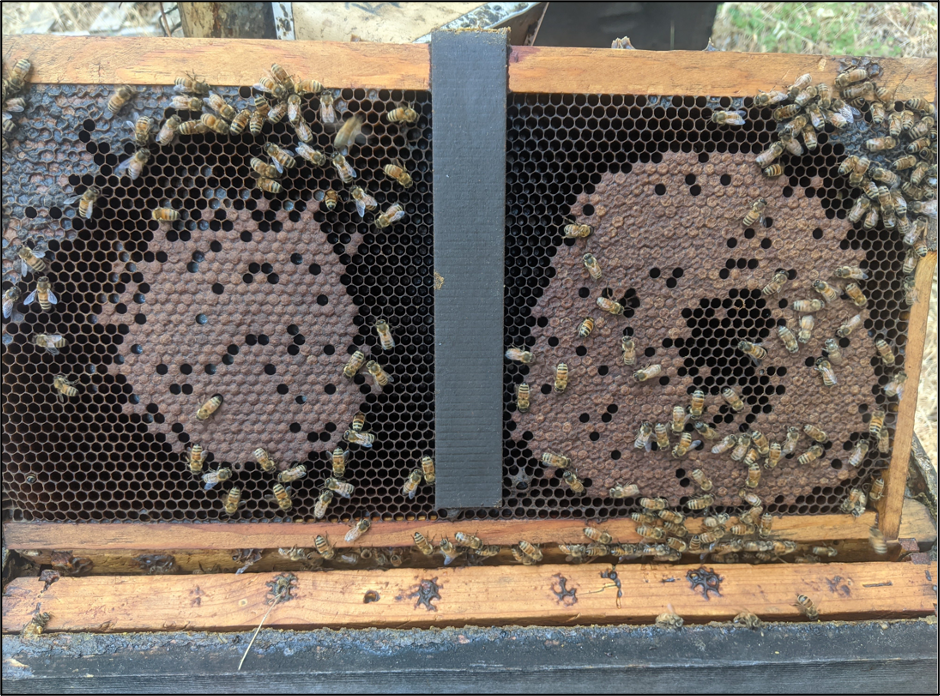
Fig. 6 Colonies tend to shift their brood rearing away from fresh strips.

Fig. 7 But after a couple of weeks, once the strips’ odor had dissipated, the bees will resume broodrearing under them, and eventually start chewing away at the strips to remove them.
I didn’t perform actual measurements, but my visual inspections indicated that there was more brood, especially open brood, in the Controls than in the treated colonies during treatment. This apparent suppression of broodrearing may help the treatment to work against varroa (similar to formic acid, thymol, and amitraz treatments, which also suppress brood rearing to some degree).
The honey flow began tapering off after starting the trial, so colony populations had already peaked. It was hard to tell, but there appeared to be an effect upon the cluster size from treatment. At the three-week assessments, the Control colonies covered all 20 frames in their hives, whereas the clusters in many of the treated colonies had shrunken somewhat. When I reapplied the Hopguard strips to the treated colonies, I often had to move the replacement strips inward to keep them within shrinking clusters (Figure 8).
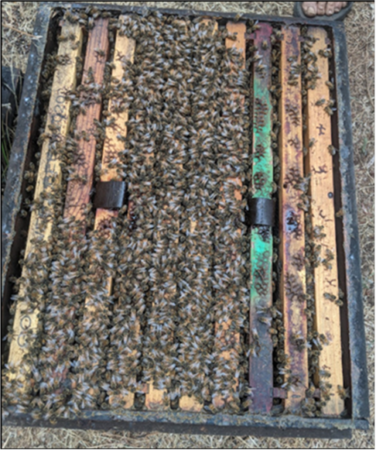
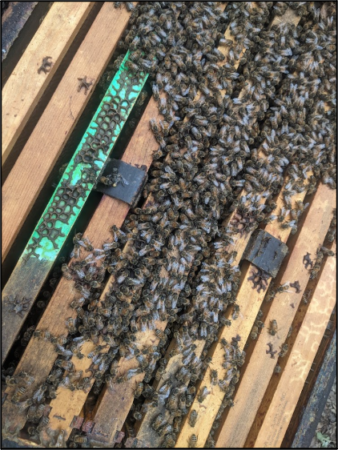
Fig. 8 The clusters tended to shrink a bit in the treated colonies. On the left is a typical colony immediately after application of the first treatment. In subsequent treatments (right), the clusters often no longer covered the strips. Despite this short-term effect, the colonies recovered quickly.
MY MISTAKE IN USING MITE-RESISTANT COLONIES
Let’s take a look at the mite wash counts for all the hives over the course of the trial (Figure 9).
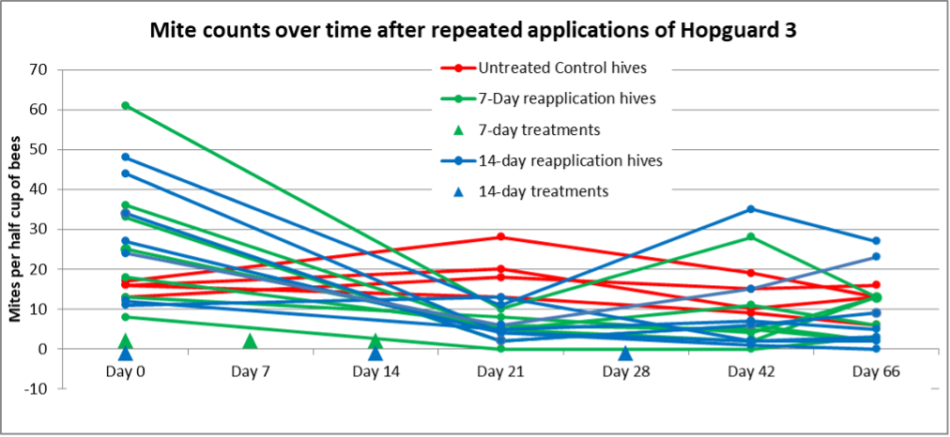
Fig. 9 Either application regimen reduced the infestation rate of the adult bees in both the short term or the long term. Three treatments with Hopguard 3 definitely knocked the mites back, but neither treatment zeroed out mite wash counts. But why the heck did mite counts also go down in the untreated Controls after that time?
Practical application: By two weeks after treatment, any mites that were originally hidden in the brood would have emerged, after which they generally spend a few days feeding on nurse bees before they reenter a brood cell in order to reproduce. The question then is, would retreatment at 7 days result in higher efficacy than at 14 days? To my surprise, it didn’t appear to make much difference.
It appears that it was a mistake for me to have used rejected potential breeder colonies (those that had mite counts increasing in their second season) for most of the hives in the trial, since all four Control hives eventually started to bring their counts down on their own (some exhibited strong uncapping and VSH behaviors; Figure 10). So this screwed up the expected increase of mite counts in the Control group, which prevented me from performing any meaningful efficacy calcs. Live and learn! This trial needs to be repeated using nothing but demonstrated non-resistant colonies.
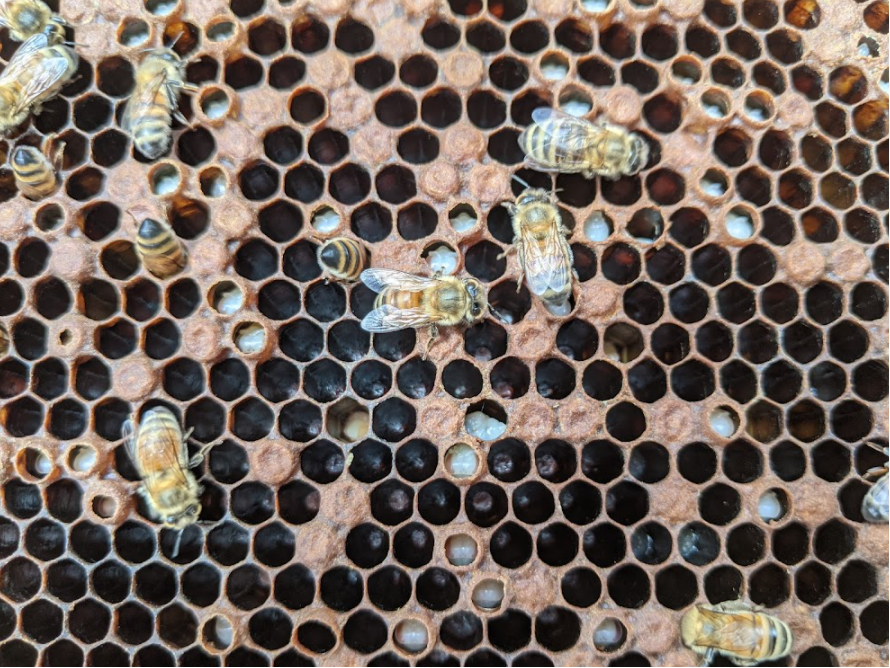
Fig. 10 Once their infestation rates got above a certain level, some of the Control colonies exhibited strong uncapping and/or “varroa sensitive hygiene” (VSH) behavior, which apparently was effective at reducing their infestation rates. I’ve seen other resistant colonies do the same — putting it into gear if varroa reaches a certain level.
Practical application: After five years of strong selection for mite resistance, roughly 10% of our colonies require no mite treatment whatsoever. When testing any miticide, I normally use high-mite colonies that obviously show no mite resistance. Unfortunately by the time I started this Hopguard trial, I’d already used up any high-mite colonies for other experiments, and thought that I could use some rejected potential breeders. In retrospect, that was not a good idea!
So perhaps the best interpretation of the data is to look at the percent changes in the average infestation rates for each treatment group over time (Figure 11).
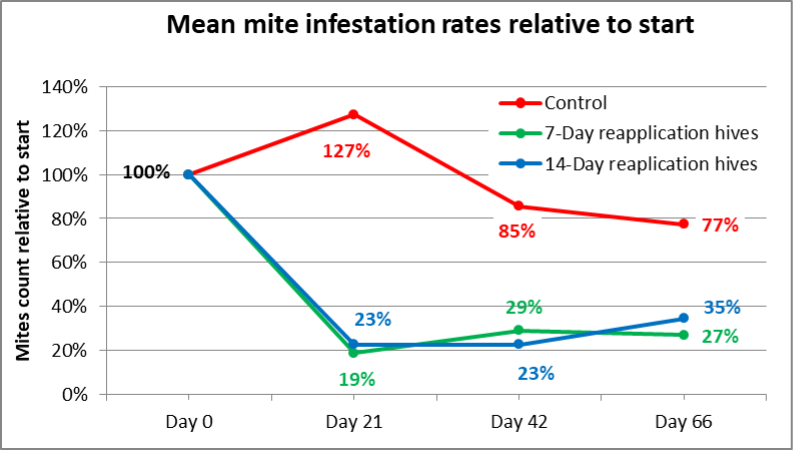
Fig. 11 So, what with the screwy Control group, can we salvage any meaningful information from this field trial? In this graph, I show the percentage of each group’s starting infestation rate (normalized to 100%) at each subsequent time point. At Day 21, by which point the count in the Control group had gone up by 27%, the Hopguard 3-treated groups had gone down by around 80% — not bad at all! [[10]]. Most tellingly, by the end of the trial at Day 66, the Hopguard-treated colonies still had mite infestation rates of around a third of what they started with. (Keep in mind that the trial wrapped up in early September, when mite counts generally rise substantially.)
THE TAKE-HOME
Although I was not able to calculate a legitimate figure for efficacy, I was impressed by Hopguard 3 for being a relatively-gentle mite treatment that could be used during hot weather without concern for queen loss or honey contamination.
Practical application: Similar to formic acid or oxalic dribble, Hopguard is fast-acting and highly efficacious on the “phoretic” mites on the adult bees, which is an important consideration when you want to reduce a high mite infestation rate quickly.
Based upon Aris’ findings that the strips are no longer much active after a week, the Day 66 infestation rates were taken a month to month-and-a-half after the treatments wore off, so the remaining mite populations would have had time to rebuild. These findings suggest that if you need to knock back varroa while you’ve got honey on the hive, two applications of Hopguard 3 two weeks apart provide pretty good control.
A single application of Hopguard 3 may be adequate if a colony is broodless (I’ve successfully used it myself at that time with good success), but it clearly takes at least two applications during the summer if a colony has an active broodnest. The overall efficacy from applying the strips every two weeks, rather than weekly, appeared to be about the same. This comes as a surprise to me, since I would have bet that the three weekly applications would have done a better job. So it looks like three applications might not be worth the cost or effort (it does take a bit of time to apply and remove the strips).
Practical application: Due to my mistake of using colonies with a degree of mite resistance, please do not consider this to be any sort of definitive trial of Hopguard 3. But based on this too-small and confounded test, I’d consider repeated treatment with Hopguard 3 to be a viable non-contaminating, food-grade, and “natural” “knockback” treatment for double-deeps while harvestable honey is on the hive. Since it appears to be relatively gentle on the colony, Hopguard 3 appears to be another valuable tool in our arsenal against varroa.
ACKNOWLEDGEMENTS
Thanks to Brion and Alice Dunbar for their assistance in my field trial.
CITATIONS AND NOTES
[1] https://scientificbeekeeping.com/mite-control-while-honey-is-on-the-hive-part-3/
[2] Rademacher, E., et al (2015). The development of HopGuard® as a winter treatment against Varroa destructor in colonies of Apis mellifera. Apidologie 46(6): 748-759.
[3] DeGrandi-Hoffman, G, et al (2012) The effects of beta acids from hops (Humulus lupulus) on mortality of Varroa destructor (Acari: Varroidae). Experimental and Applied Acarology 58(4): 407-421.
[4] Vandervalk, L, et al. (2014) New miticides for integrated pest management of Varroa destructor (Acari: Varroidae) in honey bee colonies on the Canadian prairies. Journal of economic entomology 107(6): 2030-2036.
[5] Nasr, M, et al (2014) An effective improved application method of HopGuard for varroa control in Canada. Available online.
[6] https://scientificbeekeeping.com/randys-varroa-model/
[7] Gregorc, A, et al. (2018). Toxicity of selected acaricides to honey bees (Apis mellifera) and varroa (Varroa destructor Anderson and Trueman) and their use in controlling varroa within honey bee colonies. Insects, 9(2), 55.
[8] https://scientificbeekeeping.com/tips-for-citizen-scientists/
[9] When testing for efficacy of varroa treatments, using mite washes as the metric, I’ve found that the percent mite reduction is usually substantially greater for higher-mite hives (https://scientificbeekeeping.com/mite-control-while-honey-is-on-the-hive-part-2/). This presents a problem if Control colonies are chosen randomly, since Controls that start with very high mite counts will often collapse prior to the end of the trial, but if you start with only low-mite Controls, they really can’t be considered to be legitimate controls. So for this trial, I used the four hives with mite counts in the middle as Controls.
[10] If I were trying to sell the product, I would have tossed any subsequent data, since I could have claimed 85% efficacy at that time point.
Observations on Pollen Subs: Part 4
Nectar, Water, and Humidity
First published in ABJ January 2022
Randy Oliver
ScientificBeekeeping.com
Last month I pointed out that there is something about even a light natural pollen flow that seems to increase a colony’s response to fed pollen sub. But a light pollen flow is often also accompanied by a light nectar flow — perhaps not enough to be noticeable by the beekeeper, but enough to affect the humidity within the broodnest. Could it be that the moisture from a nectar flow (independent of pollen) allows colonies to better utilize artificial diets?
In this series I’m still trying to figure out why I couldn’t get my test colonies to grow, despite non-stop feeding of pollen sub, often along with sugar syrup.
Doug Somerville, in his manual on bee nutrition, [[1]] observes that:
The loss of the stimulating impact of nectar will also equate to a reduction in the area of brood being cared for by the colony. The provision of nectar continues to keep the brood area “open” and population replacement at a high or expanding level. This stimulus can be artificially created by the provision of sugar syrup.
My test colonies all put on plenty of weight from the fed syrup, so they certainly weren’t lacking for sugar stimulation (the continually-fed patties were also half sugar). So could it be the water in nectar that is stimulating?
HUMIDITY & WATER
It was not only unusually hot during the experiment, but also drier (lower humidity) than “normal” (whatever that is nowadays). During the trial I assumed that we had provided the colonies with enough 1:1 sugar syrup to maintain broodnest humidity. But could difficulties in maintaining water homeostasis have been the reason that the relatively-small colonies didn’t expand their broodnests?
Water requirements of colonies
During conditions of hot weather, colonies require water for at least five reasons:
- To replace the water lost from the bees’ bodies during respiration.
- To dilute stored honey so that the bees can use it as an energy source.
- To perform evaporative cooling to prevent overheating of the hive.
- To maintain humidity in the broodnest to prevent desiccation of the eggs and young larvae.
- To allow nurse bees to produce the water-rich jelly (>70% moisture) necessary to feed the larvae
Inside the hive, broodnest humidities are typically held (based upon a scan of the sparse literature on this subject) between 40 and 70% RH, which is not surprising, since ripened honey comes into equilibrium with air at a relative humidity (RH) in the 50-60% range. At higher humidities, honey will absorb water and possibly ferment, at lower humidities water will slowly evaporate from the honey. Those combs of honey, however, appear to exhibit little actual buffering of the humidity between them, indicating that the bees actively regulate the humidity within the cluster [[2], [3]], likely primarily for the benefit of the desiccation-susceptible eggs and larvae. As far as the adult bees, Abou-Shaara [[4]] found that high temperatures coupled with low humidity reduce their longevity, so it’s not surprising that a colony would maintain a “comfortable” humidity in its home.
Experimentally, Harbo [[5]] found that the water requirement of clusters of around 1500 caged bees, kept at a constant 55% RH, increased tremendously as the temperature increased from 77-104°F, while their need for sugar plummeted.
Practical application: Harbo’s finding certainly indicates that worker bees require a lot more water at higher temperatures, but I’m surprised by his finding that sugar consumption decreased, since several studies have found that the resting metabolism of honey bees increases with high temperature [[6]].
It has been often noticed that colonies will desperately forage for water in winter if they are rearing brood [[7]]; this despite the fact that in cold weather they produce an excess of metabolic water in the process of burning honey for energy. Now couple that requirement for water with the need to cool and humidify the broodnest under hot/dry conditions. If there is a nectar flow on, the colony may obtain enough water from that source. But in many arid areas (such as my location in California), not only is there no rain during summer, but no appreciable nectar flow late in the season.
WATER FORAGING AND THERMAL STRESS
How bees forage for water, and use it to adapt to thermal stress, is a fascinating subject, which I’m only going to cover briefly. The short version is that colonies can get desperate for water, due to inability to forage, or to heat waves. When they do get thirsty, mid-age house bees start to beg “water collector” foragers for water. The water collectors then respond by rushing out and bringing water back to the hive [[8]]. Once in the hive, that water gets trophallactically passed between bees, and deposited inside cells surrounding the brood nest, as well as on the top bars of Langstroth hives [[9], [10]] (Figure 1).
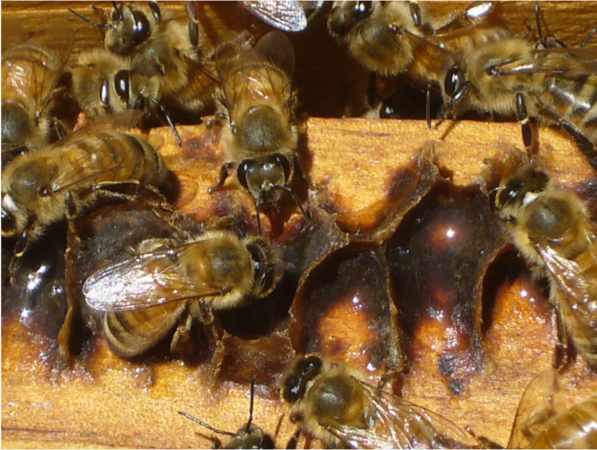
Fig. 1 A photo of the top bars in one of my hives on a hot day. It’s easy to see the glistening water in the burr comb, and to shake water, or very diluted nectar, out of combs.
A landmark study on how a colony uses water was published in 1955 by Martin Lindauer in, [[11]] who concluded that:
The activities necessary to regulate the temperature on overheating are carried out according to the principle of division of labour. There are separate groups of bees for carrying water, for receiving and distributing it in the hive, for spreading it, for working it with their tongues, and for fanning. The individual groups work in harmony together; a direct relationship between overheating and the activity of the water carriers has been established.
Lindauer observed that water foraging increased when a colony was rearing brood, and also found that the same bees that foraged for water for brood rearing were those that brought back water for cooling the hive.
Then in 1997 Susanne Kühnholz and Dr. Tom Seeley followed up with a study [[12]] on how a colony delegates the task of water reception (from the water foragers) to mid-age bees, and confirmed Lindauer’s suggestion they were the ones who controlled the amount of water foraging by how eagerly they beg for or refuse water offered by returning foragers. The water receivers then transport the water inside the hive, sharing it with mid-aged workers or smearing it on the walls of cells.
Allow me to quote from the paper:
Apparently, a colony adjusts the number of water receivers by means of bees switching to water reception from both nectar reception and other tasks, in accordance with the colony’s water need … The results of this experiment show that when we heated the observation hive, the colony strongly increased its water collection but did not decrease its nectar collection. These results also show that our focal nectar collector did not experience greater difficulty in unloading a concentrated sugar solution when the colony boosted its intake of water, and as a result was not at all discouraged from collecting a rich sugar solution throughout the period of severe heat stress.This supports the idea that a colony can raise its water collection without simultaneously lowering its nectar collection. [Boldface mine]
As the colony’s need for water increased, the bees that had previously worked as water collectors were increasingly begged for fluid by their nestmates. This result suggests that being begged more often stimulates the inactive water collectors to resume their water collection work.
Dr. Seeley followed up on this research with Madeleine Ostwald and Michael Smith in 2016 [[13]], confirming that hive bees stored water not only in their crops, but also in the combs near where water collectors returned from their flights.
Curious about how the Arabian bee deals with water, I corresponded with Dr. Abdulaziz Alqarni, who mentioned three observations by beekeepers in Saudi Arabia:
- The native honey bee (m. jemenitica), collects water during hot noon times while European bees don’t.
- Jemenitica place more water drops on top of the frames than do Europeans.
- They also place small water droplets in the area between the brood cells.
Surprisingly, Abou-Shaara [[14]] found that his colonies in Saudi Arabia ignored a dish of water with floats placed next to the combs.
COLONY REQUIREMENT AND DISTRIBUTION OF WATER
Standifer [[15]] found that in Arizona, where they controlled the water source for an apiary, that after accounting for evaporation, that weekly average consumption of water by a colony was in the 5-9 liter range (roughly a liter a day), whereas during winter it was around a liter a week.
Practical question: The above observations made me curious as to whether I might encourage brood rearing during hot, dry weather by offering colonies water inside the hive.
So I ran a small experiment with three colonies, placing an empty box on top, and offering the bees a choice between heavy syrup (77% sugar) or fresh water, during a July heat wave, in which daily highs reached 105°F (Figures 2 & 3).
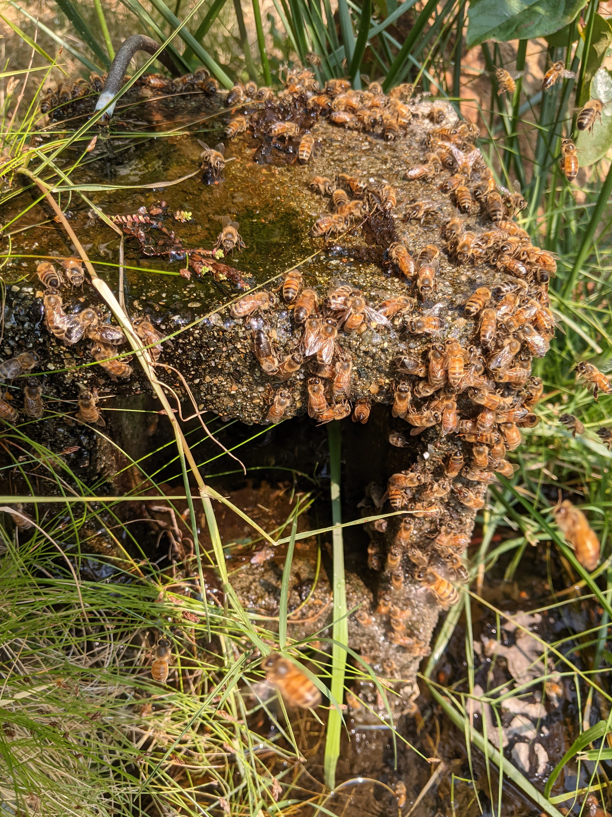
Fig. 2 There were plenty of foragers eagerly collecting water during the experiment. I have a few dedicated bee water sources at my home yard (this one with water dripping onto a cinder block). On hot days there are freeways of water foragers between the hives and the water sources.
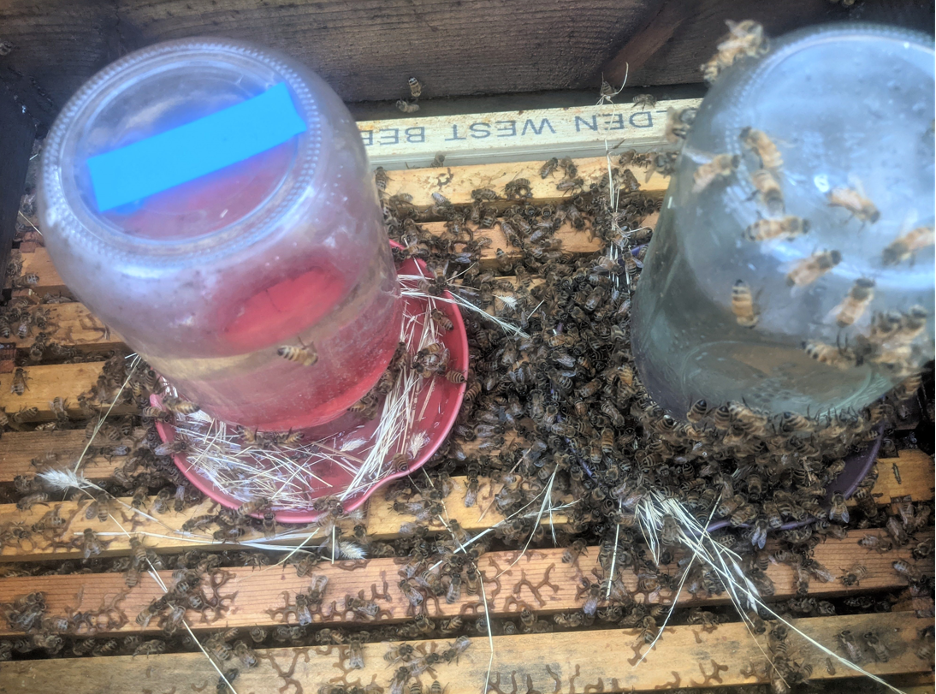
Fig. 3 In this experiment I gave the bees a choice between plain water (left) and 77% sugar solution (right), placed on the top bars (surrounded by an empty hive body and cover). I refilled the jars in the morning (so the bees would be already trained to their location, and took this photo in late morning as the colonies started fanning loudly at the entrances as they desperately tried to cool their hives. By that time there was a column of water foragers beelining to a nearby pond.
Similar to Kühnholz’s observations (and to my great surprise), despite the heat and dryness, the bees took the heavy syrup more rapidly than water every time. However, they did eventually take the water too, although there was never a ring of bees around the trough with their proboscises in the water. They consumed an average of 2/3 quart of water a day (after accounting for evaporation from the trough) — similar to the amount consumed in Arizona.
Practical question: The lack of interest is such a readily-available water source (similar to Abou-Shaara’s observations) made me wonder whether I was missing something — did the colony treat water offered in a feeder differently than water brought back by water collectors? How could I tell where they placed the syrup or water taken being fed at the top of the hive?
So I ran a second experiment, offering a single-deep colony, again in hot, dry weather, with two dishes each of two choices of liquid — one heavy syrup (tinted with red food coloring), the other plain water (tinted blue). Then I waited a few hours (at which point all liquid had been taken) and pulled each and every frame to see whether and where the bees had placed either liquid. I used dozens of Q-tips to look for colored liquid by inserting them into cells throughout each comb (Figure 4).
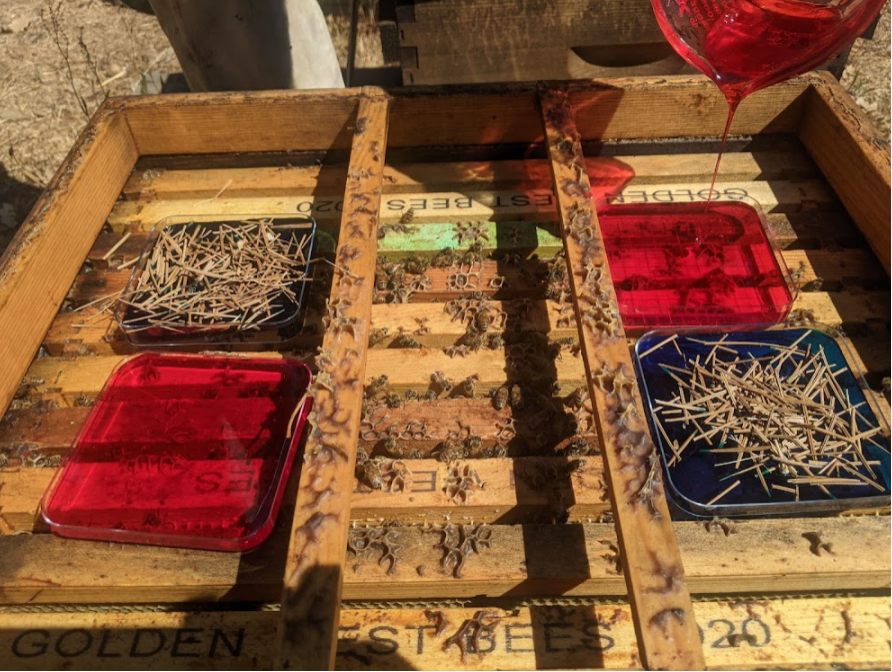
Fig. 4 In this photo I’m pouring the red-tinted heavy syrup into a dish. I would then sprinkle pieces of pine needles, as shown in the dishes of blue-tinted plain water, to prevent drowning. I then replaced the hive cover over the 1.5” rim, and let the bees suck the trays dry.
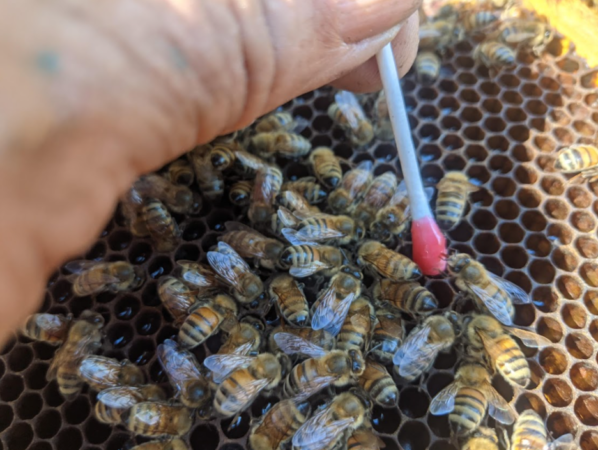
Fig. 5 The above is typical of how a Q-tip looked as I withdrew it from a cell containing stored red-tinted syrup. The method clearly differentiated between red syrup and blue water, and worked very well for a quick assessment of the distribution of either liquid in the hive. Very few Q-tips showed blue water, likely because the water had already evaporated or been consumed.
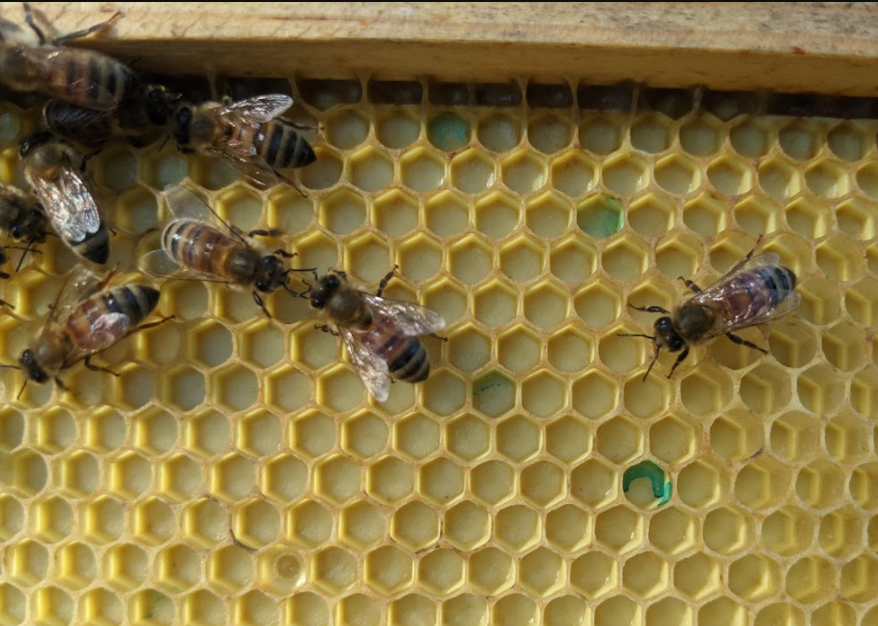
Fig. 6 In this outer frame of partially-drawn foundation I detected only blue color, with the water already evaporated. Not shown is that there were also blue stains along the bottom and upper surfaces of the top bars all across the hive.
Findings and practical application: I found blue color (indicating water) scattered only in the outermost frames and near the top bars — all in the periphery of the cluster. I found red syrup (indicating syrup) in far greater amount, but only within (and widely throughout) the broodnest and in the open cells of uncured honey within the cluster. It appeared that the bees that took the water drank some, and used the rest for evaporative cooling at the edge of the cluster. Bottom line: Yes, a colony appears to utilize water offered within the hive similar to how it uses water brought back by foragers.
In this experiment, I didn’t find any evidence of plain water being placed in the brood area, but that may be because it dried without being stored — Stabentheiner [[16]] shows a thermal photo of how bees cool the broodnest by evaporating droplets of water, which may cover up to 7% of the brood area [[17]]. On the other hand, there was plenty of heavy syrup stored around the brood, but at 77% sugar, one wouldn’t expect there to be much evaporation of moisture.
So I decided to return to my original question.
BACK TO MY ORIGINAL QUESTION
Practical question: Could the reason that my test colonies late last summer failed to expand their broodnests have been due to the colonies’ inability to maintain broodnest humidity during the hot, very dry weather?
Eggs and young larvae require high relative humidities to avoid desiccation [[18]]. There’s not a whole lot of published data on how closely colonies regulate broodnest humidity under various conditions. But by good fortune, I was able to obtain broodnest humidity data from two beekeepers who shared recordings from hives of their own with me. Comparing broodnest humidity measurements from colonies from very different temperature and humidity environments might allow us to tease out the minimum and maximum broodnest humidity targets that colonies aim for.
Etienne Tardif recorded data during a cool, humid summer in the Yukon. Under these conditions, a colony can relatively easily regulate its “preferred” minimum relative humidity [[19]] (Figure 7).
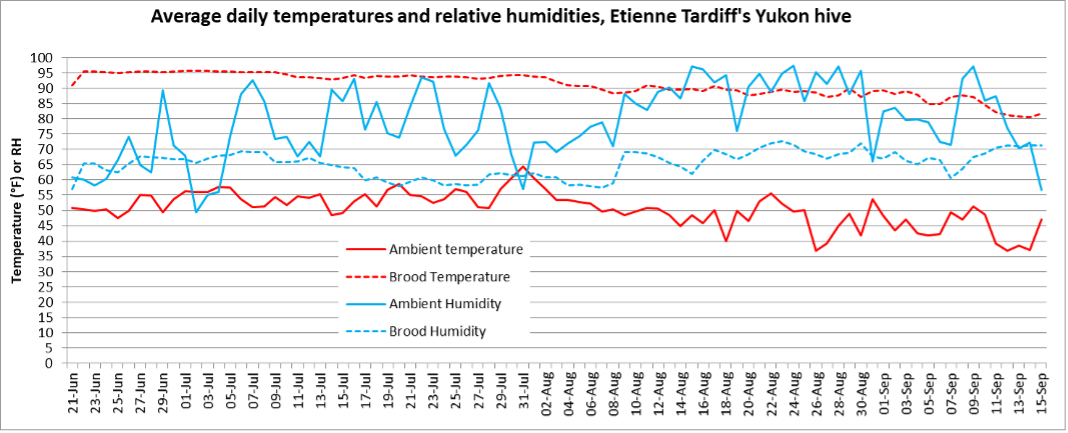 x
x
Fig. 7 Despite cool temperatures (mostly in the 40s to 50s F) and high ambient relative humidities (often above 90%), Etienne’s colony maintained a broodnest RH in the 55 to 70% range (averaging 65% over the course of the summer). The above data suggest that bees “prefer” a minimum broodnest RH of around 60%.
On the other hand, in a warm, humid climate it’s difficult for bees to lower broodnest humidity below ambient humidity, so we can find their maximum “preferred” limit. Russ Litsinger provided data from his hive in Kentucky (Figure 8).
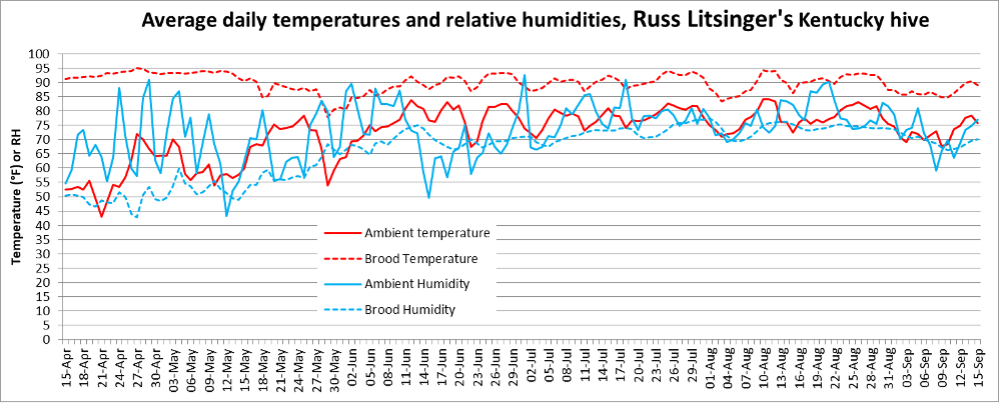
Fig. 8 Although ambient temps and RHs were often in the 80s, Russ’s colony was able to maintain broodnest RH in the same 50-70% range until higher summer temperatures and RH prevented them from being able to drop the internal RH by warming the air around the brood combs, resulting in a summer average RH of 72%. This suggests the upper limit for “preferred” broodnest humidity.
Practical application: The two graphs above confirm what other researchers have found — that despite greatly-varying ambient conditions, colonies attempt to maintain the relative humidity in the broodnest between the 50 and 75% RH setpoints, with the “preferred” range appearing to be 60-70% (perhaps a bit higher near eggs) [[20]].
So could relatively-small colonies in my hot and dry summer environment maintain broodnest RH in the 50-70% range? In order to see, I bought some humidistat/thermometers, and for preliminary testing measured the conditions between frames of colonies of different strengths and configurations.
My preliminary observations suggested that humidities tended to be higher in upper brood chambers than in lower. So for a worst-case scenario, I monitored the RH and temperature (for several days) of a single-deep weak colony in a dark-colored hive, in 100°F weather with no noticeable nectar flow. The RH next to their brood ranged from 60-80%, indicating that even a weak colony being blasted by the sun was able to maintain broodnest humidity under hot, dry conditions.
Surprised, I wanted some more detailed information. So I then set up a colony in the same configuration as the colonies in the trial last October (double deep, honey in the upper chamber, seven frames covered with bees, three frames in the lower chamber containing brood). I placed eight sensors, one outside the hive, the rest between frames in the lower chamber — three between the brood frames, the rest between honey frames, and recorded their readings hourly over the course of three warm days in October (Fig. 9).
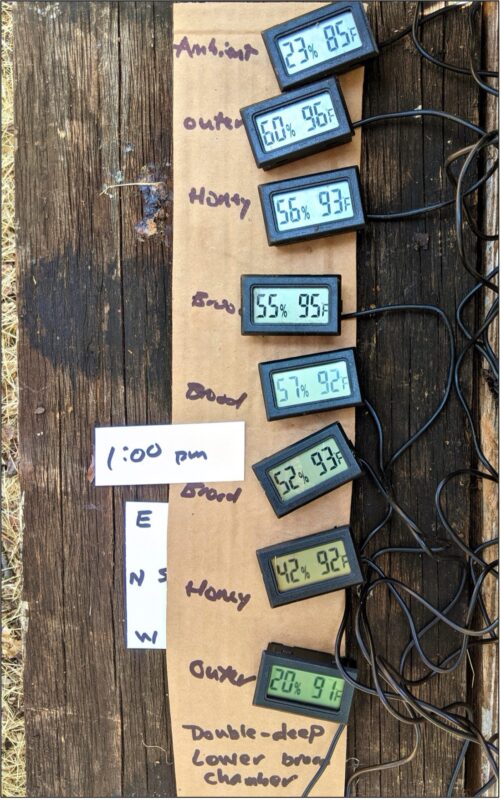
Fig. 9 Cheapskate that I am, rather than using data loggers, I crudely took photos of the readings every hour. There was a very light nectar flow on, and the full sun hit the hive around 11:00 each morning, then light shade occurred again around 2:00 pm.
Etienne and Russ provided me with daily averages data, which may be best for indicating target humidities, since a study by Hannelie Human [[21]] indicated that broodnest humidities may increase during the night. What I was really interested in was how low my colony would allow broodnest humidity to drop hour-by-hour during daytime. So I recorded hourly readings over the course of three days, with nighttimes indicated by gray columns (Fig. 10).
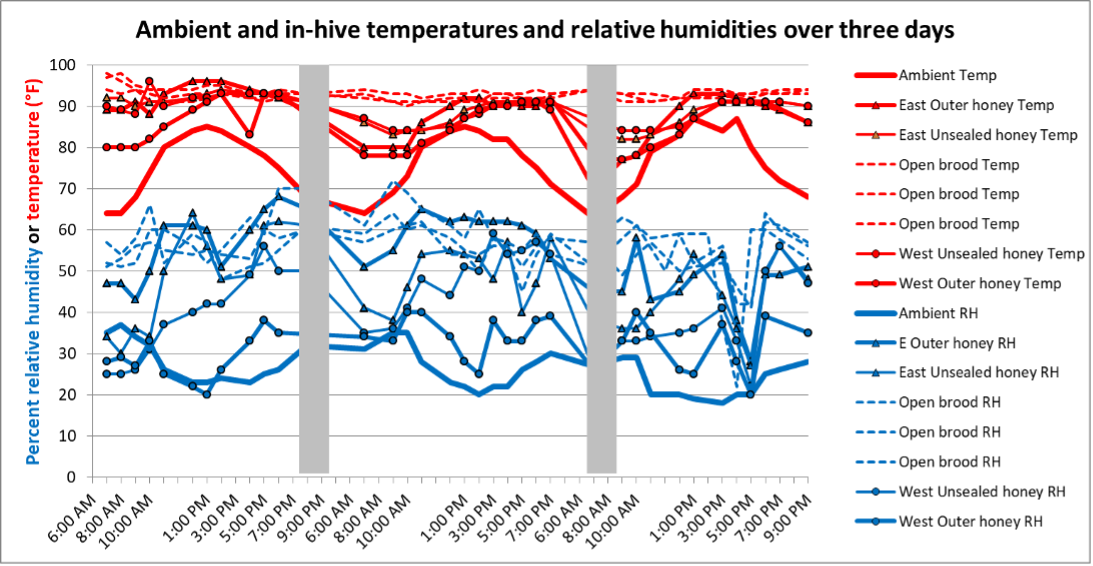
Fig. 10 First note that ambient temperature and humidity (heavy solid lines) were inversely proportional — as the air warmed, relative humidity decreased. Not so within the cluster. The colony easily maintained the brood at a near-constant temperature (red dashed lines), and certainly appeared to be able to maintain humidity between the brood frames (blue dashed lines) in the “normal” 50-70% RH range (overall daytime broodnest RH averaged 57%). At nearly all times during these three days, temperature and humidities between the frames were higher and more moderated than those outside the hive.
The only odd observation was that the RH next to unsealed honey (thin solid blue lines) was always higher on the east side of the hive (triangle markers). This may be where they tended to store and evaporate incoming nectar or water.
Another beautiful hypothesis slain — it appears that during hot, dry weather even weak colonies are able to maintain broodnest humidity in the 50-70% range. But that doesn’t mean that such maintenance doesn’t come at a cost — Yildiz [[22]] found that it takes a lot more energy for bees to cool their hive than to heat it.
Practical application: So I can’t blame the weather or lack of moisture for the lack of growth of these continually-fed colonies. I thus wrap this series up with what I mentioned in my last installment — that I suspect that the stimulation for brood rearing, is not just about placing protein patties somewhere in the hive, but is rather about providing the right cue(s) to the nurse bees to cease “brood trimming” and instead rear every laid egg to maturity, thus resulting in colony growth. Those cues likely have something to do with the placement of incoming nectar or pollen directly into the center of the broodnest, which thus informs the nurses that a flow is on, and it’s time for the colony to grow. We clearly need to learn more about the best placement of pollen sub within the hive.
UPDATES:
A very interesting article came to my attention after writing the above. It was written by Henry Pirker, a beekeeper in Alberta, Canada, who paid close attention to his indoor-wintered colonies. He observed that colony behavior when in winter cluster was all about humidity. Even when supplementally fed light sugar syrup to provide moisture, when colonies would sporadically “warm up” their brood area, and the queen would fill it with eggs, the nurse bees then consume those eggs rather than produce jelly to feed larvae.
Pirker experimented with raising the humidity in his storage room, and found that doing so would result in a number of observable colony behaviors, as well as the humidified colonies immediately engaging in rearing large amounts of brood.
Pirker concluded that: Perhaps in trying to understand the nature of our bees, we should be reminded that they evolved in the lands around the Mediterranean Sea. Drought periods posed at least as great a challenge as the cool seasons. It is not merely a coincidence of nature that the defensive mechanism of Apis mellifera functions equally against drought and cold. Must not, indeed, our winter with its minute available humidity appear to the bees primarily as a prolonged, severe drought season?
Pirker, H (1978) Steering factor humidity. ABJ Dec 1978: 786-789.
Perhaps I was too hasty in letting lack of moisture off the hook. “Moisture” is not just about humidity – it’s also about the amount of water required for the nurse bees to produce jelly.
In his excellent book “Fat Bees, Skinny Bees”, Doug Somerville notes:
.Ample available nectar in the field also acts as a stimulus to the colony, encouraging increasing interest by the colony for pollen and an expansion of the areas of brood within the colony.
Following upon this, I ran a rough calculation as to how much incoming water a colony actually needed (from either nectar or water foragers) to produce the high-moisture jelly necessary for rearing larvae.

ACKNOWLEDGEMENTS
Thanks to Etienne Tardif and Russ Litsinger for data and discussion, Dr. Alqarni for his observations, and to Peter Borst for library assistance.
REFERENCES
[1] Somerville, Doug (2005) Fat Bees Skinny Bees, A manual on honey bee nutrition for beekeepers. Rural Industries Research and Development Corporation, Australia.
[2] Ellis, M, et al. (2008 Hygropreference and brood care in the honeybee (Apis mellifera). Journal of Insect Physiology 54(12):1516-21.
[3] Li Z, et al. (2016) Drone and worker brood microclimates are regulated differentially in honey bees, Apis mellifera. PLoS ONE 11(2): e0148740.
[4] Abou-Shaara, H, et al. (2012) Tolerance of two honey bee races to various temperature and relative humidity gradients. Environmental and Experimental Biology10: 133–138.
[5] Harbo, J (2000) Heating adult honey bees to remove Varroa Jacobsoni. Journal of Apicultural Research 39(3-4): 181-182.
[6] Kovak, H, et al. (2007) Respiration of resting honeybees. J Insect Physiol. 53(12): 1250–1261.
[7] Chilcott, A, & T. Seeley (2018) Cold-flying foragers: Honey bees in Scotland seek water in winter. ABJ 158(1): 75-77.
[8] Bordier, C, et al. (2017) Colony adaptive response to simulated heat waves and consequences at the individual level in honeybees (Apis mellifera). Sci Rep 7: 3760.
[9] Park O (1923) Water stored by bees. ABH 63: 348-349.
[10] Nicolson, S (2009) Water homeostasis in bees, with the emphasis on sociality. The Journal of Experimental Biology 212: 429-434.
[11] Lindauer, M (1955) The water economy and temperature regulation of the honeybee colony. Bee World 36(6): 105-111.
[12] Kühnholz, S., Seeley, T. (1997) The control of water collection in honey bee colonies. Behav Ecol Sociobiol 41, 407–422.
[13] Ostwald, M, et al. (2016) The behavioral regulation of thirst, water collection and water storage in honey bee colonies. Journal of Experimental Biology 219: 2156-2165.
[14] Abou-Shaara, H (2012) Notes on water collection by honey bees. Bee World 89(4): 86-87.
[15] Standifer, L, et al. (1973) Supplementary feeding of honeybee colonies in Arizona. ABJ 113: 298 -301.
[16] Stabentheiner, A, et al. (2021) Coping with the cold and fighting the heat: thermal homeostasis of a superorganism, the honeybee colony. Journal of Comparative Physiology A, 207(3): 337-351.
[17] Their Figure 7c, and Table S1.
[18] Doull, K (1976). The effects of different humidities on the hatching of the eggs of honeybees. Apidologie 7(1): 61-66.
[19] Download a psychometric chart: (https://www.engineeringtoolbox.com/docs/documents/816/psychrometric_chart_29inHg.pdf
At 50°F at a RH of 90%, a pound of air holds 50 grains of moisture. But if the bees warm that air to broodnest temperature, its RH drops to only 20%. Thus, they would need to add moisture, so Etienne’s data would suggest the lowest broodnest RH limit targeted by bees. Conversely, Russ’s data would suggest the highest broodnest humidity allowed.
[20] Li, Z, et al. (2016) Drone and worker brood microclimates are regulated differentially in honey bees, Apis mellifera. PLoS ONE 11(2): e0148740.
[21] Human, H, et al. (2006) Do honeybees, Apis mellifera scutellata, regulate humidity in their nest? Naturwissenschaften 93: 397–401.
[22] Yildiz, C & M Özilgen (2019). Thermodynamic assessment of the impact of the climate change on the honeybees. International Journal of Global Warming, 17(2): 185-218.
A COMPARATIVE TRIAL OF THE POLLEN SUBS
Part 6: DO WE NEED TO REVISE DE GROOT?
Beekeeper-Funded Research
First Published in ABJ December 2021
Randy Oliver
ScientificBeekeeping.com
Bee nutritionists have long cited the essential amino acid ratios suggested by de Groot in 1953. But he himself pointed out the shortcomings of his methods and qualified his recommendations. I feel that after nearly seventy years, it may be time to catch up with the other livestock industries, and update our knowledge on what constitutes an optimal supplemental diet for honey bee colony growth.
An addition: In the introduction to his groundbreaking paper, Antonious de Groot wrote words that are as applicable today as they were in 1953: “The attention of nutritional research workers so far paid to the honeybee is not proportional to its economic significance.”
De Groot understood that what really counted for bee diets intended for colony growth would be the requirements for the nurse bees producing the jelly necessary to feed the larvae, queen, and older workers. But that’s not what he investigated. This has bugged me for years — that few researchers other than Elton Herbert have followed up on measuring the growth of colonies (as opposed to a few caged workers) fed artificial diets, which would be the best and easiest way to determine whether de Groot’s essential amino acid (EAA) ratios for adult (non-nurse) bee development would be the same as for overall colony development, which is what we beekeepers would want in our pollen subs. In this last article of this series, I’m going to stick my neck out and make a stab at revising de Groot’s ratios and suggest the sort of applied research that our industry deserves.
Allow me to begin by taking a look how the amino acids in a diet are actually used by an organism.
HOW PROTEIN AND AMINO ACIDS ARE USED
The body tissues of adult bees are largely composed of protein — proteins constitute about 50% of a bee’s dry weight [[1]]. The various types of body and haemolymph proteins are all created from the metabolic pool of amino acids derived from their diet, as illustrated by Figure 1 (published during the years in which de Groot was performing his research).
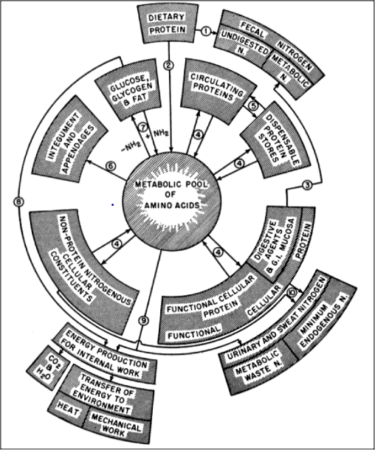
Fig. 1 Dr. Harold Mitchell was a pioneering animal nutritionist at the University of Illinois. In 1950 he published this flow chart of how dietary proteins were used by the body. Image from [[2]].
The protein in a diet is first digested into its constituent amino acids, from which the body then synthesizes new body components by the process of anabolism (the opposite is catabolism — the “destructive metabolism” of body tissue). That process is limited largely by the amount of essential amino acids (EAAs) in the diet [[3]], as well as their relative proportions to each other. The EAAs are used not only for building (or replacing) muscle mass and internal organs, but also to create haemolymph and dispensable storage proteins. Some protein is interspersed in chitin to form the bees’ cuticle and wings. And some may be burned as fuel for energy if enough carbohydrates (sugars) are not available in the diet.
One way to measure bee growth is by drying and weighing individual bees. But such weight gain includes components largely built from carbohydrates, such as blood sugars, low-proteinaceous chitin, and lipids. With regard to artificial diets, what we’re more concerned with is the utilization of the nitrogen in the diet, which comes from the protein.
Practical application: So perhaps what we really should focus upon is their increase in nitrogen content.This consideration did not escape de Groot, so he measured both dry weight gain as well as nitrogen increase (Figure 2).
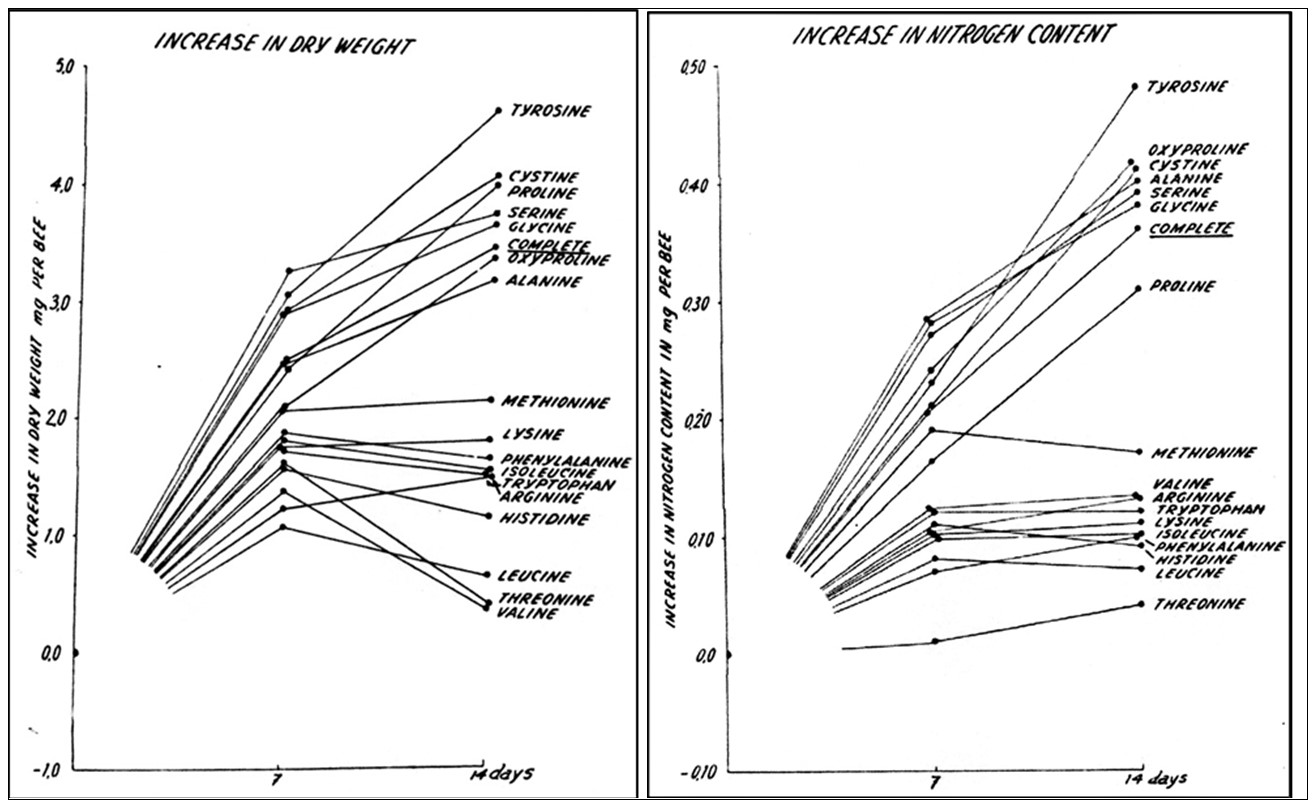
Fig 2. Compare the effects of EAA deficiencies upon weight gain (above) versus gain in nitrogen (below), which indicates the actual incorporation of those EAAs into body mass. Note severe weight loss in adult bees if leucine, threonine, valine are deficient. But the graph at the right indicates that the weight loss was due to the critical requirement of those EAAs for the process of building non-proteinaceous body tissues, rather than being incorporated into those tissues.
Practical application: We can’t just look at protein analyses of body tissues estimated from nitrogen content; we must also keep in mind that some EAAs are essential for the building of non-nitrogenous body components. I’ll return to this concept when I discuss “carcass analysis.”
NUTRIENT REQUIREMENTS CHANGE WITH STAGE OF DEVELOPMENT
At each stage of development, a worker honey bee is anabolizing different body components, perhaps consuming different food, and may require different proportions of EAAs:
- Larval development — Major weight gain consisting of a small amount of integument, muscle, digestive tract, and tracheal system, but mostly from large amounts of storage protein in fat bodies [[4]]. Protein source — nurse-fed jelly.
- Pupal-to-adult development — Development of the chitinous exoskeleton (including wings, legs, and eyes), adult organs, and body musculature. Protein source — the fat bodies of the pupa, and the repurposing of pupal tissue. This means that the pupa is its own protein source, so that analysis of the amino acid ratio of its body may be informative.
- Post-emergence development — Major development of the hypopharyngeal glands and fat bodies, Partial development of the wing muscles and the sting. Protein source — pollen and some jelly.
- Nurse bee development — The nurses need to produce copious quantities of protein-rich jelly for feeding the larvae and other members of the colony. Protein source — pollen.
- Mid-age worker development — Development of the wax glands and wing muscles. Protein source —pollen, jelly, and autophagy of the fat bodies and hypopharyngeal glands as they lose weight in preparation for foraging [[5]].
- Forager development — Final growth and maintenance of the wing muscles and body tissues. Protein source — jelly begged from nurses.
- “Winter bee” development — The diutinus state taken by workers that emerge during pollen dearths might be considered as “arrested development” of nursing physiology. Protein source — pollen.
- “Winter bee” maintenance — Very little protein is required. Protein source — a small amount from honey, stored beebread, autophagy (“self-consumption” of storage proteins in the fat bodies) [[6]].
Practical application: Similar to the different diets sold for the optimal development of broiler chickens at each stage of growth, we may find that there is no one-size-fits-all diet for honey bees.
WINTER FEEDING
AUTUMN FEEDING FOR STORAGE PROTEINS
Before I return to diet for colony development, let’s first consider diets in preparation for, or during winter. Beekeepers feed pollen subs not only to provide the necessary nutrients for the last rounds of brood that will become long-lived “winter bees,” but also to allow those emerged workers to fully develop their storage proteins in order to survive the winter. Would the development of storage proteins require a different EAA ratio in the diet?
As pointed out by de Groot:
Many kinds of insects can maintain life for considerable periods in the absence of nitrogenous food.
They do this by digesting their body protein reserves (catabolism). “Winter bees” exhibiting diutinus physiology (similar to nurses, but not producing jelly), as mentioned earlier, break down their protein reserves in order to obtain the amino acids (and under conditions of starvation, energy) necessary for “body maintenance.”
Practical application: De Groot studied the EAA requirements of young workers not being exposed to brood pheromone, suggesting that they might have gone into diutinus physiology. Thus, his recommended EAA ratios may well apply to diets fed to the last round of emerging workers after broodrearing ceases in autumn.
Many beekeepers feed pollen subs in autumn in order to prepare the “winter bees” for longevity and late-winter brood rearing. Unlike as with forager-collected natural pollen or dry-fed pollen sub, diets fed in patty form inside the hive are not stored in the combs [[7], [8]], so the benefit of autumn feeding of pollen patties may mostly be to promote the synthesis of those storage proteins. That said, those storage proteins allow for only a very limited amount of brood rearing. Haydak’s [[9]] findings suggest that it requires the storage proteins of around 30 worker bees to rear a single replacement worker to adulthood (at which point that worker would still need to consume additional protein in order to complete its development).
Most beekeepers have heard of the important storage protein vitellogenin. Of interest is that Otis [[10]] found that winter bees stored more of a hexamerin protein (presumably arylphorin) than vitellogenin. They also confirmed that a “winter bee” stored only a fraction of the protein necessary to feed even a single larva.
So which EAAs are important for the formation of these hexamerin storage proteins? Those rich in the aromatic amino acids (phenylalanine, tyrosine, and tryptophan) are called arylphorins, whereas another group of hexamerins are known as methionine-rich storage proteins. Frustratingly, I was unable to find information on the EAAs in vitellogenin. The extremely high proportion of tyrosine in insect storage proteins [[11]] suggests that we might want to pay attention to this “conditionally essential” amino acid in diets intended for colony development or “winter bees.”
Practical application: The findings of Haydak, Jeffree, and Otis point out that the ability of colonies to rear brood during winter is poorly understood. We clearly need more research on this subject.
WINTER FEEDING FOR BODY MAINTENANCE
De Groot found that based upon his preliminary research:
From the above results it may be concluded, that in contrast with findings of other authors the longevity of old bees is increased by supplementing the carbohydrate diet with various protein containing proteins or pure protein in a suitable concentration. Obviously in the bee colony the need for protein is not restricted to the brood rearing period but proteins are required for maintenance of adult bees as well. This finding is in striking contrast with the widespread opinion, that during the winter period the bee requires only carbohydrates. It is common use in beekeeping practice to substitute the honey for stores of pure sugar for overwintering bee colonies, which is not considered to be disadvantageous from the nutritional point of view. However, honeys contain small amounts of protein varying in the region where we found the protein containing material to exert its longevity promoting action on old bees. … Therefore it is obvious to suggest that sucrose stores enriched with a suitable amount of protein food with a high biological value may be more favorable for overwintering bee colonies than [the] stores of pure carbohydrate generally used at present in apiculture.
Winter feeding with straight sugar is still a common practice today (Figure 3).
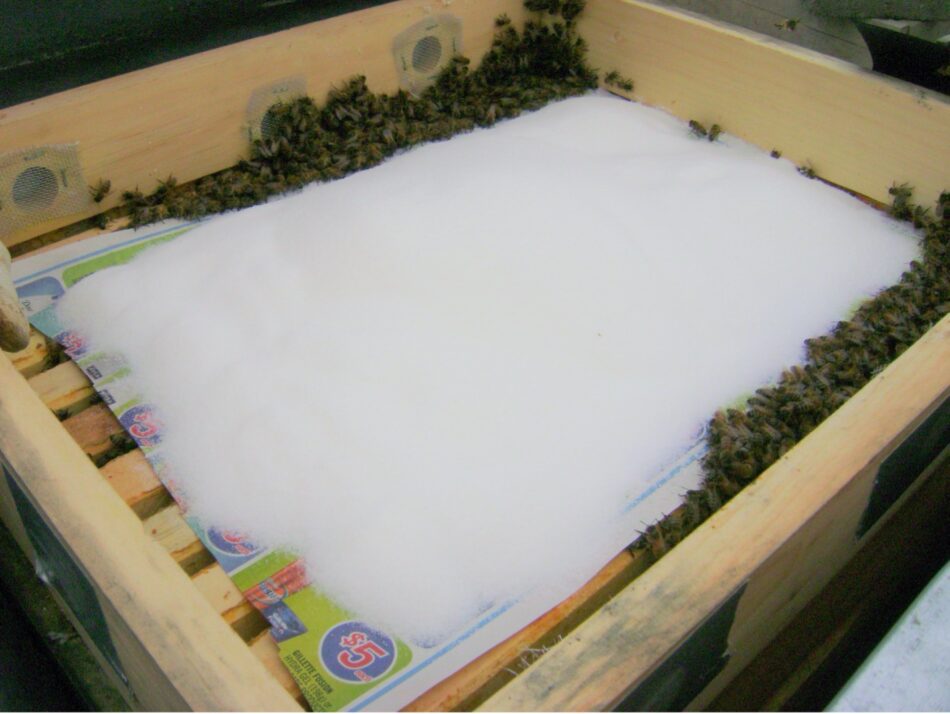
Fig. 3 A wintering colony being fed dry granulated sugar. This method was described by Johansson in 1977 [[12]], and later popularized on Beesource as the “mountaincamp method,” after posts by a beekeeper from Mountain Camp Farm in New York. Note that Johansson cautioned that colonies fed with dry sugar may need to forage for water to dilute the sugar. Photo credit: Phillip Cairns/ mudsongs.org
Practical application: Adding some high-quality protein to sugar fed during winter would likely help the “winter bees” to maintain their body reserves. Several manufacturers are offering protein-enriched “winter patties.” We could sure use some easily-performed field trials to see whether enhancing that protein with the certain amino acids [[13]] would be of benefit.
WHICH EAA RATIO IS BEST FOR COLONY DEVELOPMENT?
Winter feeding aside, most of us feed pollen sub to allow our colonies to grow. Jeffree [[14]] found that colonies in Scotland enter winter without enough stored beebread to allow nurse bees to feed more than a minimal amount of larvae, yet sporadically rear larvae throughout the winter. Thus late-winter feeding of pollen sub can be of great benefit for those beekeepers who require strong colonies for early pollination contracts.
Practical application: We almond pollinators have found that midwinter feeding of pollen sub under the right conditions can encourage serious brood rearing and colony buildup.
AT WHAT DEVELOPMENTAL STAGE DO BEES MOST REQUIRE PROTEIN?
So the question is, at what stage of development does a worker bee actually require the most protein in its diet? It’s during their larval stage (Figure 4).
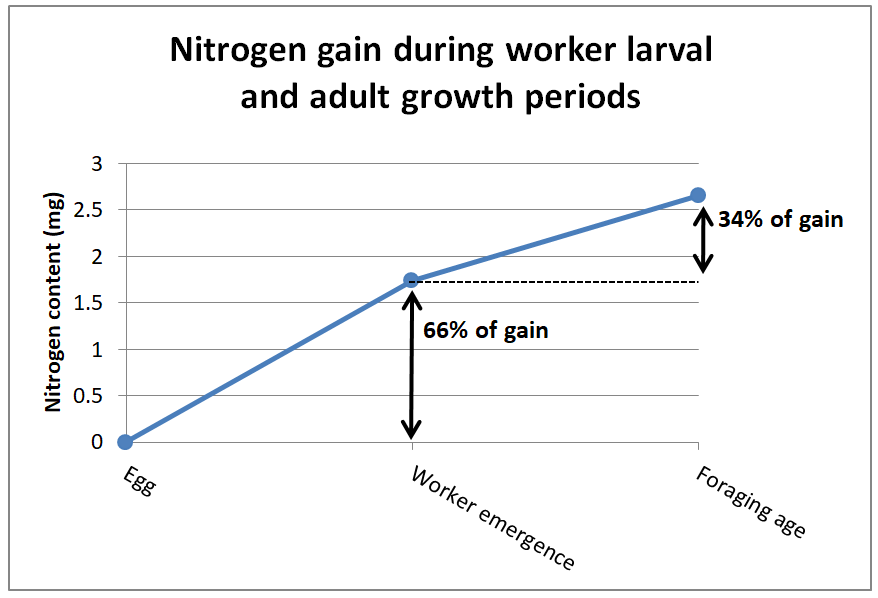
Fig. 4 Increase in nitrogen content of the bodies of worker bees during growth periods. Two-thirds of the incorporation of amino acids into a bee’s body occurs when they are consuming the jelly produced by nurse bees, as opposed to the 1/3 added from the pollen that it consumes after emergence. Data from [[15], [16]].
De Groot’s estimates represented the EAA requirements for newly-emerged non-nursing adult workers (which may have developed their ovaries due to the lack of suppressive queen pheromone [[17]]). The graph above indicates that the protein requirement of the larvae is more important as far as colony growth. But the larvae benefit from pollen sub indirectly — it is the nurse bees that actually consume the pollen sub and convert it to jelly (any pollen that the larvae might receive from the nurses provides an insignificant amount of protein overall [[18]]).
Thus de Groot’s estimated ratios may not apply to the all-important nurse bees, which are responsible for the digestion of proteins for the entire colony (and are thus the consumers of pollen sub). The nurses then convert pollen sub into the jelly to feed the queen, the brood, and the rest of the workers (jelly being the “currency of protein” within the colony).
Practical application: So for colony growth, what we really need to determine is the optimal EAA ratio in the diet of nurse bees feeding larvae.
WAYS TO DETERMINE OPTIMAL EAA REQUIREMENTS
Although researchers have now developed methods for successfully rearing worker larvae in vitro, the diet consists mainly of harvested royal jelly [[19]]. Until a completely artificial diet for larvae is developed, we need to stick to figuring out diets that allow nurse bees to produce the most jelly.
There are several possible ways for researchers to do so. Allow me to list some other benchmark indicators to which we can compare de Groot’s recommendations. I will graph them out after explaining them.
COMPARE TO ROYAL JELLY
It would be reasonable to assume that royal jelly produced by nurse bees would contain the ideal ratio of EAAs for optimal larval growth. I downloaded several analyses of the amino acids in royal jelly, and found that the EAA ratios were remarkably consistent, despite being from different countries and the consumption of different pollens. Some of the older analyses lacked data for tryptophan. Fortunately, in 2009 a new method was developed to quantify tryptophan [ [20]], so I was able to insert a value. I averaged the five most consistent analyses for graphing purposes.
Side note: An interesting study by Webster [[21]] found that nurse bees that cannibalize brood rapidly recycle the amino acids of those larvae back into royal jelly, and to a lesser extent into body tissue. The take-home is that bees don’t waste amino acids, and that open brood can serve as a protein reserve for producing jelly.
COMPARE TO KNOWN NUTRITIOUS NATURAL POLLENS
Studies from the Tucson Lab in the 1970s confirm beekeeper observations that colonies grow very well on almond pollen [[22]], so we can likely use the EAA ratio of almond pollen or other known nutritious pollens (such as mustard or sweet clover) as benchmarks.
COMPARSION TO OTHER ANIMALS AND WHAT THEY FEED THEIR OFFSPRING
Similar to royal jelly being the “perfect” food for queens and larvae, cows and chickens also produce proteins that are perfect foods for their offspring — casein and albumin, respectively. Again, both of those proteins are the result of evolutionary selection for an EAA composition that would allow for complete development of their offspring. Perhaps not surprisingly, both work very well as protein sources for honey bees [[23],[24]].
CARCASS ANALYSIS
Another possible indicator of EAA requirements for a diet are the EAAs present in the animal’s body. This is termed “carcass analysis” [[25]], and would certainly be a simple way to determine the ideal ratio. Unfortunately, EAA requirements change with an animal’s stage of growth [[26], [27]], and whether the EAAs are actually incorporated into the body, or merely involved in the process of tissue synthesis.
That said, Ghosh [[28]] provides amino acid analyses for worker bee larvae, pupae, and adults (Figure 5).
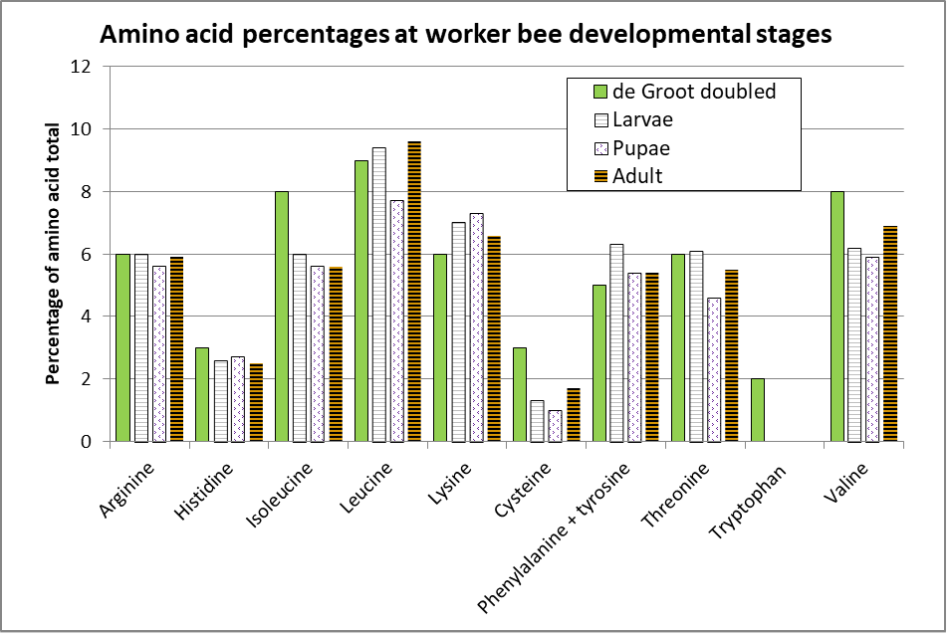
Fig. 5 Comparison of the EAA ratios of the three developmental stages of honey bee workers, compared to those determined by de Groot. (I doubled de Groot’s ratio, since his EAA mixture only constituted 25.6% of the protein in the diet, whereas it should likely have been ~50%.) Of interest is how the concentrations of leucine, phenylalanine, and threonine drop substantially upon pupation (after the larvae have defecated), indicating that those amino acids were necessary for tissue formation only, rather than being incorporated into the resulting body tissue.
Notes for Ghosh’s findings:
- Non-essential tyrosine and cysteine may substitute for essential phenylalanine and methionine (respectively) if they are in short supply. For some reason Ghosh did not measure methionine, whereas de Groot did not measure cysteine or tyrosine, so the comparative columns for those AAs are questionable. In many current EAA analyses, authors combine the two pairs of complimentary amino acids, as do I.
- The adult bees analyzed were in-hive “house bees” (wings removed) that had the opportunity to feed upon pollen in the combs, so their EAA changes from pupae were likely due to the development of adult tissues after feeding upon pollen.
- Tryptophan is required for tissue growth, but not so much for maintenance. Ghosh’s analysis was unable to detect tryptophan in larvae or pupae, and it barely registered in the adults — this is surprising, since de Groot determined that tryptophan should account for a full 4% of the EAAs. And remember Figure 2, which indicates that the requirements for leucine, threonine, and valine may be underestimated by carcass nitrogen analyses alone.
From the above graph, it appears that for larval growth, compared to adult weight gain, larvae require a bit more isoleucine, lysine, phenylalanine, and threonine, and a little less valine than do adult bees. Of interest is that Ghosh was not able to detect tryptophan in larvae or pupae, and only 0.03% in adults — further reason to not normalize EAA ratios to tryptophan.
Practical application: De Groot’s ratios for adult bees appear to be close to those required for larval development, but the differences indicate that the optimal EAA ratios for an ideal diet for colony growthmight need to be slightly tweaked.
I’ve since engaged in reviewing a large amount of research on the amino acid composition of natural pollens noted as being of high nutritional value to bees, analyses of royal jelly, and the amino acid requirements of other insects and animals. I’ve come to the conclusion that de Groot’s experimentally-determined ratios should be looked at compared to other findings, such as the fact that bees grow very well on the proteins casein (from milk) [[29]], albumen (from chicken eggs) [[30], [31]], royal jelly, and some pollen types. So I compared the EAA ratios of the above protein sources, as well as the EAA ratio in bee brood itself in the chart below (Figure 6).
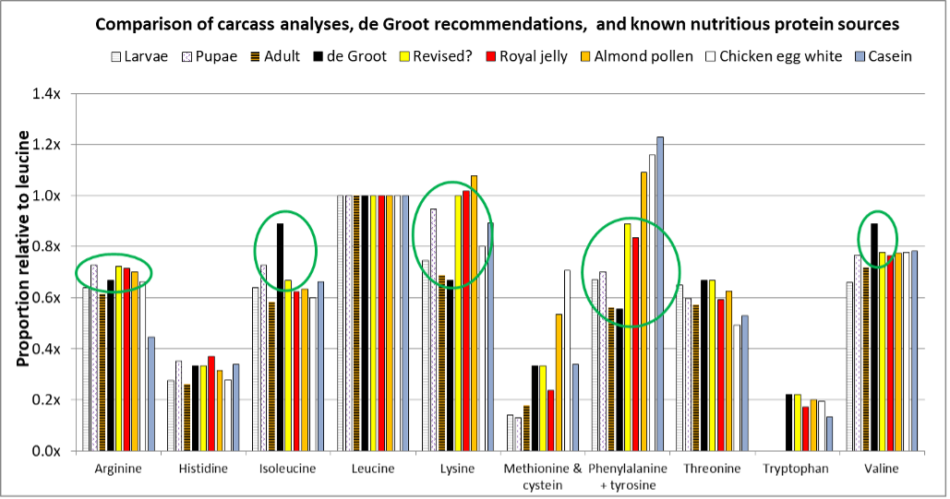
Fig. 6 De Groot’s recommendations, compared to carcass analyses of worker developmental stages, royal jelly, pollen, chicken egg and cow milk proteins (both of which have been shown to support bee growth). I’ve circled indicators of where de Groot’s EAA ratios may need to be adjusted for colony growth as opposed to emerged worker increase in nitrogen content [[32]]. I’ve also (in yellow) inserted a suggested revision of de Groot’s recommended ratios. Note that not all analyses combined the aromatic amino acids.
Practical application: The above chart suggests that de Groot was certainly not far off the mark. However, for optimal egg-to-adult worker growth, his suggested ratios may be a bit high for isoleucine and valine, and low for lysine and phenylalanine. We clearly need further experimental results to confirm. But allow me to be bold enough to suggest a revision (Table 1):
| Table 1. Suggested revisions (in red) to de Groot’s recommendations for the proportional ratios of the EAAs for diets intended for colony growth. |
|
de Groot |
Revised? |
Revised normalized to leucine |
| Arginine |
3 |
3.25 |
0.72 |
| Histidine |
1.5 |
1.5 |
0.33 |
| Isoleucine |
4 |
3 |
0.67 |
| Leucine |
4.5 |
4.5 |
1.00 |
| Lysine |
3 |
4.5 |
1.00 |
| Methionine & cysteine |
1.5 |
1.5 |
0.33 |
| Phenylalanine + tyrosine |
2.5 |
4 |
0.89 |
| Threonine |
3 |
3 |
0.67 |
| Tryptophan |
1 |
1 |
0.22 |
| Valine |
4 |
3.5 |
0.78 |
OK, that’s a bunch of numbers, but I suspect that what you’d really want to know is how do my suggested ratios compare to those of the top-performing pollen subs in my trial? See Figure 7.
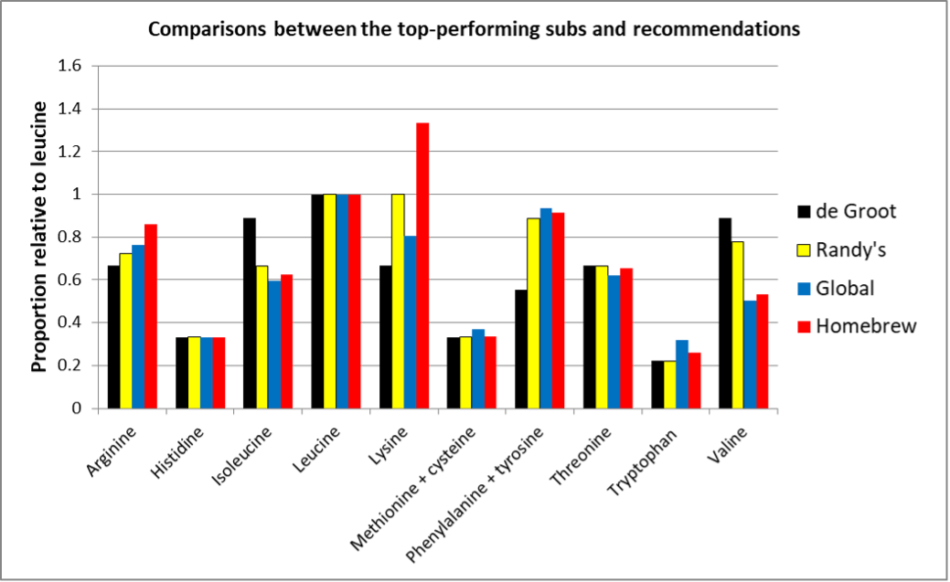
Fig. 7 A comparison of the EAA ratios, normalized to leucine, from de Groot’s suggestion, my suggestion, and the two top-performing tested pollen subs. Note how closely my suggested ratios (yellow) match those of the top performers.
CAGE AND SEMI-FIELD STUDIES
In-lab cage studies are limited by the difficulty of maintaining the necessary jelly-producing nurse bees and rearing the produced brood to maturity for several generations on artificial diets. I’m in complete agreement with Hendricksma [[33]] that:
We suggest that colony supplementation should target nurse bee nutrition. … Our study also highlights the importance of testing honey bee nutrition with field and laboratory studies. Testing diet treatments on caged bees as compared with whole colonies may yield different insights.
Practical application: The gold standard semi-field bioassay for testing the nutritional efficiency of honey bee diets is at the colony level by using nucs with free-flight access in screened cages (4x4x8 feet), developed at the Beltsville Lab [[34]]. I strongly encourage more research on artificial diets using this method.
Suggestions for researchers: That said, I’m curious as to whether a modification of Haydak’s method of extending nurse longevity by removing sealed brood [[35]], or the swarm box method for producing multiple rounds of queen cells from a cohort of nurse bees could be used [[36]].
BASIC FORMULA FOR HONEY BEE ARTIFICIAL DIETS
Based upon a review of the literature, plus the findings from our field trial, one can arrive at suggested proportions for an optimal artificial diet for stimulating brood production.
Update: I don’t make recommendations. My hope is that future research will fine tune the specifications for pollen substitutes. An excellent review is Black, J (2006) Honeybee Nutrition: Review of research and practices. RIRDC Publication No 06/052 https://www.agrifutures.com.au/wp-content/uploads/publications/06-052.pdf
Crude protein: Other research suggests that 25-30% (dry weight) may be optimal [[37], [38]]. The best-performing subs in this trial were in the 15-20% range (wet weight of the diet, moisture content was not measured). EAAs should make up about 50% of the crude protein content. One can use my calculator [[39]] to balance the EAAs by adding concentrates.
Sugar content: around 40-50%.
Lipid content: We really don’t yet know that much about the lipid requirements of bees. Ghosh found that palmitic, stearic and oleic acids were predominant in all of the stages of bees. But many insects, and likely bees, can create their own fatty acids, other than omega-3 and -6s. Total lipid content of a diet (wet weight) should likely somewhere in the 5% range, with canola oil seeming to work well. A recent study by Arien suggests that honey bees may benefit from a higher omega-3 to omega-6 ratio than that of canola oil, so one may wish to add some flax seed oil (flax seed oil rapidly degrades, so store it in a cold, dark place). Manning found that bees liked the taste of flax seed oil.
Arien, Y, et al (2020) Effect of diet lipids and omega-6: 3 ratio on honey bee brood development, adult survival and body composition. Journal of insect physiology, 124, 104074.
Manning, R, et al (2010) Added vegetable and fish oils to low‐fat pollen diets: effect on honey bee (Apis mellifera L.) consumption. Australian journal of entomology, 49(2), 182-189.
Vitamins, minerals, and sterols: Dietary requirements are not really clear, and these may be adequately provided by the raw feedstuffs (such as brewer’s yeast). But note that at least some brewer’s yeasts may be distasteful to bees [[40]]. Ghosh found that adult bees contain higher concentrations of the trace elements iron, zinc, calcium, magnesium, and copper than those found in red meat, suggesting that any pollen sub should contain ample levels of these trace elements. It may be wise to make sure that zinc is in the 75 ppm range.
Update: Dolezal found that feeding a high-quality pollen reduced the virulence of virus infection. They also suggest the the trace elements iron and copper may be important. Dolezal AG, et al (2019) Interacting stressors matter: diet quality and virus infection in honeybee health. R. Soc. open sci. 6: 181803.
Particle size: most bee-collected pollens are less than 50 micrometers in diameter [[41]], suggesting that all feedstuffs should likely be ground to not larger than that particle size. (I’ve observed colonies kicking out, rather than consuming, larger particles.)
Updates: Flours sifted through 200-mesh have a maximum particles size of 74 micrometers (microns).
Influence of the gut microbiota: An eye-opening study from Nancy Moran’s lab indicates that the symbiotic bacterium Bombella apis, which is found in association with the jelly fed to queens and larvae, is able to synthesize all essential amino acids from an inadequate diet. It was notably able to synthesize lysine, which appears to be more important for larvae than for adult workers. This finding opens our eyes to new aspects of bee nutrition.
Parish, A.J., Rice, D.W., Tanquary, V.M., Tennessen, J.M., & Newton, I.L. (2022). A honey bee symbiont buffers larvae against nutritional stress through lysine supplementation. bioRxiv.
Natural pollen: Again, any benefit is not clear. De Groot found that the enzymes in honey or beebread appeared not to be essential in a diet [[42]]. For phagostimulation, pollen needs to make up not more than 5% of the patty (Figure 8).
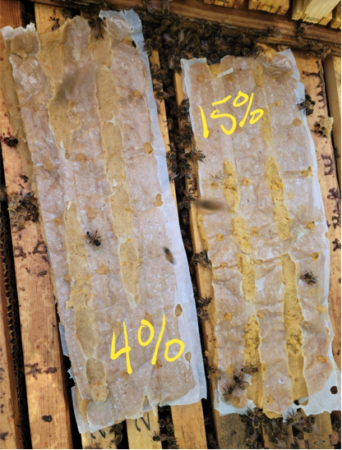
An additional photo.
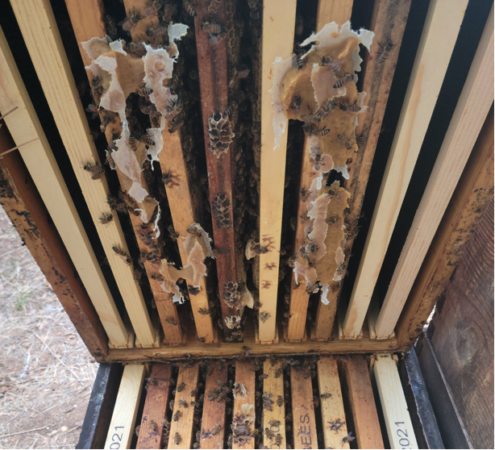
Fig. 8 We’ve heard claims that a high proportion of natural pollen in a patty results in the bees consuming it much more quickly. So this fall my son Eric ran a test, by placing one 4% pollen and one 15% pollen Global patty side-by-side on 150 hives. He then checked back, taking photos at all stages of consumption, and showed them to me as a blinded grader of consumption rate. Neither of us could see any difference.
A POSSIBLE INEXPENSIVE DIET
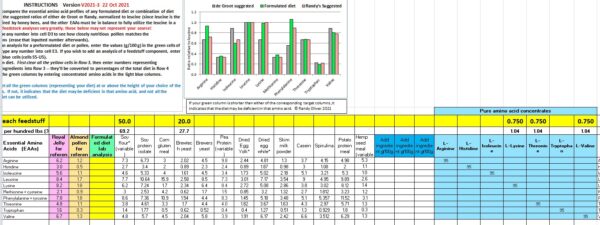
THAT’S IT!
This has been a much longer write up on pollen subs than I imagined, but since so many of us professional beekeepers spend a great deal of money on them, I hope that ABJ’s readers feel that this series has been informative. I especially hope that what we’ve learned, as well as my remaining questions, encourages our manufacturers to improve their formulations, and our researchers to take up where de Groot and Elton Herbert, Jr. left off.
DE GROOT’S PAPER
I’ve mentioned that de Groot’s monumental study is difficult to access. Those interested can download a copy at https://scientificbeekeeping.com/de-groot-1953/
REFERENCES AND NOTES
[1] Ghosh, S, et al. (2016) Nutritional value and chemical composition of larvae, pupae, and adults of worker honey bee, Apis mellifera ligustica as a sustainable food source. Journal of Asia-Pacific Entomology 19: 487–495.
[2] Mitchell, H, in Albanese, A (1950) Protein and amino acid requirements of mammals. Academic Press.
[3] Church, D, et al. (2020) Essential amino acids and protein synthesis: insights into maximizing the muscle and whole-body response to feeding. Nutrients 12, 3717.
[4] Chan, Q & L Foster (2008) Changes in protein expression during honey bee larval development. Genome Biol. 9(10): R156.
[5] Corby-Harris V, et al. (2019) Fat body lipolysis connects poor nutrition to hypopharyngeal gland degradation in Apis mellifera. J Insect Physiol. 116:1-9.
[6] Haydak, M (1970) Honey Bee Nutrition. Annual Review of Entomology 15:143-156. Haydak found that 45% of abdominal nitrogen may be lost by long-lived workers starved for protein.
[7] https://scientificbeekeeping.com/where-does-fed-pollen-sub-go/
[8] Noordyke, E, et al. (2021) Tracing the fate of pollen substitute patties in western honey bee (Hymenoptera: Apidae) Colonies. Journal of Economic Entomology 114(4): 1421–1430.
[9] Haydak, M. H. (1935). Brood rearing by honey bees confined to a pure carbohydrate diet. Journal of Economic Entomology, 28, 657-660.
[10] Otis, G, et al. (2004) Storage proteins in winter honey bees. Apiacata 38: 352-357.
[11] Scheller K, et al. (1990) Molecular properties, functions and developmentally regulated biosynthesis of arylphorin in Calliphora vicina. In: Hagedorn H, et al. (eds) Molecular Insect Science.
[12] Johansson, T & M Johansson (1977) Beekeeping techniques, Feeding Sugar to Bees. 3. Dry Sugar and Candy. Bee World, 58:2, 49-52.
[13] The “aromatic” amino acids listed later in this artlcle.
[14] Jeffree, E (1956) Winter brood and pollen in honeybee colonies. Ins. Soc 3: 417–422.
[15] Haydak, M (1934) Changes in total nitrogen content during the life of the imago of the worker honeybee. J. Agricultural Research 49(1): 21-28.
[16] Straus, J (1911) Die chemische zusammensetzung der arbeitsbienen und drohnen während verschiedenen entwicklungsstadien. Ztschr. Biol. 56: 347-397.
[17] De Groot, A (1954) On the ovary development in queenless worker bees (Apis mellifica L.) Experientia Vol. X/9: 384-385.
[18] Babendreier, D, et al. (2004) Pollen consumption in honey bee larvae: a step forward in the risk assessment of transgenic plants. Apidologie 35: 293–300.
[19] Schmehl, D, et al. (2016). Protocol for the in vitro rearing of honey bee (Apis mellifera L.) workers. Journal of Apicultural Research 55(2): 113-129. I’ve corresponded with Dr. Schmehl about his inclusion of yeast extract — other researchers have found that it’s not necessary.
[20] Zhang, J, et al. (2009) Determination of tryptophan in bee pollen and royal jelly by high-performance liquid chromatography with fluorescence detection. Biomed. Chromatogr. 23: 994–998.
[21] Webster, T, et al. (1987). Conservation of nutrients in larval tissue by cannibalizing honey bees. Physiological entomology 12(2): 225-231.
[22] Loper, G & R Berdel (1980) The effect of nine pollen diets on brood rearing of honey bees. Apidologie 11: 351-359.
[23] de Groot, A. (1953) Protein and amino acid requirements of the honey bee. Physiol. Comp. Oecol. 3, 197–285.
[24] Standifer, L, et al. (1960) Relative availability of various proteins to the honey bee. Annals of the Entomological Society of America 53(5): 618–625.
[25] Williams, H, et al. (1954) Estimation of growth requirements for amino acids by assay of the carcass. J. Biol. Chem 208: 277-256.
[26] Ericson, L (1961) A criticism of the carcass analysis procedure for the determination of amino acid requirements. Acta physiol. Scand. 52: 90-98.
[27] Sklan D & Y Noy (2005) Direct determination of optimal amino acid intake for maintenance and growth in broilers. Poultry Science 84(3): 412-418.
[28] Ghosh, S, et al. (2016) Nutritional value and chemical composition of larvae, pupae, and adults of worker honey bee, Apis mellifera ligustica as a sustainable protein source. Journal of Asia-Pacific Entomology 19(2): 487-495.
[29] de Groot, op. cit.
[30] Standifer, L, et al. (1960) Relative availability of various proteins to the honey bee. Annals of the Entomological Society of America 53(5): 618–625.
[31] McNally, J, et al. (1965). Partition of excreted nitrogen from honey bees fed various proteins. The Journal of nutrition 85(1): 113-116.
[32] The basis for his recommended EAA ratios.
[33] Hendriksma, H, et al. (2019) Effects of essential amino acid supplementation to promote honey bee gland and muscle development in cages and colonies. Journal of Insect Physiology 117, 103906.
[34] Herbert E & H. Shimanuki (1978) Effect of the size of outdoor flight cages on brood rearing and food consumption by honeybees. Journal of Apicultural Res 17(3): 114-117.
[35] Haydak, MH (1963) Age of nurse bees and brood rearing. Journal of Apicultural Research 2(2):101-103. Haydak was able to get a cohort of nurses to continually rear larvae for up to 138 days. One could test the nutritional performance of artificial diets by this method.
[36] Laidlaw, H & R Page (1997) Queen Rearing and Bee Breeding. Wicwas Press. It might be possible to measure how many healthy queens could be raised by a cohort of nurses fed an artificial diet.
[37] Herbert, E, et al. (1977). Optimum protein levels required by honey bees (Hymenoptera, Apidae) to initiate and maintain brood rearing. Apidologie 8(2): 141-146.
[38] Zheng, B, et al. (2014). The effects of dietary protein levels on the population growth, performance, and physiology of honey bee workers during early spring. Journal of Insect Science, 14(1).
[39] https://scientificbeekeeping.com/7333-2/
[40] https://scientificbeekeeping.com/a-comparative-test-of-the-pollen-sub/
[41] Hao, K, et al. (2020) Pollen grain size associated with pollinator feeding strategy. Proc. R. Soc. B 287: 20201191.
[42] De Groot, A (1950) The influence of temperature and kind of food on the increase in the nitrogen content of the young worker honeybee (Apis mellifica L.). 45th communication of the “Werkgemeenschap voor Endocrinologie”
Contents
Diving into de groot
Understanding what De Groot did
The problem with normalizing to tryptophan
Re-interpreting de groot’s findings
Protein conversion — Patty into bees
Justus von Liebig’s Law of the Minimum and essential amino acids
My diet calculator
So how about the tested diets?
The homebrew formulation
Not yet done …
References
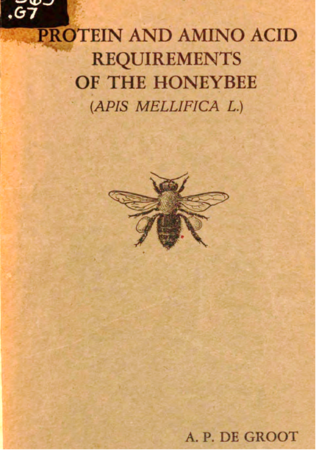
A COMPARATIVE TRIAL OF THE POLLEN SUBS
Part 5: Revisiting de Groot
Beekeeper-Funded Research
Randy Olivera and Vincent Riciglianob
aScientificBeekeeping.com, bUSDA ARS
First published in ABJ November 2021
Any apicultural paper that mentions the amino acid requirements of honey bees references the monumental landmark study by Antonius de Groot published in 1953. But that was early in our scientific understanding of animal nutrition and artificial diets. I have nothing but admiration of de Groot’s work, especially since he was quite clear about the limitations, shortcomings, and interpretation of his pioneering study. However, I feel that it’s perhaps time to reinterpret his findings.
DIVING INTO DE GROOT
De Groot was a brilliant, meticulous, and dedicated researcher, whose monumental work [[1]] is astounding and impressive. I have no criticism whatsoever of any part of his 80-page paper, because as you’ll see, he was very cautious about drawing hard conclusions from what he understood to be pioneering research. The first five chapters of his paper cover the state of knowledge at that time about honey bee and insect nutrition, in which he states that “the knowledge regarding the amino acid requirements of insects is still only fragmentary.”
He reviewed previous research indicating that expeller-processed soybean flour, brewer’s yeast, cow’s milk, and chicken egg were useful components in artificial diets for honey bees. He spent a great deal of time comparing various experimental methods that could be used to determine the nutritional adequacy of a diet, such as the development of the hypopharyngeal glands or longevity of adult caged bees. However, as he explains, “testing for longevity doesn’t tell us the nutrition that bees require to grow from egg to adult.” Ideally, one would study the nutritional requirements for growing larvae through to pupation, but unfortunately, no one had yet figured out a method for growing them on artificial diets.
So de Groot settled upon “studying the growth of just emerged bees on different diets with the aid of weight and nitrogen determinations,” following the findings of Haydak in 1934 (Figure 1).
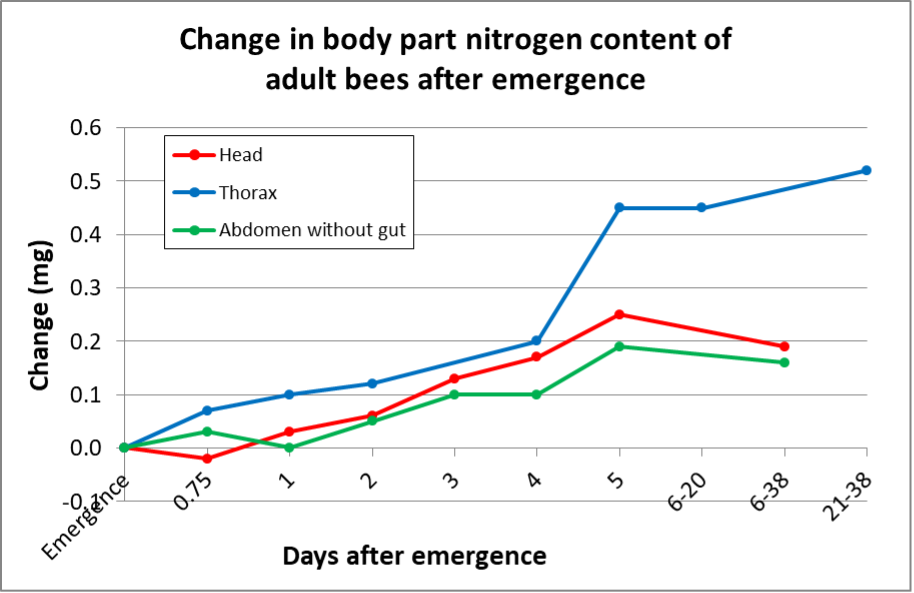
Fig. 1 Newly-emerged worker bees loose in a colony begin consuming some pollen shortly after emergence, and then eat ravenously after around 40 hours [[2]]. During this time they add proteinaceous tissue to their bodies (as measured by nitrogen content) for a few more days, gaining roughly an additional third of nitrogen content over that at emergence. Data plotted from Haydak [[3]].
The above weight gains are largely due to the development of the hypopharyngeal (brood food) glands in the head, the fat bodies in the abdomen, and finally the development of the wing muscles in the thorax.
Practical application: This prodigious rate of tissue growth in the emerged adult worker requires good conversion of the protein from a highly-nutritious diet.
De Groot’s preliminary research indicated that a combination of casein (milk protein) and sucrose alone supplied an adequate diet for worker post-emergence development. This is rather surprising since he didn’t find a need for lipids, sterols, vitamins or minerals in his experimental diets, presumably because the workers emerged with enough body reserves of those nutrients for further development on a diet consisting solely of mixtures of pure amino acids (replicating those in casein) and sucrose.
Practical application: This raises the question of whether testing diets on newly-emerged workers is actually the best test of an artificial diet, since those workers already contain reserves of essential nutrients that they can get by without for some time. I’ll later return to this subject of how we should be testing diets designed to promote colony growth as a whole, rather than only adult bee weight gain.
It isn’t until page 65 that de Groot begins the tests to determine the “Quantitative Amino Acid Requirements” ratios for the growth of newly-emerged workers. With that goal in mind, de Groot measured the changes in dry weight and nitrogen content (as proxy for protein content) of caged newly-emerged worker bees then fed controlled diets. Although they grew best on a diet of natural pollen, they grew nearly as well on diets of “vitamin-free” casein (milk protein). Surprisingly, the biological value (the percent of nitrogen in the diet that was retained in the bees’ body tissue) was greater for the artificial diets than for natural pollen.
Practical application: Although de Groot’s findings were for caged bees and an unnamed pollen, the bees needed to consume far more protein in the form of pollen to obtain the same amount of growth as when the protein or amino acids were provided in pure form. So although pollen is the natural source of nutrition for bees, the protein in an artificial diet may be more efficiently digested and/or utilized.
Then de Groot shifted to using acid-hydrolyzed casein (milk protein) as an amino acid source, and since tryptophan is destroyed during hydrolysis, discovered that it was an indispensable amino acid. From this point on, he fed his test bees diets of sucrose and mixtures of amino acids, in order to determine which amino acids, if lacking, would prevent growth, and then, in a series of meticulous experiments, the minimum amount of that EAA that needed to be added back to allow for “normal” growth.
UNDERSTANDING WHAT DE GROOT DID
De Groot was now ready to move on to determining exactly how much of each individual EAA was required in a diet. He painstakingly measured the increases in dry weight and body protein of samples of caged newly-emerged worker bees fed standardized artificial diets of amino acids (based upon casein), each formulated with up to nine different concentrations of the single amino acid to be tested. To do this, after feeding, he tediously dissected out the alimentary track from the bees in each sample in order to remove any gut contents, dried the remaining bee carcasses, weighed them, and then ran chemical nitrogen analyses. And he did this for a minimum of 8 replicates of 5 bees per test, for all 10 EAAs — nearly 400 tedious tests and analyses in all.
I graphed his data for isoleucine to illustrate how he interpreted his results (Figure 2).
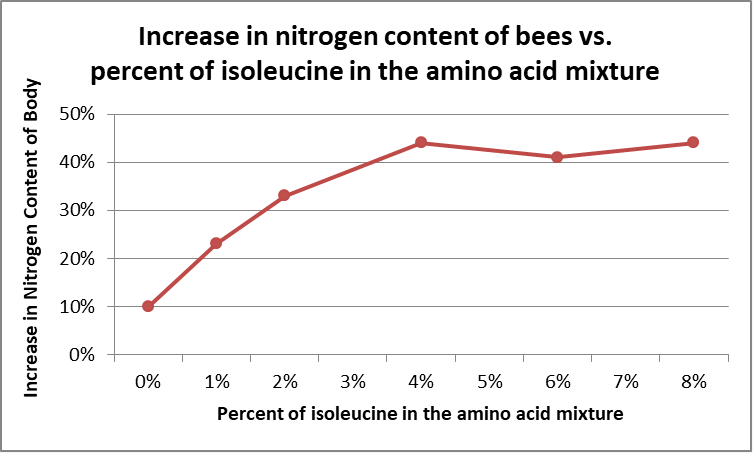
Fig. 2 This graph shows the increase in bee body nitrogen from feeding a diet of sugar supplemented with a mixture of 18 amino acids at 3% of the weight of the sugar, with the proportion of isoleucine (relative to the total amount of amino acids) ranging from zero to 8%. Note the inflection point in the curve at 4% on the x-axis, indicating that there was no benefit to increasing the proportion of isoleucine to above 4% of the total amino acid mixture.
De Groot then plotted graphs for all 10 EAAs (Figure 3):
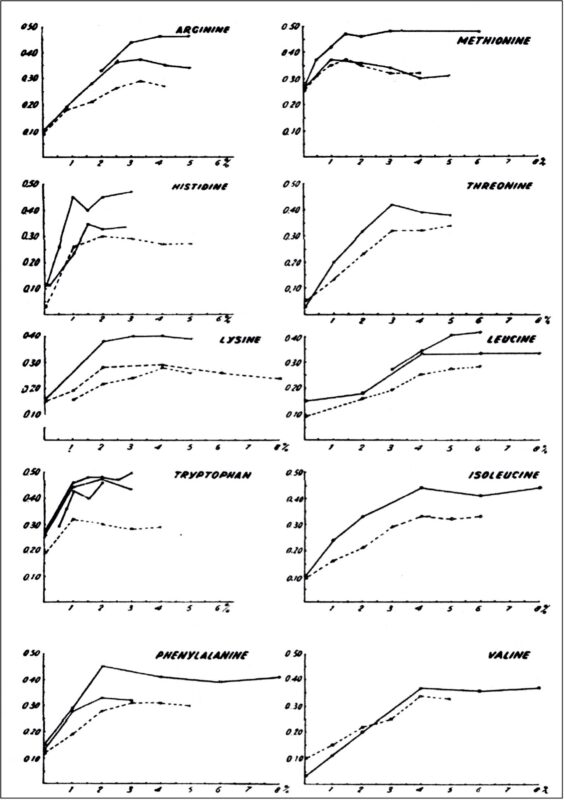
Fig. 3 The principal and most-cited finding from de Groot’s research come from the above chart, with the y-axis indicating nitrogen content, and the x-axis showing the proportion of that amino acid relative to the total. The two lines indicate feeding at either of two amino acid-to-sugar proportions — 2% (dotted) or 3% (solid). De Groot explained, “Each curve shows a rise with increasing concentration until a further increase is no longer accompanied by an upward trend of the curve. In the latter region the concentration is above its minimal level for maximal growth. Obviously, this minimal level is situated near the angle of the graphs.” Source [[1]].
Practical application: The reason that I included the figure above is that these curves are the basis for de Groot’s widely-cited amino acid proportions, the point being that those “hard” numbers were based upon his eyeball interpretation of rather crude data plots.
But those minimal levels also came with an important disclaimer. Allow me to again quote de Groot directly:
It may be emphasized, however, that the observed minimal concentrations for maximal growth have nothing to do with the minimal required intake for maximal growth under natural conditions. They only represent the minimal amounts which, in combination with the amounts of the other amino acids, induce a growth rate maximal under the conditions of these experiments. Even though we are not justified in attaching absolute value to these minimal concentrations, they are valuable in combination with each other. From the minimal concentrations supporting maximal growth, an approximation of a proportionality pattern of essential amino acids can be deduced, supplying information regarding the relative quantities which are required for protein synthesis [boldface mine].
Practical application: De Groot was very clear that his findings should not be taken as gospel, but rather as suggested guidance. And he makes very clear that the oft-cited “minimal level required in honeybee” in his Table 25 [[4]], is not for determining the optimal percentage in a formulated diet, but rather to pay attention to the proportions of the EAAs relative to each other.
But one must keep in mind that in his studies, those levels were estimated from very rough weight gain and body nitrogen content curves of adult bees fed a 2 or 3% (relative to sugar) highly artificial mixture of 18 essential and nonessential amino acids “approximating the composition of casein.” But what is often overlooked is that de Groot himself was clear that bee growth was suboptimal on this diet:
However, it may be noted, that as a result of the concentration of the nitrogen compounds in the diets employed, growth was suboptimal. Whether the same applies to conditions enabling a higher growth rate remains to be investigated. Therefore, we are justified in concluding only, that under the conditions concerned, a ration containing 18 amino acids supported a growth rate equal to that obtained with a comparable amount of casein.
And in fact, bees grew slightly better on an “isonitrogenous” diet of natural pollen. De Groot’s observation that adult bee growth was suboptimal on his experimental diets must be kept in mind. The protein-to-carbohydrate ratio at the highest tested concentration was 3% (1:33). Altaye [[5]], allowing bees to balance their own protein-to-carbohydrate ratio found that bees targeted a 1:12 ratio when the provided protein source was casein. De Groot’s test diets were clearly protein limited.
De Groot also made clear that:
Under the conditions of the above described experiments, the rate of growth is relatively slow as compared with that observed under natural conditions.
He explains that he used the low concentrations of amino acids relative to sugar in order to avoid the toxic effects of protein overload observed in longevity experiments. He also notes that some of the non-essential amino acids may exert stimulatory effects under conditions of “normal” growth — notably serine, glycine, and proline.
Practical application: It is more important to pay attention to de Groot’s proportionality relationships for the EAAs rather than to the absolute values for each EAAs percentage of the total protein as listed in his Table 25.
THE PROBLEM WITH NORMALIZING TO TRYPTOPHAN
Early in his research, de Groot kept having tryptophan come on his radar, mainly because it is destroyed by acid hydrolysis of a protein into its constituent amino acids, and thus needed to be added back in experimental diets. Tryptophan is mentioned 75 times in his study, and by mention 47 he’d already put it at the top of his list of EAAs. So when tryptophan happened to come in at the 1% level, de Groot used that value as “unity” to compare all the other EAA minimal levels to.
Practical application: That arbitrary decision by de Groot to use tryptophan as the reference EAA was unfortunate because the quantification of tryptophan is more difficult than for the other amino acids (since it is destroyed during acid hydrolysis). Therefore, many published amino acid profiles for natural pollens [[6]] and feedstuffs lack a value for tryptophan. But even more importantly, tryptophan is not the major EAA required in bee diets.
We’ve learned a bit about animal nutrition since 1953. So let’s back up a bit.
RE-INTERPRETING DE GROOT’S FINDINGS
Is there a better EAA to use for reference instead of tryptophan? I suggest that we back up 15 pages in his paper. In his preliminary research, De Groot had prepared 17 diets, each deficient in one amino acid, to see how well newly-emerged bees gained weight (Figure 4) or increased nitrogen content (not shown).
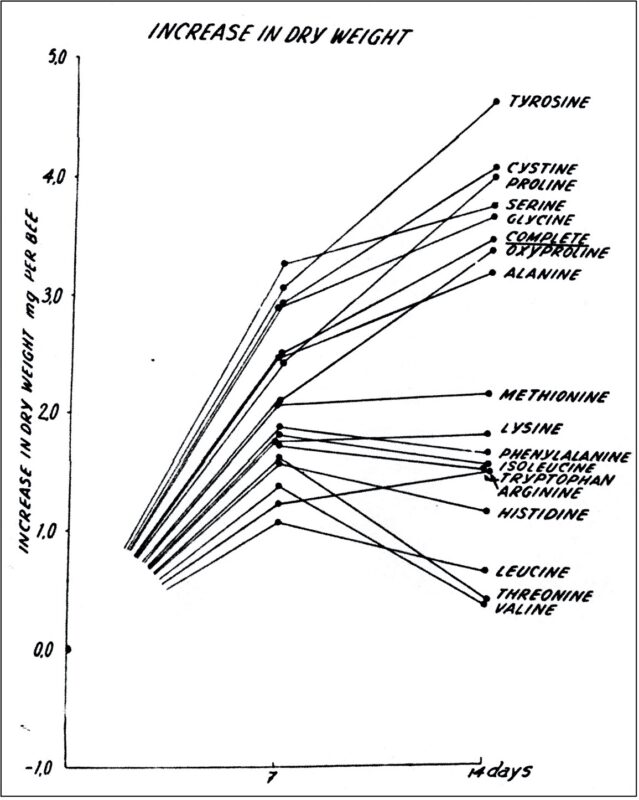
Fig 4 This graph of bee weight in response to amino acid deficiencies is how de Groot determined which amino acids were “essential.” Note how bees grew “normally” in the upper group, on diets lacking any of the non-essential amino acids (“complete” contained all 17), but ceased gaining weight in the lower group, due to those diets lacking one of the ten “indispensable” or “essential” amino acids. Source [[1]].
Practical application: The key take-home from the graph and information above is that bees can grow pretty well for the first week of their lives even with a deficiency of one EAA, but in the second week a deficiency in the most critical amino acids becomes apparent. Note the critical importance of valine, threonine, and leucine (noticing this was my aha moment). Since leucine is the EAA required in greatest proportion in a honey bee diet (and the EAA in highest proportion in all the pollen subs that I tested other than Homebrew), it occurred to me that perhaps we should use leucine, instead of tryptophan, as the reference EAA when analyzing diets for EAA balance (Figure 5).
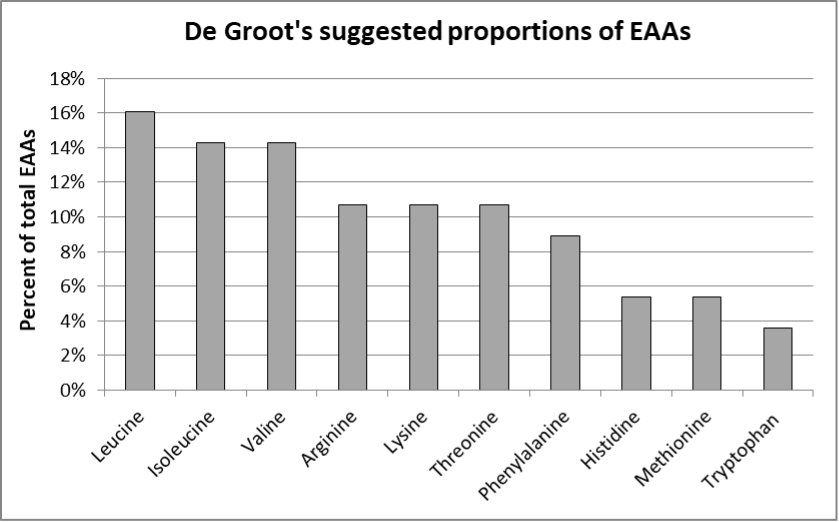
Fig. 5 Leucine is the predominant EAA required for honey bee growth, and thus determines the proportion of total protein that gets utilized. Since it is also the predominant EAA in most feedstuffs used in pollen subs, I propose that it should be the EAA to which we compare the amounts of the other EAAs in order to determine EAA deficiencies.
De Groot’s research suggested that leucine should constitute 16% of total EAAs. Of interest is that of the diets that I tested, the top performers were those that were closest to that percentage (Figure 6).
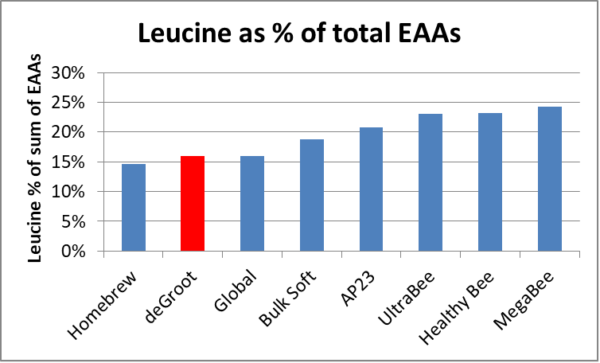
Fig. 6 Is it just by chance that the performance ranking of the tested subs almost exactly followed how close their leucine percentage was to de Groot’s recommendation? Did the poorer-performing diets contained an excessof leucine, or were they instead deficient in the other EAAs?
Practical application: Refer back to Figure 4 to see how important the predominant EAA, leucine, was for bee weight gain. So perhaps what we should be focusing upon is a diet’s ability at converting leucine into bee body mass.
PROTEIN CONVERSION — PATTY INTO BEES
Nutritionists often calculate a diet’s Protein Efficiency Ratio (PER) — the gain in body mass of the fed animal, divided by the amount of protein in the test diet. I didn’t weigh the bee cluster in every hive, nor did most colonies grow in strength during the first half of the trial, but based upon the amount of patties consumed, their protein contents, and the change in cluster size, I could very roughly calculate approximate figures for the efficiency in protein conversion for each test diet to cluster size (Figure 7).
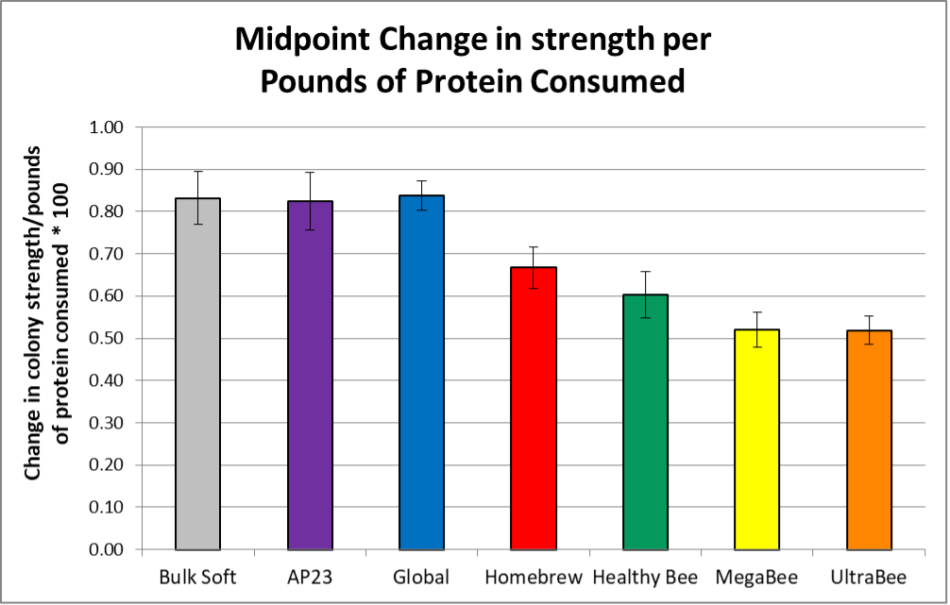
Fig. 7 Please take the results above with a big grain of salt, due to the number of variables involved. But since the error bars for the 18 hives in each test group are really small, the data suggest that the protein in the products to the left (which happened to be the best-performing diets) was utilized more efficiently than in those to the right, at least during the late-summer feeding period.
Practical question: Why was the protein in some diets more efficiently converted into bees than in others? Compare the above graph to Figure 6, and note how diets with excess leucine were poorly utilized. This brings us to the subject of:
JUSTUS VON LIEBIG’S LAW OF THE MINIMUM AND ESSENTIAL AMINO ACIDS
In the late 1800s, the above-named agricultural chemist proposed a groundbreaking concept regarding the fertilization of crops. He pointed out that the most efficient use of nutrients was not to dump on an excess of any one, but rather that the amount of growth is determined by the essential nutrient in shortest supply, whichever nutrient it may be.
Then in the 1930s, W.C. Rose published studies in which they found that it was possible to identify certain amino acids as being “essential” for animal growth [[7]]. Just as von Liebig had realized that optimal plant growth can be attained by addressing any “limiting nutrients,” this concept also applied to the growth of animals, and in our case, to the growth of honey bees and their colonies (Figure 8).
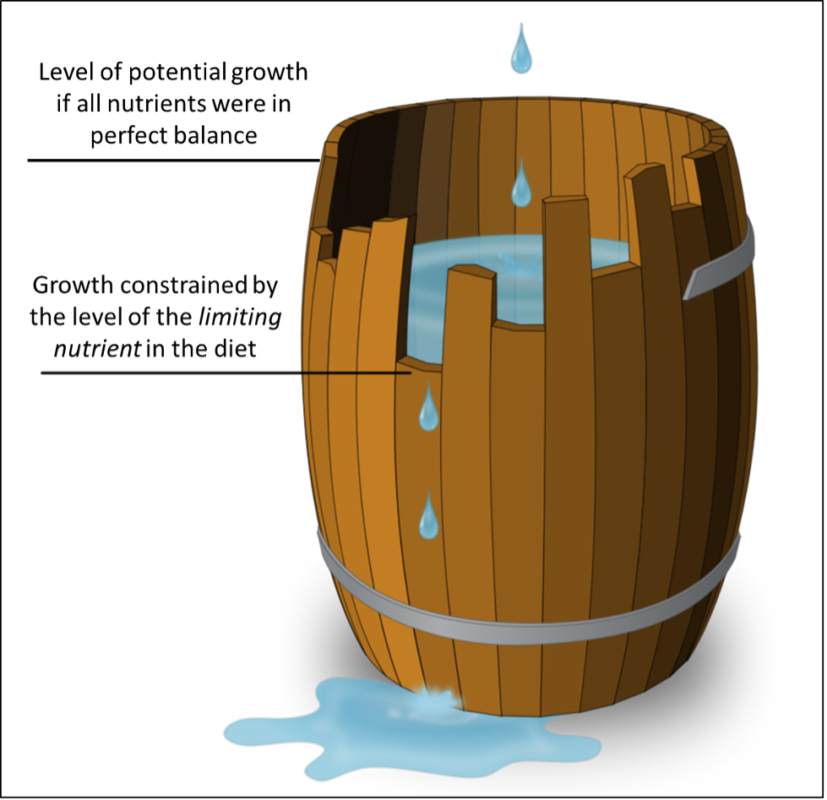
Fig. 8 In the case of honey bee diets and the ten EAAs, imagine the barrel above as having only ten staves, and that a diet in which the EAAs were in perfect balance would fill to the brim. The most important stave would likely represent the predominant EAA, leucine, with the other stave heights representing the proportion of each other EAA if it were in the correct ratio to perfectly complement leucine [[8]]. In diets with an excess of a certain EAA, that stave would be above the maximum fill level (determined by the leucine stave), whereas EAAs in deficit would be below the leucine brim, and not allow full utilization of the leucine.
Practical application: It’s all about providing the optimal “balance” of nutrients, rather than an underutilized excess of any one.
For me to visualize EAA deficiencies, I created a calculator with somewhat similar “staves.” So for example, suppose you made a patty of equal parts of soy flour and brewer’s yeast (plus sugar of course), the EAA ratios would look like the “staves” below (Figure 9).
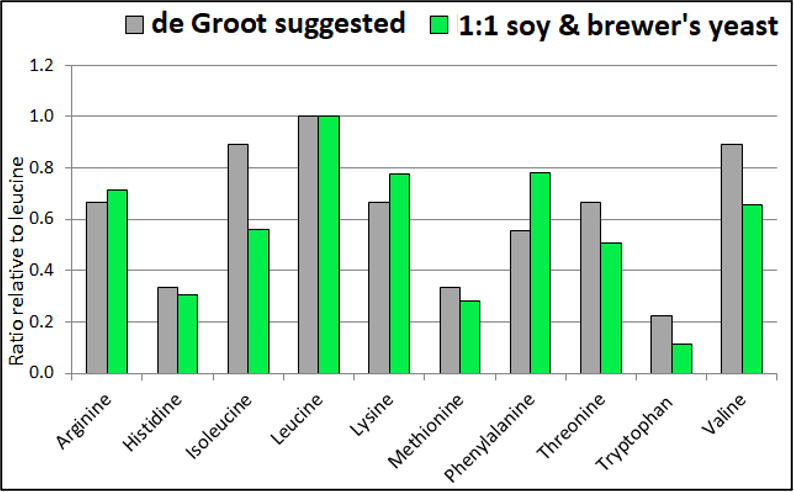
Fig. 9 The EAA proportions of a soy/yeast diet. The gray “staves” represent de Groot’s suggested proportions; the green “staves” represent the proportions in the formulated diet, normalized to leucine. Note the serious deficiencies of isoleucine and tryptophan.
When I looked at the EAA ratios of the diets that I tested in this way, it was obvious that the bees could only fully utilize some fraction of the leucine in each diet, since in every case, some other EAA would have been proportionally limiting.
Curious, I spent hours looking for correlations between the EAA ratios in the diets relative to my measured outcomes. I’d be happy to hear other interpretations [[9]], but what stood out to me was the strong correlation between head & thorax mass at the midpoint, and the sum of the proportional deficiencies in EAAs relative to leucine (Figure 10).
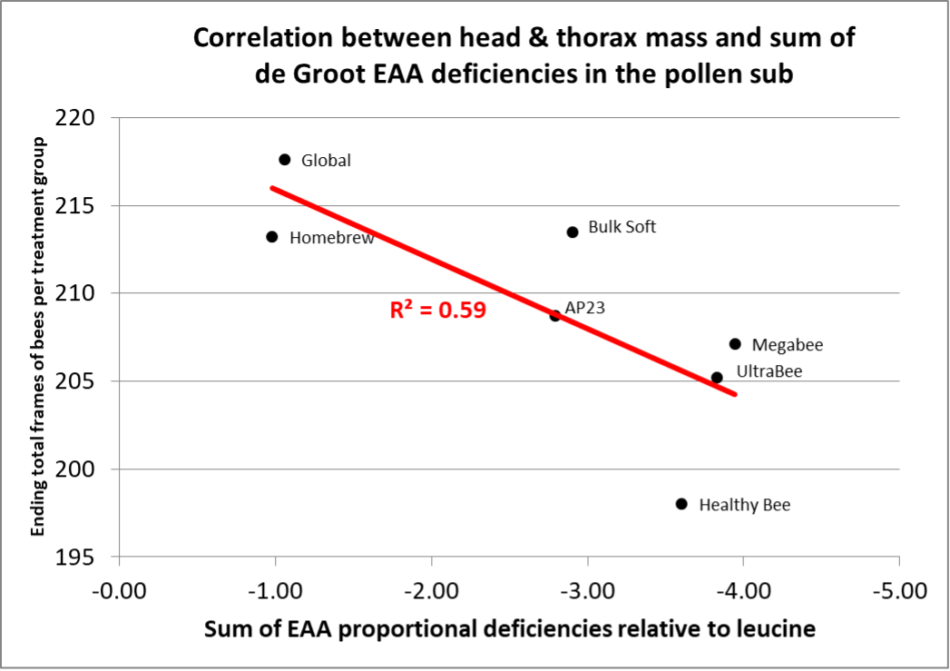
Fig. 10 There was a strong correlation between head and thorax mass at the midpoint compared to the sum of EAA deficiencies relative to leucine (p = 0.0449).
I obtained an even better correlation when I compared total frames of bees in February (Figure 11).
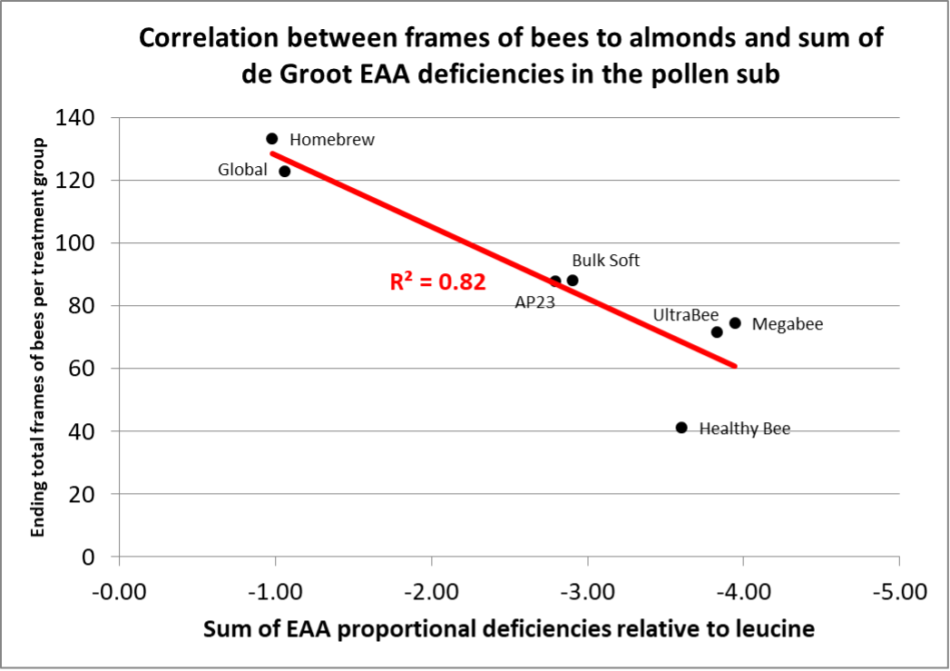
Fig. 11 There was a strikingly close correlation between the number of frames of bees available for almond pollination in each diet group, relative to the sum of the proportional EAA deficiencies in the diets (p = 0.0048).
For the non-statisticians, the R2 (R-squared) value indicates that 82% of the performance of the diets is explained by the independent variable (the sum of proportional EAA deficiencies). The p value indicates that the odds of getting this strong a correlation was less than 5 in 1000. This strongly suggests that we’re onto something important!
Practical application: Liebig’s concept of focusing upon limiting nutrients (in this case EAAs) stepwise, did not result in the best correlations. I obtained the best correlations when I calculated the sum of proportional EAA deficiencies, relative to leucine [[10]]. The take-home seems to be that for best performance, all the EAA deficiencies add up, so we should really strive for balance across the board.
Could we indeed predict the performance of an artificial diet simply from its ratio of EAAs? De Groot’s research suggests yes, as do the results of this trial. Could it be that the EAA ratio relative to leucine is more important than having natural pollen as an ingredient, the protein content or lipid level, or amount of sugar in the diet?
Let me point out an interesting caution from de Groot:
Attention may be drawn to the distinct growth which occurs during the first 7 days on diets devoid of an essential amino acid…It is recognized that in our experiments with suboptimal growth rates, one must be careful in classifying amino acids the omission of which does not result in a perceptible growth inhibition. These compounds, though not required for growth may exert stimulatory effects.
Practical application: For long-term feeding of a colony (as opposed to the feeding of individual bees for short periods), the “balance” between all necessary nutrients likely becomes more important. Perhaps the addition of natural pollen helps, but perhaps it would be unnecessary if an artificial diet were better balanced. Balancing the EAAs appears to be a good starting point!
To that end, I offer a contribution to our industry…
MY DIET CALCULATOR
In order to make it easier for those developing pollen subs, I’ve created an easy-to-use calculator that allows one to add ingredients together to create a diet with EAA ratios to match de Groot’s recommendations, normalized to the predominant EAA, leucine, rather than tryptophan (Figure 12).
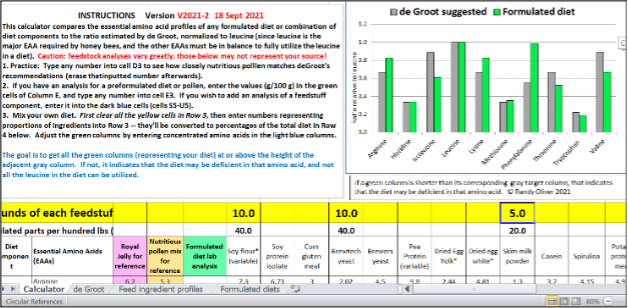
Fig. 12 A partial snip of the calculator. Here’s an example of what the EAA ratio looks like for a 10:10:5 mixture of soy flour, brewer’s yeast, and skim milk powder. Unfortunately, most commonly-available feedstuffs are short in isoleucine, threonine, and valine. You can’t see it here, but the calculator allows one to easily figure out how much of each of those readily-available amino acid concentrates to add in order to balance the green columns to de Groot’s recommendations. The Excel file for the calculator is available at [[11]].
So for comparison, let’s take a look at the EAA ratios of a mixture of natural pollens [[12]] (Figure 13).
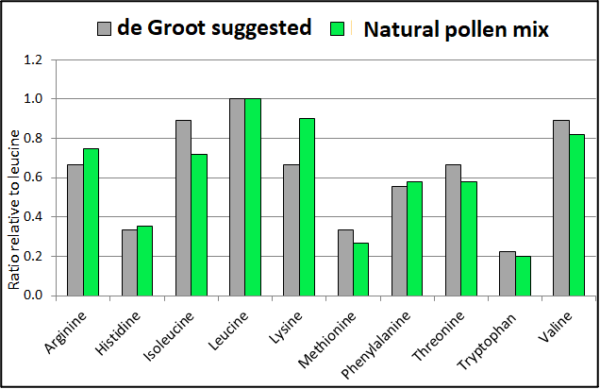
Fig. 13 Not surprisingly (since honey bees and bee-pollinated flowers coevolved), the EAA ratios of a mixture of natural pollens (green columns) closely match de Groot’s recommendations (gray columns).
SO HOW ABOUT THE TESTED DIETS?
Finally we get to the meat (actually just the amino acids) of this study. I used my calculator to create graphs for each of the tested pollen subs (Figure 14).
Fig. 14 For comparison, I placed the ratios for royal jelly at the top, and placed the subs roughly in order of performance top to bottom. Note how the better-performing subs exhibit fewer gross deficiencies in EAAs. For full utilization of the leucine, every tested diet could likely use addition of isoleucine and valine, and some, threonine.
Since I ran this trial for everyone’s benefit, I sent each manufacturer the calculations for the exact amounts of each EAA to add to their formulations to balance them out. I’m very curious as to whether doing so can improve the performance of a diet.
Practical application: I suggest that it’s time for our industry to move beyond the “by guess and by golly” method for formulating pollen subs. Since field trials to test performance are costly and require many hives placed where there is no natural pollen flow, formulating diets based upon EAA nutrient model might be a good first step. I hope to run trials next season to validate this hypothesis.
Since the availability of affordable feedstuffs available for bee diets varies greatly from country to country, I designed my calculator for use by beekeepers worldwide by providing the ability to enter the EAA analysis of anyfeedstuff, as well as the option of adding EAA concentrates. You can download a copy of Randy’s Amino Acid Ratio Calculator at https://scientificbeekeeping.com/7333-2/
THE HOMEBREW FORMULATION
Oh yes, lots of you are likely curious about the ingredients in the high-performing Homebrew formulation. The beekeepers who provided me the patties helped to fund this project, but wish to remain anonymous (I can say that they were assisted by advisor Alisha Taff [[13]]). However, for the benefit of beekeepers everywhere, they are generously allowing me to share their recipe:
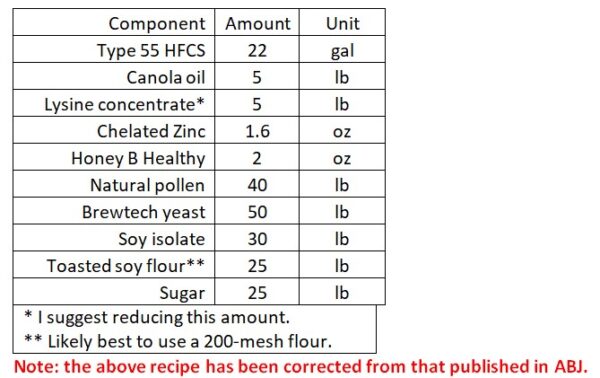
The beekeepers also added a gallon of a seaweed extract from New Zealand [[14]].
NOT YET DONE …
De Groot understood that as monumental as his research was, his suggested EAA ratios may not apply to the most important factor involved in colony buildup — the dietary requirements of the nurse bees for producing the jelly to feed larvae. There may also be separate optimal ratios for the creation of the “storage proteins” necessary for the health and longevity of “winter bees.” I’ll address these subjects in my next article.
REFERENCES
[1] de Groot, A. (1953) Protein and amino acid requirements of the honey bee. Physiol. Comp. Oecol. 3, 197–285.
[2] Hagedorn, H (1967) The rate of pollen consumption by newly emerged honeybees. J. Apic. Res. 6, 159–162.
[3] Haydak, M (1934) Changes in total nitrogen content during the life of the imago of the worker honeybee. J. Agr. Research 49: 21-28.
[4] Please refer to Figure 3 in the previous (October) installment of this series: A comparative trial of the pollen subs Part 4: Why did some subs outperform others?
[5] Altaye, S, et al (2010) Convergence of carbohydrate-biased intake targets in caged worker honeybees fed different protein sources. The Journal of Experimental Biology 213: 3311-3318.
[6] Somerville, D (2001) Nutritional value of bee collected pollens. RIRDC Publication No. 01/047.
[7] McCoy, R. H., Meyer, C. E. & Rose, W. C. (1935) Feeding experiments with mixtures of highly purified amino acids VIII. Isolation and identification of a new essential amino acid. J. Biol. Chem. 112: 283–302.
[8] Which requires dividing its proportion by de Groot’s recommended proportion.
[9] The raw data is available at https://scientificbeekeeping.com/7333-2/
[10] The raw data is available at https://scientificbeekeeping.com/7333-2/
[11] https://scientificbeekeeping.com/7333-2/
[12] Taken from de Groot’s Table 25, which is similar to other pollen data that I’ve found.
[13] https://www.beebiz.net/
[14] https://agrisea.co.nz/
A COMPARATIVE TRIAL OF THE POLLEN SUBS
Part 4:
Why did some Subs Outperform Others?
Beekeeper-Funded Research
Randy Oliver
ScientificBeekeeping.com
Contents
Back to my 2020 california trial
Have we been focusing on the wrong suspects?
Protein in Animal feed formulations
Mixing of protein sources
Crude Protein and Amino Acids
EAAs as percent of crude protein
The eaa requirements of honey bees
References
At first glance, one might conclude that the reason that two of the tested subs performed so well was because they contained natural pollen. But when I looked more deeply into the chemical analyses of the subs, I suspect that it was something else. It may be time to reexamine the protein and amino acid requirements in artificial diets for honey bees.
Since my sons and I no longer truck our bees out of state to better summer pastures, we’ve been dependent upon the feeding of pollen subs to get our colonies in shape for almond pollination. Thus, I’ve had great interest in the improvement of artificial diets for honey bees. Over the years researchers and beekeepers have “tested” (informally or in controlled trials) all sorts of combinations of feedstuff components in free-flying colonies in the field or flight cages, or with newly-emerged bees in incubators, but there has been little high-quality applied research performed along this line since its heyday in the 1970s at the Tucson Lab [[1]].
The testing of pollen sub formulations can be roughly divided into two categories: (1) the “by guess and by golly” throwing together of locally-available diet components to see how the colonies respond (very nicely reviewed by Paray [[2]]), or (2) the more analytical testing of specific diet formulations based upon phagostimulatory components and mathematical nutrient models (which calculate the relative proportions of nutrients required for each stage of an animal’s development) [[3], [4]]. Unfortunately, we still have much to learn about the nutritional requirements of honey bees [[5], [6]].
Practical application: Other livestock industries are light years ahead of our own industry as far as the formulation of artificial diets. I suggest that it’s time for the beekeeping industry to get serious about formulating pollen subs based upon nutrient models.
BACK TO MY 2020 CALIFORNIA TRIAL
I’ve already shown the in-field performance of the tested subs relative to each other. So the question is, why did some perform so much better than others? Since we had the nutritional composition of each sub analyzed, we can perhaps figure out the reasons that some stood out.
Some factors that did not appear to be important:
- Phagostimulatory value: Although some subs were clearly more phagostimulatory than others, the bees consumed all tested diets adequately.
- Sugars and sugar content: This did not appear to be a deciding factor. Research by Doulle [[7]] indicates that a mixture of sugars is well-accepted by bees.
- Lipids and sterols: The requirements for lipids in the diet are not clear, since insects are able to synthesize lipids from carbohydrates [[8]]. Surprisingly, Robinson [[9]] found that a colony is able to maintain apparently normal brood development for more than 50 days on a diet of pollen from which the lipids had been extracted by solvents. To the point, the best-performing diets had some of the lowest lipid concentrations of all the diets in the trial. As far as sterols, bees are also able to convert other plant sterols into the 24-methylene cholesterol that they require, and I’ve previously found no benefit to supplementing canola oil with that sterol [[10]].
- Vitamins and minerals: We just don’t know that much about this subject. I previously found no benefit to supplementing a diet with the critical trace element zinc [[11]].
- Natural pollen and the gut microbiome: We all love to think that “natural” is better, but two of the subs lacking natural pollen performed quite well. Not only that, but the community structures of the bee gut microbiomes were similar for all tested subs, whether they contained pollen or not. In fact, the bees consuming the best-performing sub had one of the lowest populations of gut bacteria of all. A recent study about the importance of symbiotic bacteria for solitary bees [[12]] has beekeepers in a tizzy about gut microbes, but research by Chikaraishi [[13]] indicates that honey bees are not actually dependent upon their gut microbes for their nutrition.
- Crude protein (CP) content: Doug Somerville, in Fat Bees, Skinny Bees states that “When colonies collect very little pollen, whatever its CP% or when the CP% is below 20% whatever the volume collected, the colony will exhibit a protein deficiency by reducing the area of brood being reared.” And Herbert [] determined that the optimal protein concentration of an artificial diet was around 25% [[14]]. So it was a bit surprising that three of the best-performing subs had CP levels down in the 14-17% (wet weight) range. That fact got me looking more deeply into the details of the protein in the subs.
HAVE WE BEEN FOCUSING ON THE WRONG SUSPECTS?
Since none of the usual suspects seem to have made much difference, it leads me to question whether we’ve been barking up the wrong trees. What if the most important thing about pollen subs was something else? The thing in the lab analyses of the subs that jumped out at me were the proportions of the amino acids in the protein.
PROTEIN IN ANIMAL FEED FORMULATIONS
In order for any animal diet to allow for growth, it must contain protein; the same applies to honey bee colonygrowth. Protein is generally the most costly component of a diet, so manufacturers look for the least expensive sources. Formulated diets typically contain more than one protein source, combined to balance their amino acids in order to obtain the best net protein utilization by the animal. Allow me to quote from Wikipedia [[15]]:
It is therefore a good idea to mix foodstuffs that have different weaknesses in their essential amino acid distributions. This limits the loss of nitrogen through deamination and increases overall net protein utilization.
Various attempts have been made to express the “quality” or “value” of various kinds of protein. Measures include the biological value, net protein utilization, protein efficiency ratio, protein digestibility-corrected amino acid score and complete proteins concept. These concepts are important in the livestock industry, because the relative lack of one or more of the essential amino acids in animal feeds would have a limiting effect on growth and thus on feed conversion ratio. Thus, various feedstuffs may be fed in combination to increase net protein utilization, or a supplement of an individual amino acid (methionine, lysine, threonine, or tryptophan) can be added to the feed.
Practical application: All the above concepts are important for the formulation of pollen subs. A common question is, why not feed concentrated protein to colonies? The answer is that it’s all about the protein to carbohydrate ratio [[16]]. Too much protein in a pollen sub can result in greater worker body mass, but can also be metabolically toxic and reduce worker longevity, as evidenced by a well-performed field trial by Zheng [[17]]. Since the manufacturer can’t know whether the beekeeper will be feeding supplemental sugar along with the pollen sub, it would be wise for them not to exceed ~25% protein on a dry matter basis. In general, it is likely good idea to feed sugar syrup to colonies along with pollen sub.
PROTEIN MIXING BY THE BEES THEMSELVES
Natural pollens vary greatly in their essential amino acid ratios, with only a few being in the optimal proportions for honey bee growth. Although some researchers have proposed that forager bees (which don’t consume pollen themselves) can somehow detect the essential amino acid and fatty acid compositions of pollens, and then adjust which flower types to forage on in order to balance overall colony nutritional intake, I find this proposition to be largely based upon wishful thinking and confirmation bias. A more parsimonious behavioral method was posited by Eckhardt [[18]], who suggests that generalist bees simply haphazardly collect a variety of pollens, which are then likely to balance each other out by chance.
I and others have observed that some pollens, when offered in cups in the field are far more attractive to foragers than others. But despite that observation, looking at the incoming pollen loads of my colonies, I suspect that Eckhardt is correct, and that the honey bee has evolved the behavior for foragers to simply collect a diversity of pollen types when available (Figure 1).
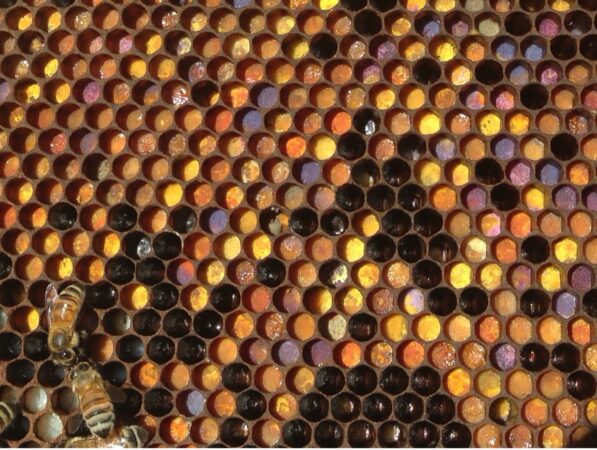
Fig. 1 Although nectar foragers may focus upon the most “cost effective” nectar sources at the moment, the pollen foragers appear to seek out a diversity of pollens for the nurse bees to consume and convert into jelly.
I’ve also found that foragers clearly prefer some protein feed components over others (Figure 2).

Fig. 2 Some years ago I tested forager preferences for various dry pollen sub powders, and found that foragers exhibited clear preferences. Surprisingly, they really went for purified soy protein isolate, which had no odor that I could detect. However, I’m not convinced that forager preference has anything to do with nutritional value, especially since I also observe foragers enthusiastically gathering sawdust when nothing else is available.
Practical application: The “preferences” of foragers may not reflect the nutritional needs of the nurse bees that actually consume and digest the pollen or artificial diet. Vanessa Corby-Harris has shown the even the nurses either cannot or do not assess the nutritional value of the pollen that they choose to consume[[19]]. So it’s up to us to formulate artificial diets that are both attractive to the nurses, as well as nutritionally balanced.
CRUDE PROTEIN AND AMINO ACIDS
Since protein is the most important component of a pollen sub, this brings us to the subject of essential amino acids. Animals use some 20 naturally-occurring amino acids to create all the thousands of proteins used in their bodies. Depending on the species of animal, 10 or 11 of those amino acids are “indispensable” or “essential,” since the animal is unable to synthesize them de novo. We refer to them as essential amino acids (EAAs).
Note: Henceforth in this article I will refer to the ten essential amino acids as “EAAs.”
That said, animals don’t grow well on a diet of EAAs alone — they require additional crude protein or other amino acids (such as serine, glycine, and proline) in their diet in order to maintain growth. Indeed, proline is the predominant free amino acid (not tied up in a protein) in honey bee haemolymph [[20]] and royal jelly [[21],[22]].
Practical application: I’ve long been curious as to whether proline would be a useful addition to bee diets. Proline is readily available in the “collagen peptides” sold as a human protein supplement.
Some protein sources (such as chicken egg or cow’s milk) are termed “complete proteins,” since they (not surprisingly) contain all the amino acids, in the right proportions, necessary for the full and rapid growth of developing chicks or calves, respectively.
Practical application: The protein extracts of egg or milk are albumen or casein, respectively. Both work well as protein sources for caged bees, and are sometimes incorporated into pollen subs (and in other formulated insect diets)[[23]]. But both, being animal-derived, are more expensive than plant protein options. Unfortunately, the amino acid ratios of most plant proteins are not in the correct proportions for optimal animal utilization, and, as mentioned above, must be combined with other protein feedstuffs in order obtain the optimal balance of EAAs.
EAAS AS PERCENT OF CRUDE PROTEIN
In general, the EAAs should constitute roughly 30%-50% of the crude protein content of an animal diet (this is the same range as occurs in honey bee body protein, natural pollens, and royal jelly). All the tested pollen subs in my trial were at the upper end of this range (either these producers did their homework, or just got lucky) (Table 1).
But that 50% level is contingent upon the EEAs being in the right proportions relative to each other. Since protein is generally the most expensive component in an artificial diet, the livestock and pet industries reduce diet cost by minimizing total crude protein and carefully balancing the essential amino acids in “precision diets,” supplementing any deficient EAAs with concentrates [[24]].
Practical application: The “net protein utilization” of a diet is profoundly affected by the limiting amino acid— the one in shortest supply. However, the precise optimal proportions of the EAAs is not cut and dried, since some of the other amino acids can be “conditionally essential,” or exhibit “sparing effects.”
THE EAA REQUIREMENTS OF HONEY BEES
It wasn’t until the early 1900s that researchers started to seriously study animal nutrition. By the late 1940s, the Committee on Animal Nutrition concluded that the most appropriate way to express a nutrient requirement was as the minimal dietary concentration required to support normal performance of the most demanding function [[25]]. But even by the 1950’s the study of animal nutrition was a nascent science, with researchers using painstaking chemical, radiolabeling, and other analytical methods to figure out critical nutrients, and the optimal proportions of them in animal diets. A number of labs (notably the USDA-ARS bee research lab at Tucson during the 1960s through 1980s) did extensive and informative studies, and Dr. Geraldine Wright has in recent years presented on her published and yet-unpublished findings.
In 2008, Behmer in his review of insect nutrition [[26]], explains that:
The qualitative nutritional requirements of insects are very similar to other animals as the basic chemical composition of their tissues and their metabolic processes are generally the same.
Much of what we know about insect nutrition comes from studies using artificial foods, and in general there are three main approaches to understanding insect nutritional requirements. The most common is the deletion method, which measures the effect of eliminating one specific component from a chemically defined artificial diet and then measuring whether the insect can develop on the modified diet under sterile conditions. Once the deletion method identifies which nutrients are essential, the substitution method can be used to test whether analogues of these nutrients also support development. Finally, radiolabeled precursors can be fed to insects to determine which nutrients insects are able to produce endogenously.
That said, most of what we know about the amino acid requirements of honey bees comes from a groundbreaking study by Antonius de Groot, in which he used the deletion method mentioned above [[27]]. Our beekeeping industry, ever on the cutting edge, generally formulates their diets to match those suggested by de Groot’s oft-cited Table 25, published in 1953 (Figure 3).
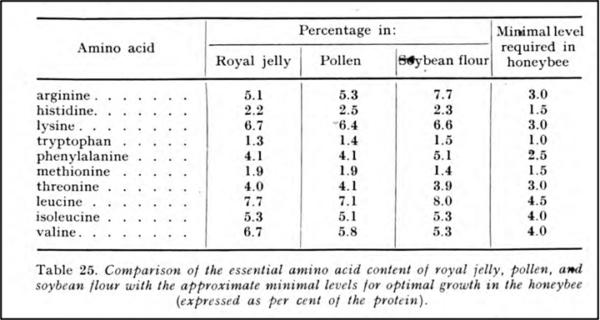
Fig. 3 Based upon meticulous studies of caged newly-emerged worker bees, de Groot suggested the required minimal levels of the EAAs in a honey bee diet, standardizing them in ratios relative to tryptophan.
If we look at the EAA analyses for the diets I tested, they all exceed the minimal requirements indicated in the last column of de Groot’s table (Figure 4).
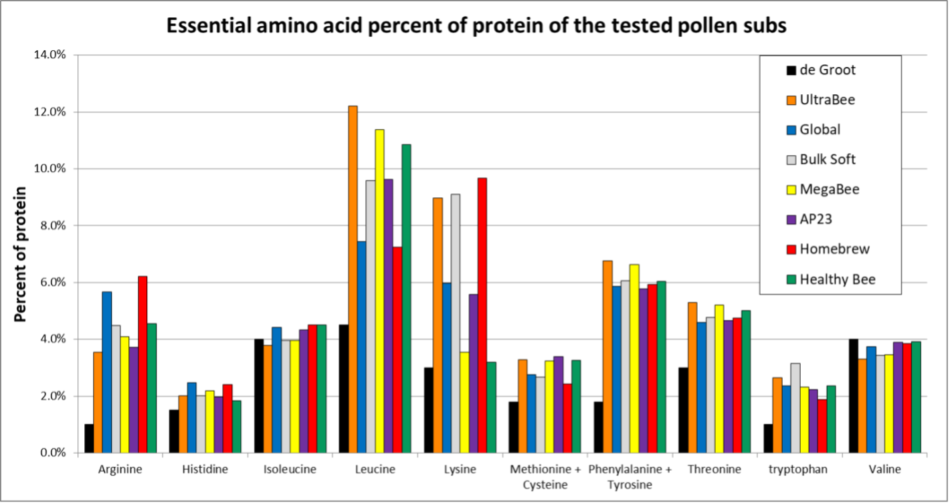
Fig. 4 Relative to de Groot’s minimal recommendations (black columns), all the tested subs had very good EAA profiles, with none appearing to be appreciably deficient in any EAA. But also note that all the diets contained about twice as much tryptophan and leucine as suggested by de Groot.
Practical application: The striking excess of two important EAAs was a red flag to me, and raised a question — did all the diets contain excesses of tryptophan and leucine, or were they instead deficient in the other EAAs, relative to tryptophan or leucine?
Also note the discrepancy with regard to the current widely-accepted recommendation that EAAs constitute 50% of total protein — the EAAs in de Groot’s table add up to only 25.6% of the protein in the diet. Not only that, but de Groot himself pointed out that the test diets that he used contained too little protein for maximum growth.
Practical considerations: The above observations should give us all pause when making the jump from optimal ratios of EAAs to percentages in the diet. I suspect that for optimal nutrition, we’d need to double the minimal levels indicated in de Groot’s Table 25.
Should we question de Groot’s recommendations? I’ve studied de Groot’s monumental and detailed research at length; let me say that I’m in awe of the amount of painstaking and detailed research that he performed over a period of years. His paper is some 80 pages long, and I suspect that most who have read it didn’t give it the scrutinization that it deserves. So next month we’ll do a deep dive into it, and I will reinterpret his findings with regard to the performances of the pollen subs that I tested.
REFERENCES
[1] Work by Haydak,Herbert, Standifer, Shimanuki, and others. More recently by Wardell and Ahumada-Segura.
[2] Paray, B, et al (2021) Honeybee nutrition and pollen substitutes: A review. Saudi Journal of Biological Sciences 28: 1167-1176.
[3] Cohen, A (2015) Insect Diets. CRC Press.
[4] https://www.nutritionmodels.com/
[5] Wright, G, et al (2018) Nutritional physiology and ecology of honey bees. Annual Review of Entomology, 63(1): 327–344.
[6] Brodschneider, R & K Crailsheim (2010) Nutrition and health in honey bees. Apidologie 41: 278–294.
[7] Doull, K (1974) Effect of attractants and phagostimulants in pollen and pollen supplements on the feeding behaviour of honeybees in the hive. Journal of Apicultural Research 13(1): 47–54.
[8] Arrese, E & J Soulages (2010) Insect fat body: energy, metabolism, and regulation. Annu Rev Entomol. 55: 207–225.
[9] Robinson, F & J Nation (1966) Artificial diets for honey bees, Apis mellifera. The Florida Entomologist 49, (3): 175-184.
[10] https://scientificbeekeeping.com/an-experiment-to-improve-pollen-sub-1/
[11] Op. cit.
[12] Dharampal, P, et al (2020) Microbes make the meal: oligolectic bees require microbes within their host pollen to thrive. Eological Entomology 45(6): 1418-1427.
[13] Chikaraishi, Y, et al (2011) 15N/14N ratios of amino acids as a tool for studying terrestrial food webs: a case study of terrestrial insects (bees, wasps, and hornets). Ecol Res 26: 835–844.
[14] Herbert, E, et al (1977) Optimum protein levels required by honey bees (Hymenoptera, Apidae) to initiate and maintain brood rearing. Apidiologie 8(2): 141-146.
[15] https://en.wikipedia.org/wiki/Essential_amino_acid
[16] Paoli, P, et al (2014) Nutritional balance of essential amino acids and carbohydrates of the adult worker honeybee depends on age. Amino Acids 46:1449–1458.
[17] Zheng, B, et al (2014) The effects of dietary protein levels on the population growth, performance, and physiology of honey bee workers during early spring. Journal of Insect Science 14: 1-7.
[18] Eckhardt, M, et al (2014) Pollen mixing in pollen generalist solitary bees: a possible strategy to complement or mitigate unfavourable pollen properties? Journal of Animal Ecology 83: 588–597.
[19] Corby-Harris, V, et al (2018) Honey bee (Apis mellifera) nurses do not consume pollens based on their nutritional quality. PLoS ONE 13(1): e0191050.
[20] Crailsheim K & B Leonhard (1997) Amino acids in honeybee worker haemolymph, Amino Acids 13, 141–153.
[21] Emanuele Boselli, E, et al (2003) Determination and changes of free amino acids in royal jelly during storage. Apidologie 34 (2):129-137.
[22] Barker, R, et al (1972) Proline in Royal Jelly of Honey Bees. Annals of the Entomological Society of America 65(5): 1236–1237.
[23] https://insectrearing.com/insect-diet-ingredients/
[24] Kidd, M, et al (2021) Progress of amino acid nutrition for diet protein reduction in poultry. J Animal Sci Biotechnol 12: 45.
[25] Ullrey, D (2001) Landmark and Historic Contributions of NRC’s Committee on Animal Nutrition in National Research Council 2001. Scientific Advances in Animal Nutrition: Promise for the New Century: Proceedings of a Symposium. Washington, DC: The National Academies Press. https://doi.org/10.17226/10299.
[26] Behmer S.T. (2008) Nutrition in Insects. In: Capinera J.L. (eds) Encyclopedia of Entomology. Springer, Dordrecht. https://doi.org/10.1007/978-1-4020-6359-6_2277
[27] de Groot, A. (1953) Protein and amino acid requirements of the honey bee. Physiol. Comp. Oecol. 3, 197–285. Unfortunately, this paper, which is required reading for anyone seriously interested in honey bee nutrition, is not readily available online.
Observations on Pollen Subs:
Part 3
Placement of the Pollen Patty
First published in ABJ October 2021
Randy Oliver
ScientificBeekeeping.com
There doesn’t appear to be a benefit from feeding pollen sub when there’s already a substantial natural pollen flow going on. On the other hand, during a dearth, pollen subs may perform better when the foragers are still able to bring in a small amount of natural pollen. The question then is, why would that small amount of pollen make a difference?
A number of field trials of pollen subs have shown that if colonies are fed pollen sub when there is a natural pollen flow occurring, that there may be little benefit from providing an artificial diet [[1], [2]], or even patties of natural pollen [[3]]. But as the results of this trial show, many of us in the West gain great benefit from feeding pollen sub during certain periods of pollen dearth, such as in autumn and early spring.
But “pollen dearth” is a relative term. I was speaking with a fellow beekeeper the other day about feeding pollen sub, and my ears perked up when he noted that his colonies respond to pollen sub much better when there is also a light natural pollen flow going on — something that I’ve also noticed. So what exactly does that small amount of natural pollen coming into a hive provide when there is already a surplus of artificial diet being fed?
Marketers have done a great job at convincing us that “natural” is always better. So it’s tempting to jump to the conclusion that the little bit of incoming natural pollen provids some missing critical nutritional elements. But in the case of my friend, he already includes 5% natural pollen in the patties that he feeds, which would provide those missing elements.
Practical application: In this field trial, despite feeding up to 12 pounds of pollen sub formulations containing 15-20% natural pollen, those colonies still barely grew during the extreme pollen dearth over the course of the trial.
So I suspect that something else other than some missing “natural” nutrient is involved. Perhaps we should look somewhere other than at nutrition alone, and instead think about bee behavior in response to environmental cues. Simply providing a natural-pollen-rich patty to a colony doesn’t ensure that the colony will respond by expanding the broodnest. But the addition of a little bit of incoming natural pollen may kick the colony into broodnest expansion mode. Perhaps we should try to figure out what cue that pollen brought in by the foragers provides to trigger the colony to expand brood rearing in response.
THE NURSES RUN THE SHOW
The question to ask may then be, who makes the decision to expand the broodnest? Queens often continue to lay plenty of eggs during a pollen dearth, but are followed by nurse bees who, when unable to produce enough jelly, consume those eggs to recycle the protein, asnicely explained by Heather Mattila [[4]]:
It seemed as though the queen was continually laying eggs within the cluster in early spring, but whether the eggs were reared to the sealed brood stage depended on the availability of pollen to the workers in the colony. This hypothesis is supported by the observations of Imdorf et al. (1998), who reported the presence of eggs in pollen-stressed colonies that lacked open brood, and by Schmickl et al. (2003), who observed that the queen did not adjust her rate of egg laying when they created artificial pollen shortages in an observation hive, despite large changes in brood demography. It makes sense that eggs would continue to be laid by the queen when colonies have restricted access to pollen because their presence in the colony represents relatively little nutritional investment, but provides an opportunity to rapidly recommence brood rearing once favorable conditions return.
This culling and recycling of eggs and larvae by the nurses has been termed “brood trimming” by Larry Connor[[5]], and demonstrates that it is the nurses, rather than the queen who actually run the show, since they are the ones that produce jelly — the currency of protein for the entire colony. It is the nurses who decide who gets fed, and who does not. In late summer, my sons and I monitor our colonies for the amount of jelly that the nurses place around young larvae. Time and again we observe an immediate increase in the amount of jelly when we provide pollen sub. But that increase is still not the same as when the foragers are bringing in a lot of pollen. Could the difference in response be due to where the pollen or patty is placed?
THE PLACEMENT OF THE POLLEN
In my recent conversation with my beekeeping buddy, he said that he has greatest success with feeding soft bulk patty, rather than preformed patties in waxed paper. I observe the same (Figure 1).

Fig. 1 A number of us Western beekeepers prefer to feed chunks of “soft” patty that will squish between the frames, especially upward between the bottom bars. Could it be that providing the feed closer to the cells of brood makes a difference?
THE PROBLEM WITH “SURVIVORSHIP BIAS”
We beekeepers are familiar with the look of the textbook brood frame, having an ellipse of brood in the lower middle, a band of beebread around the brood, and then honey above and to the sides (Figure 2).
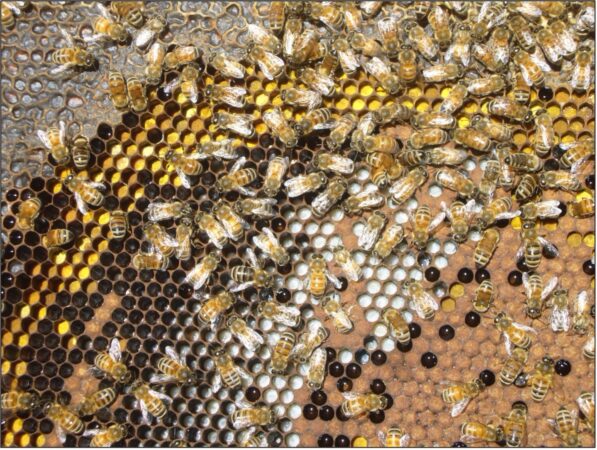
Fig 2. A textbook example of how honey, beebread, and brood are arranged on a comb. But no bee has ever seen this view (it’s dark inside the hive). And just because we commonly see beebread in an arc around the brood, that doesn’t mean that that’s the pollen the nurses pay attention to.
The location of the band of beebread is a perfect example of “survivorship bias,” leading to the erroneous conclusion that pollen foragers preferentially store incoming pollen there. In reality, that band of beebread represents the leftovers — surplus pollen that was not immediately consumed by the nurses. In a well-nourished, rapidly-growing colony on a moderate pollen flow, there may not be any beebread showing around the brood at all.
Practical application: In this case it’s not what we humans see that’s important to the nurses, it’s what we don’t see. In Figure 2 notice the pollen scattered between the cells containing eggs or sealed brood. That’s the pollen that will be first consumed by the nurses. Any pollen in the “pollen band” is surplus beyond the needs of the nurses, and is fermented into beebread for storage.
The classic example of survivorship bias occurred during World War II, when the Air Force recorded the locations of bullet holes in the bottoms of returned aircraft (Figure 3).
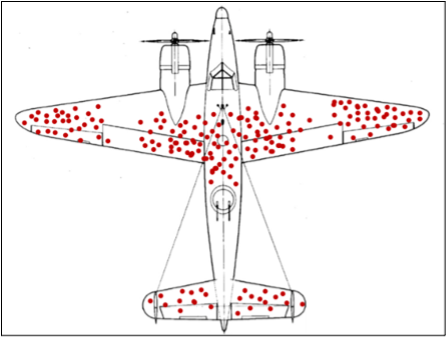
Fig. 3 Mechanic’s notations of where bullet holes were found in planes after bombing missions over Germany. The brass interpreted that to mean that those were the areas calling for reinforcement. But mathematician Abraham Wald pointed out the error of survivor bias, since they were only recording the presence of bullet holes in planes that made it home (the survivors). The important places to armor were the areas lacking bullet holes. Image from Wikipedia.
It’s the same thing with the pollen band on a brood frame. A rapidly-growing colony may not contain any pollen band at all if the nurses are consuming every bit of incoming pollen. The only thing that a pollen band indicates is that there is a temporary surplus of pollen in the hive, left over after the nurses have already consumed their fill.
THE CUE TO THE NURSES THAT A POLLEN FLOW IS OCCURRING
There are several very interesting studies on the interaction between where incoming pollen foragers place their loads, and where nurse bees look for pollen to consume.
In 1969, Doull found that the effective olfactory range of the nurse bees was less than 2 inches [[6]]. And then in 1974 [[7]], using an elegantly simple experimental design, he demonstrated the profound effect of distance from brood for nurse bee response to offered patty of natural pollen (Figure 4).
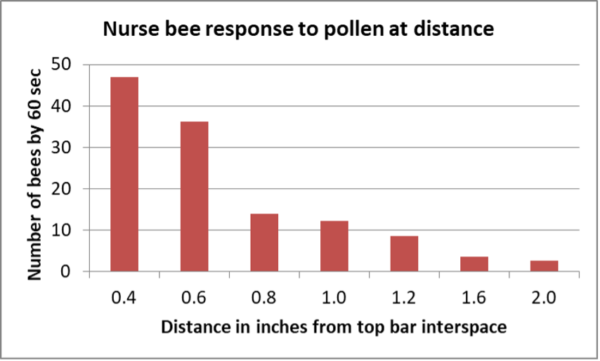
Fig. 4 Note how the response of nurse bees to placed pollen rapidly drops off at even very short distance. (Graph plotted from data from Doull).
Wow! Even two inches of distance makes a huge difference to the nurses, who need to find pollen in the darkness of the hive by their sense of smell.
Doull suggested:
These findings have some implications in the use of pollen for feeding to bees in the hive. Pollen stored around the brood would normally be within the critical distance, or would be located by bees after only a short period of random movement. Pollen stored in outer combs of the hive, however, would be accessible only to those bees that moved away from the brood area. It may well be that, in the main, pollen stored in outer combs will be used only when the brood nest expands to combs near it.
During a substantial pollen flow, one can often observe how the foragers place pollen right in the middle of the brood area (Figure 5).
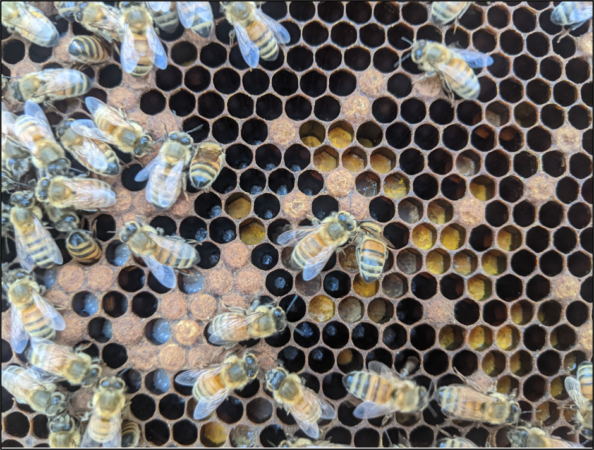
Fig. 5 This pollen placed adjacent to hungry larvae may well disappear overnight, as it is preferentially consumed by the nurse bees. The ease with which the nurses find pollen appears to be the cue that there is a pollen flow going on, indicating that the colony can go into buildup mode.
Note that the pollen in Figure 5 is placed adjacent to older larvae about to be capped. In 1973 Steve Taber [[8]] had things to say about this:
The data indicate that there is a pollen consumption area. As the eggs hatch, the growing larvae are fed more and more. Queens have a tendency to place eggs in adjacent cells if these are available, rather than laying in a random fashion throughout the brood area. As the groups of larvae mature, the consumption of pollen located near larvae aged 5 and 6 days would probably be so rapid that no incoming pollen would or could accumulate in that part of the hive.
My bees are maintained under intensive management for queen and drone rearing and are given more than 40 kg of pollen per colony each year. Therefore, when I hear that bees will not eat the pollen they are offered, I conclude only that the pollen was placed unsuitably in the hive. Unless placed within 4-6 cm of the brood area, the pollen will be taken very slowly or not at all …
The usually accepted hypothesis concerning pollen in combs is that the pollen is stored and consumed in a band around the brood area (Farrar, 1963). My hypothesis is that the belt or band of pollen which surrounds the brood nest during periods of pollen surplus is an area of non-consumption. Since pollen is consumed in the areas of unsealed brood, most new incoming pollen is consumed there. Thus, there is little or no chance of any pollen accumulating inside the brood area.
In 1977 Jerzy Woyke studied brood cannibalism [[9]], noting the higher rate of cannibalism of young larvae in autumn over that in summer.
The higher survival rate of brood when the pollen supply was good, and in colonies to which pollen combs were added … suggests that shortage of pollen releases cannibalism in the honeybees … Pollen may be available in one comb, and not in another, or even in another part of the same comb. So the bees with no pollen nearby, eat brood instead, and are thus able to produce food for the queen and for larvae.
One of my favorite researchers, Scott Camazine, in 1991 rejected the “blueprint hypothesis” and instead laid out a beautiful explanation (self-organizing pattern formation) of how individual bees working in the dark create the textbook arrangement of brood combs, without any bee being aware of a “blueprint” [[10]]:
Each day honey and pollen from tens of thousands of foraging trips are deposited into the cells, stores of honey and pollen cells are continually consumed, hundreds of eggs are laid, mature adult bees emerge from their cells, and diseased brood is removed. Despite the regular turnover in which cells are often refilled with something other than what they recently held, the stability of the pattern is maintained … there is no blueprint to specify locations for brood, pollen and honey; the dynamic relationships among the component processes of deposition and removal are sufficient to organize a pattern on the combs.
Camazine brought up the concept of “interface zones,” which were an aha concept for me for hive inspections and learning to “read the combs” [[11]].
Practical applications:
- Fresh pollen, randomly placed by returning foragers in the cells throughout the broodnest, allows the nurses to produce abundant jelly.
- The ease with which the nurses find fresh pollen next to the brood that they’re feeding cues them to feed, rather than consume young larvae, thus putting the colony into “buildup mode.”
- The presence of a pollen band indicates that there is a surplus of incoming pollen. The inner edge of that band indicates the distance from the brood that the nurse bees needed (or were willing) to travel until they got their fill.
- All the above findings indicate the importance of placing supplemental pollen or artificial diet as close to cells of brood as possible.
- Fresh nectar is also placed throughout the broodnest by mid-age nectar receivers, again providing the nurses with necessary sugar, and the huge amount of water necessary to produce jelly (I’ll discuss this in my next article).
BACK TO MY TRIAL
The colonies in my trial, despite being provided pollen subs ad libitum, generally failed to grow during the late summer and fall. But this is not to say that they weren’t continually rearing brood – just not to enough extent to expand their populations (Figure 6).
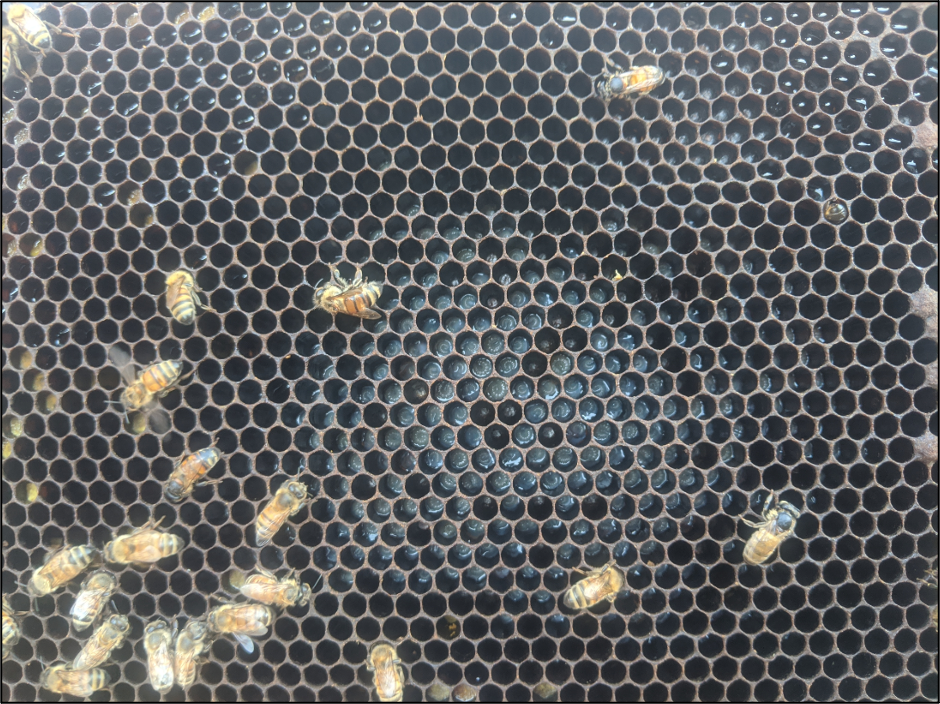
Fig. 6 This photo of a brood comb was taken on 15 October, from a weak colony (3-frame cluster size) that had been completely consuming its pollen sub. As you can see, the larvae were in a good pattern, and well-fed with jelly. But note that although there are only a few cells containing natural pollen on the periphery; there is not a single cell with pollen in the middle of the brood area.
Practical application: So could the benefit of even a minimal pollen flow while feeding pollen sub be due to it being placed by the foragers into the middle of the brood area, even if the beekeeper might not notice it because it is being so rapidly consumed? Could it be that that little bit of pollen right next to the brood provides the cue for the nurse bees to allow for expansion of the broodnest, and then further consume patty offered on the periphery of the brood area? As researchers looking for funding are fond of saying, this clearly calls for more research.
This brings to mind an experiment that I performed in 2010. I fed fluorescent-labeled pollen sub to double-deep hives, placing the patties on the top bars of either the lower or upper brood chamber. After the bees had fed for a couple of days, I froze samples of 50 bees from each comb, crushed their guts out, placed them under UV light, and recorded the percentage that contained fluorescent pigment (Figure 7).
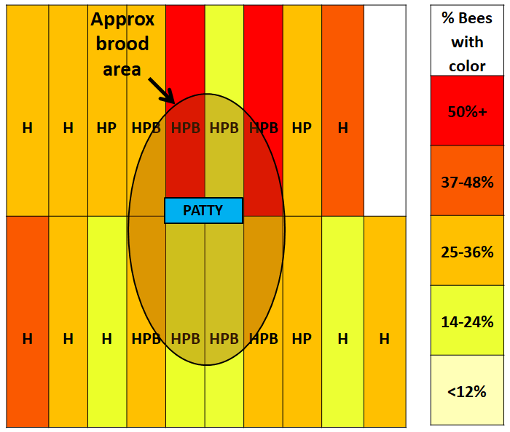
Fig. 7 To my great dismay, a bear ripped the lid off the freezer off before I could process all the samples, but here are two representative results, with the colony fed between the brood chambers to the left, and that fed below the hive cover to the right. H, P, or B indicate honey, pollen, or brood in the comb, respectively. Note that nurse bees that had consumed the labeled pollen sub were present throughout the hive, and that more of them had done so when fed in the middle of the cluster.
Let’s return to my 2020 field trial. It occurred to me that since we had recorded the number of frames of bees (FOB) separately for the lower and upper brood chambers, that I could see whether there was a correlation between the location of the cluster relative to the placement of the pollen sub (since it was always placed on the top bars of the lower brood chamber), and the growth of the colony (indicated by cluster size) (Figure 8).
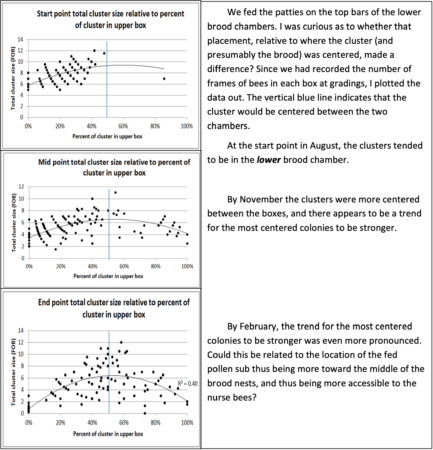
Fig. 8 Let me walk you through this. Colony strength is on the y-axis — the higher the data point, the stronger the colony. Cluster location is on the x-axis — those colonies with the cluster being below the patty being to the left, those with the cluster above the patty to the right, and those with the cluster (and presumably the broodnest) centered on the patty dead center.
Note that over time, the strongest colonies (thus that grew the most) tended to be those in which the cluster was evenly centered above and below the pollen sub patties. This of course is only a correlation, but it sure makes me wonder about the importance of exactly where supplemental protein diet should be offered to the colony. And also whether the reason that soft patty squished between the frames appears to be more stimulatory.
Practical application: Could this be telling us something? In the near-complete absence of a natural pollen flow, perhaps it’s important to place pollen sub closer to the brood. Or maybe provide an additional artificial pollen flow?
BACK TO DRY FEEDING
Perhaps we would have gotten better results if we had concurrently fed a little dry pollen sub for the foragers to place in the brood area. In previous research, I’ve found that bees enthusiastically forage upon offered dry powdered pollen sub offered in the apiary (Figure 9).
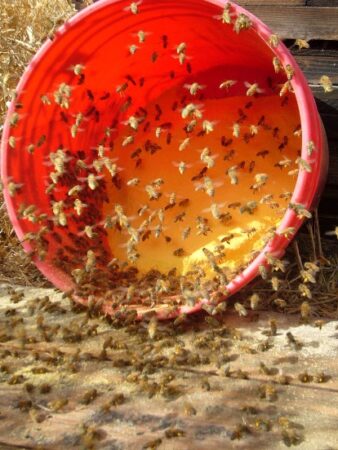
Fig. 9 There are a number of feeders available to keep the powdered sub dry. When I’ve calculated consumption rates, the average per-colony gathering rate of dry sub offered in an apiary feeding station can be equivalent to feeding a 1-lb. patty per week to each hive.
And when I offered foragers fluorescent-labeled dry sub for a single hour, and then inspected combs of brood, it was clear that the returning foragers packed their corbicular loads of dry pollen sub directly adjacent to cells of larvae (Figure 10).

Fig. 10 Under black light, it’s easy to see the bluish-white larvae, and the green fluorescent pollen sub stored after a single hour of offering it in the apiary. This photo confirms Camazine’s observations that pollen foragers randomly place their loads throughout the broodnest.
I hope to experiment further with dry-fed sub concurrent with patty-fed. Dry fed can certainly stimulate jelly production, but I found that it was less consistent colony-to-colony than patty fed. Not only that, but some commercial beekeepers report unfavorable results with dry-fed sub in the fall, supported by an experiment that I ran with some USDA researchers [[12]].
Practical application: I suspect that we still have much to learn about the optimal way to feed artificial diets to colonies. There is of course the tradeoff between practicality and labor costs vs. benefit — it’s difficult to place sub into individual cells in the broodnest in order to stimulate the nurses. Perhaps patties in combination with dry-fed might do the trick. Or some other solution — please let me know if you come up with one!
COMING NEXT
In any case, there is yet one more factor possibly involved in why our colonies grew so poorly during the trial. Next month I’ll look into the importance of nectar, moisture, and humidity as limiting factors for expanding the broodnest.
REFERENCES
[1] https://scientificbeekeeping.com/when-to-feed-pollen-sub/
[2] Lamontagne-Drolet, M, et al. (2019) The impacts of two protein supplements on commercial honey bee (Apis mellifera L.) colonies. Journal of Apicultural Research 58(5): 800-813.
[3] Mattila, H & G Otis (2007) Dwindling pollen resources trigger the transition to broodless populations of long-lived honeybees each autumn. Ecological Entomology 32: 496–505.
[4] Mattila, HR & GW Otis (2006) Influence of pollen diet in spring on development of honey bee (Hymenoptera: apidae) colonies. J. Econ. Entomol. 99: 604-613.
[5] Connor, L (2008) Bee Sex Essentials. Wicwas Press (p. 40).
[6] Keith M. Doull & L. N. Standifer (1969) A technique for measuring feeding responses of honeybees in their hive. Journal of Apicultural Research 8(3): 153-157.
[7] DOULL, K M (1974) Effect of distance on the attraction of pollen to honeybees in the hive. Journal of Apicultural Research 13(1): 27–23.
[8] Taber, S (1973) Influence of pollen location in the hive on its utilization by the honeybee colony. J. Apic. Res. 12(1): 17-20.
[9] J. Woyke (1977) Cannibalism and brood-rearing efficiency in the honeybee. Journal of Apicultural Research 16(2): 84-94.
[10] Camazine, S (1991) Self-organizing pattern formation on the combs of honey bee colonies. Behav Ecol Sociobiol 28:61-76.
[11] https://scientificbeekeeping.com/first-year-care-for-your-nuc/ (search for the word “interface”).
[12] Maes, P, et al. (2016) Diet-related gut bacterial dysbiosis correlates with impaired development, increased mortality and Nosema disease in the honeybee (Apis mellifera). Molecular Ecology 25(21): 5439-5450.
This is a very contentious subject, but how much of the media alarm over glyphosate is based upon actual risk assessment?
Having run my garden and orchard organically for many years, I was faced with invasive Vinca major and Himalaya blackberries that were taking an excessive amount of my time to control. Weed whacking, horticultural vinegar, or ammoniated soaps would kill the aboveground foliage, but the vines would sprout right back up and laugh at me. I’m anything but a corporate shill for spraying unnecessary or dangerous chemicals, so I researched, for my own health concern, about the safety of using a glyphosate herbicide (which also meant that I could no longer consider my property as “organic”).
I found that my own independent review of the literature did not support glyphosate as being of risk to me. Keep in mind that the label instructs the applicator to wear normal protective gear anyway! So I don’t use it in my garden beds, but have now used it in other areas on my property, spot-treating only those two specific invasives (with impressive results). That said, I am not a proponent of widespread use of glyphosate on landscapes, as eliminating all native vegetation and “weeds” eliminates the food plants necessary for pollinators and wildlife, and good soil structure is dependent upon vegetation coverage that provides plenty of plant roots. Any pesticide should be used only sparingly and in a sustainable manner.
I also must point out that we citizens hire the scientists at EPA to perform risk assessments for us. The EPA risk assessors also have families that they wish to protect. I have the honor of knowing the head of risk assessment personally from informal meetings and meals at conferences, as well as many phone and email conversations about protecting bees from pesticides. EPA knows how to do risk assessment, and can better analyze the data from any published or unpublished study better than any can layman or activist group. Bottom line: I have no reason to question EPA’s risk assessments, summarized at https://www.epa.gov/ingredients-used-pesticide-products/glyphosate
For an excellent and objective scientific review, read (of interest, search the word “honey”): Residues of glyphosate in food and dietary exposure https://ift.onlinelibrary.wiley.com/doi/10.1111/1541-4337.12822
For a very good review of glyphosate residues in off-the-shelf foods, the CFIA (Canadian Food Inspection Agency) analyzed 7955 samples of foods to determine the level of compliance of foods in the Canadian marketplace against established MRLs. Read the full report here: https://pubs.acs.org/doi/10.1021/acs.jafc.9b07819
That said, the best layman’s review of glyphosate was recently published at https://geneticliteracyproject.org/gmo-faq/is-glyphosate-roundup-dangerous/?mc_cid=527d29e2df&mc_eid=dc9006049b
I’ve snipped three informative graphics from the above article, since in my own prior research, they were three data sets that I had already graphed out myself:
Money-hungry, fear-provoking “activist groups” such as the Environmental Working Group, hire skilled marketers and lawyers to generate and post scary correlations about glyphosate and cancer. But correlation does not imply causality, as evidenced by the graph below:
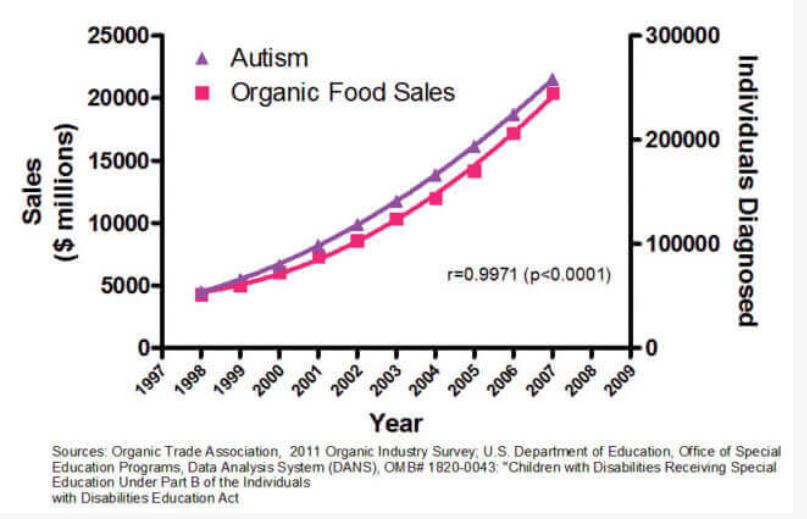
For more humorous spurious correlations, see https://www.tylervigen.com/spurious-correlations
I had previously checked the databases of countries that had kept track of incidence of Non-Hodgkin’s Lymphoma and glyphosate use, and had found that although glyphosate use has skyrocketed over the years, the incidence of NHL has remained flat, which does not support a link between the two. Take a look at the two graphs below (from the GLP article):
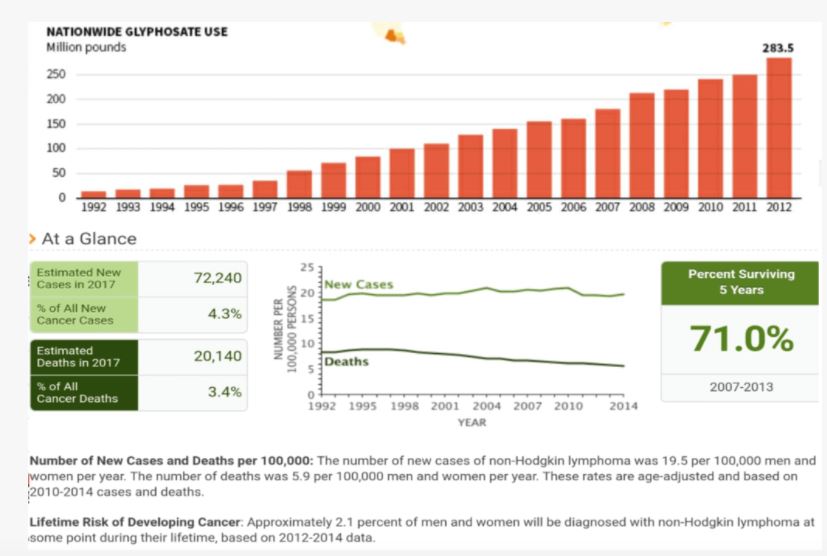
If there was really any evidence that glyphosate caused NHL, we’d see it in the farmers who get it splashed all over their jeans all day long when applying it.
The maps below would clearly indicate if there was any connection between glyphosate application and NHL. There doesn’t appear to be one.
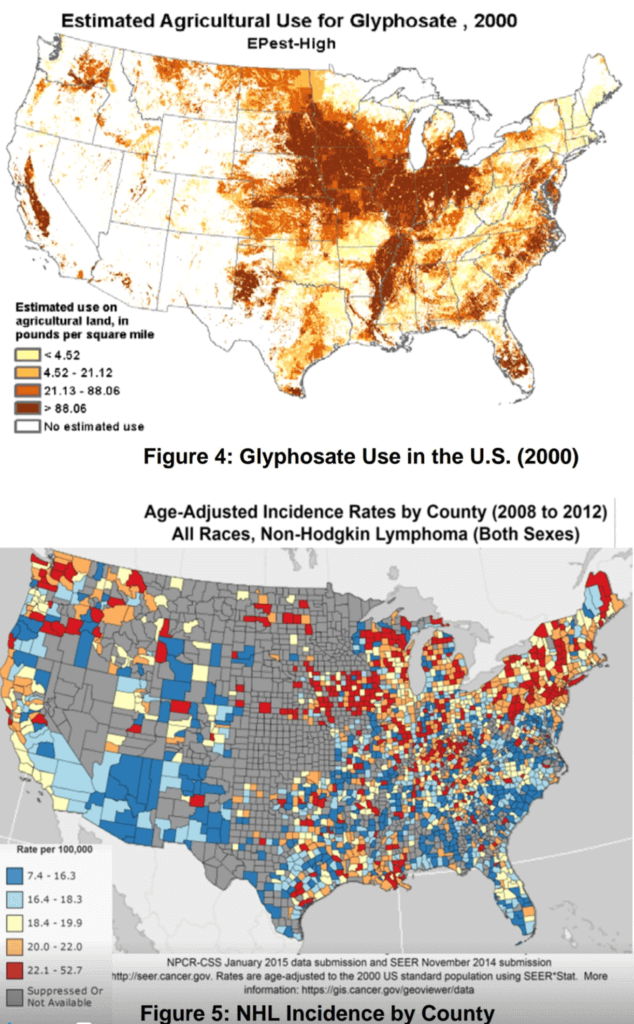
Bottom line: I’m far more likely to harm myself from picking, digging, and pulling out blackberries than I am from spraying them (once is usually enough) with glyphosate. I you have hard data that indicates that I should revisit my current assessment, please forward it to me!
Observations on Pollen Subs
Part 2
Why Didn’t My Test Hives Grow?
First published in ABJ September 2021
Randy Oliver
ScientificBeekeeping.com
After the first of July we find it difficult to get nucs to grow, despite continual feeding. Is the lack of response to feeding due to the heat, the day length, the lack of moisture, or is it something else?
BUILDUP TIME FOR NUCS AND PACKAGES
I hear that beekeepers in the North and East are able to start nucs in July or August and that they’ll grow in strength [[1]]. But it’s a different story in the arid West. I’m hardly the only California beekeeper who complains about it being difficult to get nucs to grow during those months.
In the springtime, we can grow a 5-frame nuc with a laying queen into a full-strength colony in as little as two months. But during our summer dearth, even with continual feeding of patties of natural pollen or high-quality pollen subs, we often struggle to get nucs to build up. Such was the case in my comparative field trials of pollen subs in 2013 [[2]] and 2020. But it’s not always the case — during the field trial that I ran in 2018, August nucs grew from 4.8 FOB (Frames of Bees) to 8.5 FOB by November (Figure 1).
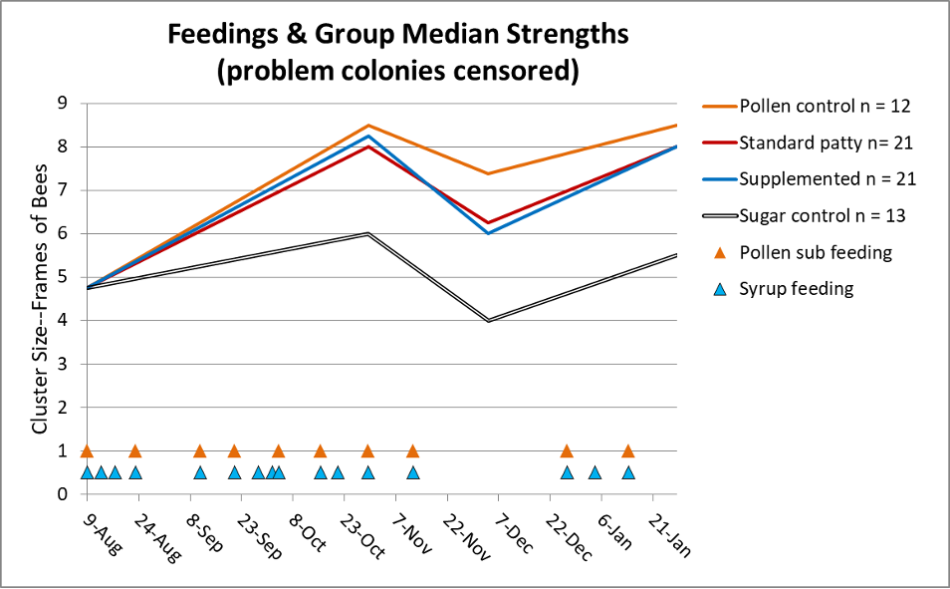
Fig. 1 Results from my 2018-2019 field trial [[3]], in which we were able to nearly double the size of the clusters between August and November. But in my 2020 trial in the same yard (Yard E), with many colonies starting even stronger and fed the best subs, overall they decreased in size over the same time period. I was really curious about why the difference!
So I made a list of every possible stimulatory or inhibitory contributing factor involved in colony buildup that I could think of, and went through them one by one.
THE HIVES
Hive configuration
We’ve tried growing summer nucs in 5-frame boxes, “5 over 5s” (two nuc boxes stacked one above the other), in single deeps and double deeps. In general, it appears that colonies do best in relatively “snug” cavities, without a large amount of extra space around the cluster. The “5 over 5” configuration (thanks to Mike Palmer) appears to help small clusters to expand their broodnests (going upward rather than sideways). In this case, during setup, we started with decent-size clusters in the bottom boxes, and added a box of drawn comb above.
Availability of suitable drawn comb
It’s easier for colonies to expand on drawn comb than on foundation. We had stocked the test hives with 8 frames of good-quality drawn comb in each hive body, flanked by a frame of foundation on each side. So the colonies were not restricted by lack of drawn comb.
THE BEES
Quality of the queens
All the queens were of my own stock, reared that spring, and had been laying since April. All exhibited solid brood patterns at the start of the trial. So the lack of growth was not likely due to the queens.
Colony size
We hadn’t started the trial with nucs — not only did the colonies start with an average of nearly 8 frames covered with bees, but the correlation between starting strength and November strength was actually negative(Figure 2).
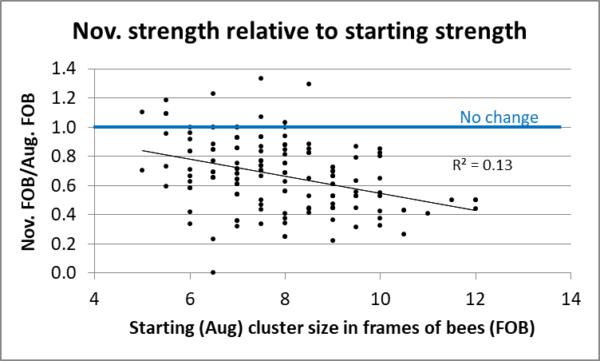
Fig 2 Each data point’s height on the y-axis indicates its cluster size in November (when clusters were tighter due to the cold weather), relative to its starting size. Surprisingly, there was a slight trend for the larger the colony in August, to grade disproportionally smaller in November. Go figure!
Practical application: Well, it doesn’t appear that the problem was due to starting with weak colonies.
NUTRITION
Sugar: nectar, syrup, honey; incoming or stored
As pointed out by Somerville [[4]]:
The loss of the stimulating impact of nectar will also equate to a reduction in the area of brood being cared for by the colony. The provision of nectar continues to keep the brood area “open” and population replacement at a high or expanding level. This stimulus can be artificially created by the provision of sugar syrup.
If there is no fresh nectar available to foraging bees or sugar syrup is not being provided to the colony, then it is a dubious exercise to feed pollen supplements. Otherwise a pollen supplement may be an expensive method of feeding sugar.
An experimental limitation was that I didn’t want to feed these fairly strong double-deep colonies “too much” syrup, since I expected them to grow rapidly, and didn’t want to plug out the broodnests or add additional supers. The intent of this trial was not to fill supers with sugar “honey,” but rather to build up colony strength in double deeps.
So we fed 1:1 sugar syrup along with the pollen sub patties, and I carefully monitored for the presence of open cells of nectar/sugar syrup around the broodnests to make sure that lack of syrup wasn’t a limiting factor. All colonies put on plenty of weight during the trial — to the extent that toward autumn I had to swap frames of honey out of some hives to maintain some open drawn comb above their broodnests for expansion.
Practical application: It’s possible that had we fed sugar syrup daily, that the colonies might have grown more, but since the colonies continuously stored syrup “honey,” I question whether syrup (artificial nectar) was the limiting factor. Plus, our full-sized colonies typically respond to pollen sub alone, even without feeding syrup.
Protein: pollen or substitute, incoming or stored
There was seldom much pollen visible in the combs, but patties of pollen sub were always available, centered over the cluster between the two brood chambers. If the cluster moved to the upper box, we reversed the brood chambers.
Practical application: The colonies did not lack for “available” protein, since they had patties of pollen sub (some containing plenty of natural pollen) in the hive at all times. But I will return to the subject of where it was placed.
THE ENVIRONMENT AND WEATHER
Daylength, time of Season
I’ve not seen evidence that shorter days or time of year prevent colonies from building up. In areas with eucalyptus honey flows, colonies will vigorously brood up and grow in November through the winter solstice. And in my arid climate, in September and October, our full-size colonies respond immediately to the feeding of pollen sub, and expand their broodnests prior to winter. So I have no reason to believe that the day length in August inhibits colony buildup.
Temperature
It was unusually hot and dry during the trial; I’ll go into this further on.
Practical application: We in California are acutely aware of climate change (Figure 3).
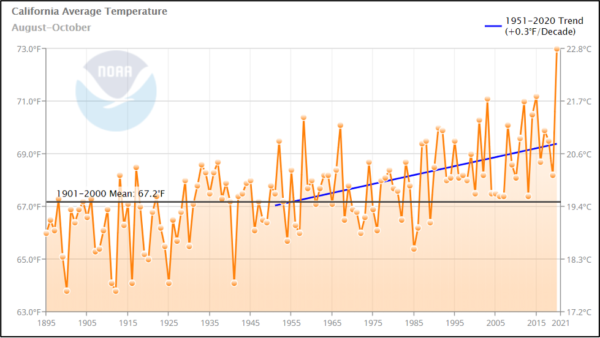
Fig. 3 I keep asking, is it just me growing old, or are our summer temperatures indeed getting hotter? The blue line indicates the trend over my lifetime. My sons are too young to remember “how it used to be.” Our warming climate is not only causing extreme weather and worse fires, but also affecting agriculture, the local flora, and beekeeping. Chart from NOAA [[5]].
Practical application: Beekeepers need to prepare for “the new normal” as far as temperature change and weather extremes.
BEES, MONARCHS, AND OTHER INSECTS
Honey bees maintain a broodnest temperature of around 94-95°F, and optimal flight temperature for foragers is around 72-77°F, although foraging activity will continue at temperatures up to about 100°F before declining [[6]]. Temperatures above that start to approach the thermal limit of honey bees. Dalmon [[7]] found that the survivability of European honey bees starts to drop off rapidly at temperatures above 104°F. What happens at higher temperatures is that the enzymes that drive metabolic processes in the bees cease functioning. And this brings us to a very important concern as our climate warms.
Dr. Orley (Chip) Taylor recently published three excellent articles on the effect of higher temperatures on Monarch butterflies [[8]], and makes the point that:
It should be clear that everything I’ve just described for monarchs applies to honey bees, bumble bees, solitary bees, other pollinators and most other insects. I can envision scenarios based on the above that account for population declines of all of these organisms.
Practical application: As our climate warms and we continue to set new high temperature records (116°F in Portland, for cryin’ out loud), honey bees (as well as beekeepers) will need to adapt. Some of our commercial stocks may not be able to handle hotter weather, so we may be forced to explore bee bloodlines that are better adapted to higher temperatures.
I found an interesting study from the Tucson Lab, in which they compared the temperature tolerance of “domestic” stock to that of a locally-adapted feral colony (Figure 4).
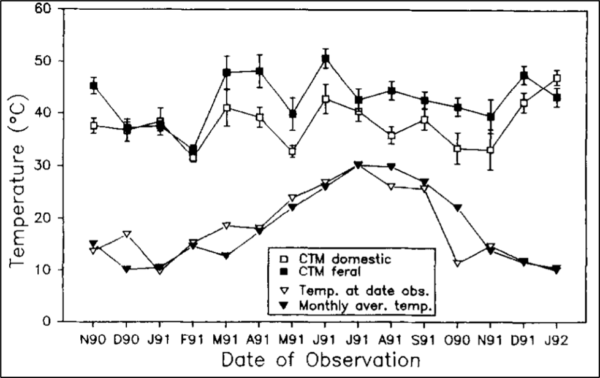
Fig 4 Atmowidjojo [[9]] compared the critical thermal maxima (CMT) for bees collected from the entrance of a single locally-adapted feral colony in Arizona to those from a USDA colony of “domestic” bees, over the course of 14 months. Surprisingly, there wasn’t a clear correlation between monthly ambient temperature and the thermal tolerance of the bees. But the feral bees clearly were more tolerant of high temperatures.
Practical application: Although the above study involved bees from only two colonies, it’s clear that the “domestic” stock would have trouble at temperatures above 104°F (40°C = 104°F; 50°C = 122°F)..
Temperature tolerance of races of bees
So how about the various races of Apis mellifera? Kovak [[10]] determined the thermal limits of Carniolans (carnica) vs. Italians (ligustica):
We found differences in several traits, suggesting that A. m. ligustica populations can tolerate a high temperature exposure better than A. m. carnica populations. This surely represents a feature of adaptation of A. m. ligusticapopulations to the warmer environment of the South European climate.
Curious, I checked to see what sort of high temperatures that Italian bees evolved in. Historical average August high temperatures for most cities in Italy seldom exceeded 85°F [[11]], suggesting that they may not be adapted for higher temperatures.
So how about races of bees from hotter areas, such as the Arabian honey bee, Apis mellifera jemenitica? I was able to find some informative studies from Saudi Arabia.
Alqarni [[12]] notes that:
Central Saudi Arabia has the highest summer temperatures for the Arabian Peninsula, and it is in this region where only A. m. jemenitica survives, while other subspecies fail to persist.
He found that jemenitica forages earlier and to a greater extent at high temps than does A. m. carnica.
The optimum humidity for the survival of eggs and successful larval emergence for our “domestic” bees is 90-95% RH [[13]], with the rate of emergence dropping to as low as zero at 50% RH. Of interest, Al-Ghamdi [[14]] found that greater tolerance of lower humidity by the eggs of A. m. jemenitica allows for more successful brood rearing in the desert than by European bee races.
As far as adult bees, Alqarni [[15]] compared the performance of jemenitica to that of mellifera and carnica, and found that jemenitica loses less body water and forages more extensively at high temperatures than either European race.
Practical application: In correspondence, Dr. Alqarni suggested that “As conditions continue getting hotter and drier in your area, you might consider testing different bee lines.” That’s a sobering thought — similar to how the rest of the ag industry is being forced to adapt to a warming planet, we beekeepers may have to start selecting for more heat-tolerant bees. So could my Italian mongrels simply have hit their thermal limit for buildup during a hot summer?
CAN WE BLAME HIGH TEMPERATURE ALONE?
The colonies in my trial never shut down broodrearing until November, but they maintained only about a single comb’s worth of brood, despite being continually supplied with nutritious pollen subs. So could their lack of expansion have been due to the high temperatures?
The Sierra Foothills are typically warm and dry during summer, but a recent NOAA report [[16]] confirmed that the September – November period in 2020 was one of the hottest on record. And it wasn’t just the heat — over the course of the August-October period we received only 0.05 inch of total rainfall.
The colonies in Yard E gave me a chance to compare performance between the trial in 2018, in which the colonies grew, to that in 2020, when they tended to shrink. In order to see just how different the weather was in 2020 compared to 2018, I searched for data records for personal weather stations in the area. Unfortunately, I could only find one with data for both years at about 400 ft higher elevation, where it is slightly cooler. That said, I downloaded and graphed out the weather data for the two years for comparison (Figure 5).
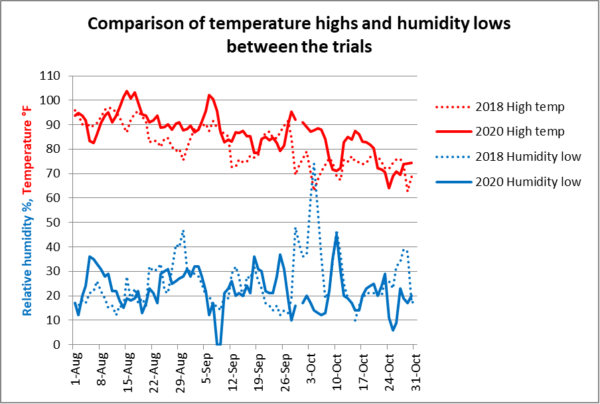
Fig. 5 Compare the daily temperature highs and humidity lows over the course of the 2020 trial (solid lines), compared to that of 2018, when colonies grew well in response to feeding (dotted lines). Not only were the temperatures often higher in 2020, but the humidities were often lower. Our “normal” average September high is 81°F, and for October only 71°F, so 2020 was indeed hotter than “normal.” Data from a local personal weather station [[17]].
Oh boy, I’d surely nailed it! It was obvious that in 2020 we simply reached the thermal tolerance limit for small colonies of my Italian mongrels — it was just too danged hot for them to grow!
Practical advice: Any time you feel cocksure about something, remember that the easiest person to fool is always yourself. And that’s exactly what I’d done. In the words of Thomas Huxley: “The great tragedy of science [is] — the slaying of a beautiful hypothesis by an ugly fact.”
Indeed, when later carefully reviewing my data, I noticed a couple of “ugly facts” which indeed slayed my beautiful explanatory hypothesis. The ugliest fact had to do with the surprise nectar/pollen flow that occurred in mid-August.
A BEAUTIFUL EXPLANATORY HYPOTHESIS SLAIN
We have an invasive weed in Northern California called yellow star thistle. Star thistle produces a very tasty honey, but in my experience, the plant doesn’t produce much nectar and pollen unless daytime highs exceed 95°F. Due to drought, we’d written off the possibility of a star thistle flow when we started feeding pollen sub on 13 August, so were completely surprised when the bees in the two lower-elevation test yards started bringing in loads of nectar and pollen only a few days later (Figure 6).
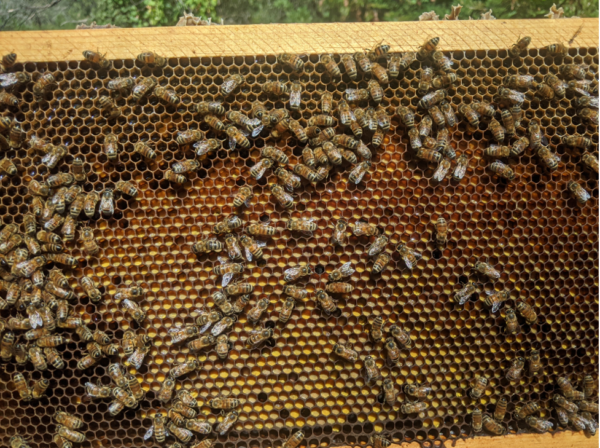
Fig. 6 The bees briefly filled the combs with fresh yellow star thistle nectar and pollen. This photo of freshly-stored pollen was taken on 16 August, on which date the temperature reached 105 F (the daily high for the preceding week had only once fallen below 95 F). Not shown is that in response, the colonies temporarily ramped up brood rearing to the max.
After taking the above photo, the temperature dropped, and so did the nectar/pollen flow. The bees shortly thereafter started to shrink their broodnests. So let’s compare that burst of broodrearing to daytime temperatures and humidities (Figure 7).
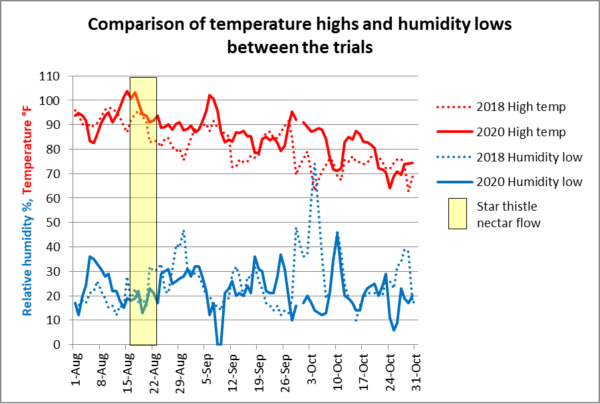
Fig. 7 I overlaid when the thistle flow occurred (from 16-24 August). Note that it occurred during some of the highest temperatures and lowest humidities during the course of the trial. By 4 September, despite cooler temperatures and having some thistle beebread remaining in the side combs of the broodnest, the nurse bees had already begun cutting back on the amount of jelly being fed to larvae, and the broodnests were shrinking. We resumed feeding pollen sub on 10 September.
A beautiful explanatory hypothesis slain: The colonies brooded up big time during the hottest temperatures of the entire trial. So the overall lack of colony growth can’t be blamed on temperature alone.
BACK TO THE DRAWING BOARD
So let’s review what I observed:
- Continual feeding of pollen sub patties along with ½ gallon of 1:1 sugar syrup was not enough “stimulation” to get the bees to expand their broodnests during the hot summer of 2020 (in Yard H there was no thistle flow, and no broodnest expansion).
- On the other hand, despite daily high temps well over 100°F, weak colonies were able to rapidly expand their broodnests when a nectar and pollen flow occurred.
- Once the nectar and pollen flow stopped, the colonies rapidly decreased brood rearing, despite there being plenty of recently-stored beebread, and combs full of ripening nectar.
So how can we explain why I couldn’t get the colonies to grow well during the rest of the trial, despite providing them continuously with patties of pollen sub along with ½ gallon feedings of 1:1 sugar syrup? Next month I’ll explore whether it had to do with water, humidity, or perhaps where we placed the pollen sub patties.
REFERENCES
[1] Connor, L (2006) Making & Wintering Summer Increase. http://www.wicwas.com/sites/default/files/articles/Bee_Culture/BC2006-07.pdf
[2] http://scientificbeekeeping.com/a-comparative-test-of-the-pollen-sub/
[3] http://scientificbeekeeping.com/an-experiment-to-improve-pollen-sub-part-2/
[4] Somerville, Doug (2005) Fat Bees Skinny Bees, A manual on honey bee nutrition for beekeepers. https://rirdc.infoservices.com.au/items/05-054
[5] https://www.ncdc.noaa.gov/cag/statewide/time-series
[6] https://extension.umaine.edu/ipm/background-honeybee-flight-activity-index/
Caron and Connor give a wider range: Caron, D & L Connor (2013) Honey Bee Biology and Beekeeping. Wicwas Press.
[7] Dalmon, A, et al (2019) Temperature-driven changes in viral loads in the honey bee Apis mellifera. Journal of Invertebrate Pathology Volume 160: 87-94.
[8] https://monarchwatch.org/blog/2021/01/19/insect-population-dynamics/
https://monarchwatch.org/blog/2020/02/10/why-monarchs-are-an-enzyme-part-1/
https://monarchwatch.org/blog/2020/02/25/why-monarchs-are-an-enzyme-part-2/
[9] Atmowidjojo, A, et al (1997) Temperature tolerance and water balance in feral and domestic honey bees, Apis mellifera L. Camp. Biochem. Physiol. Vol. 118A(4): 1399-1403.
[10] Kovak, H, et al (2014) Metabolism and upper thermal limits of Apis mellifera carnica and A. m. ligustica.Apidologie 45:664–677.
[11] https://www.currentresults.com/Weather/Italy/temperature-august.php
[12] Alqarni, A, et al (2011) The indigenous honey bees of Saudi Arabia (Hymenoptera, Apidae, Apis mellifera jemenitica Ruttner): Their natural history and role in beekeeping. ZooKeys 134: 83–98.
[13] Doull K.M. 1976. The effects of different humidities on the hatching of the eggs of honeybees. Apidologie 7: 61–66.
[14] Al-Ghamdi A, et al (2014) Hatching rates and some characteristics of Yemeni and Carniolan honey bee eggs. J Entomol Zool Stud 2:06–10.
[15] Alqarni, A (2006) Tolerance of summer temperature in imported and indigenous honeybee Apis mellifera L. races in central Saudi Arabia. Saudi Journal of Biological Sciences 13(2) 123-127.
[16] Shoemaker, C (2021) NWS Sacramento Fall 2020 Climate Summary.
[17] Thanks to KCAGRASS28.
A COMPARATIVE TRIAL OF THE POLLEN SUBS 2020
Part 3
Beekeeper-Funded Research
First published in ABJ September 2021
Randy Oliver
ScientificBeekeeping.com
Some research institutions avoid the testing of name-brand products for obvious reasons, and some trade magazines won’t publish articles that might offend their advertisers. We beekeepers are fortunate that Dadant & Sons and the American Bee Journal allow me to objectively write about products that they may produce or advertise. I maintain complete impartiality in my trials, and let the data speak for itself. My sons and I, who depend upon beekeeping for our livelihood, are just as interested in the results as are you my readers.
MOVING ON FROM THE MIDPOINT ASSESSMENT
Pretty much any artificial diet can be of benefit to the bees in the short term, but the real test is how it performs over the long term. I happen to live in a landscape that provides an extended dearth period (August through mid-January), thus allowing me to really put diets to the test in free-flying colonies.
Unlike in areas that provide an autumn pollen flow — which allow colonies to store pollen as beebread to provide for winter maintenance or late-winter broodrearing — there was virtually no fall pollen flow in my test yards, so there was an absence of stored beebread going into the winter.
Practical application: My previous article left off at the midpoint assessment, which served as a status report as to how the artificial diets had prepared the colonies for winter. Since bees don’t store patty-fed pollen sub in the combs, that means that the test colonies were nearly totally dependent on the tested diets for the development of the all-important fat bodies of the “winter bees.” And then the late-winter resumption of brood rearing would also be dependent upon the fed diets until the first tree pollens became available.
REINITIATION OF FEEDING AFTER THE WINTER BREAK
Let’s review the timeline of the trial (Figure 1):
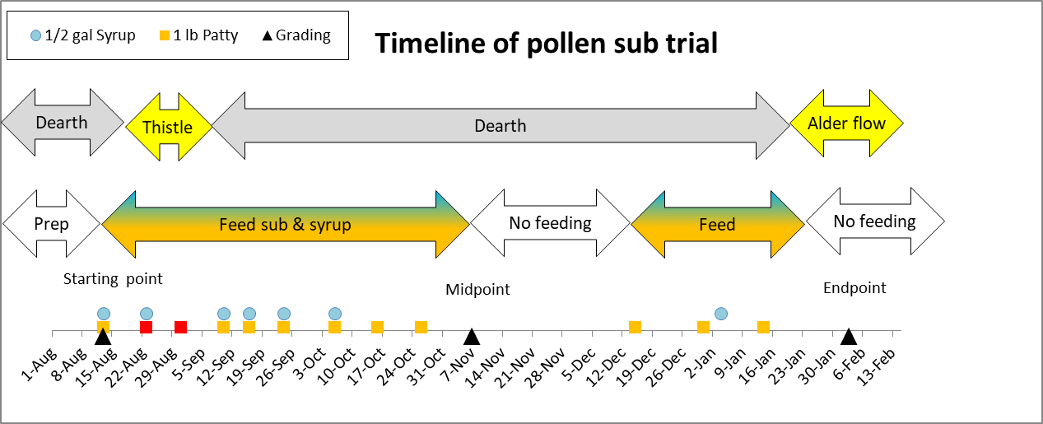
Fig. 1 The above chart shows the timings of feedings and gradings, as well as the occurrence of two natural pollen flows (the thistle flow occurred in only two of the yards; yard H received 2 feedings [red] during that time). We performed final grading prior to the emergence of any bees that could have developed during the alder flow.
Experimental design: This trial ran for 175 days (8 potential brood cycles), during which the predominant sources of food for each of the 144 colonies were the artificial diets (other than the surprise 10-day pollen flow from thistle in two of the three test yards).
RESUMPTION OF FEEDING
As the weather cooled in early November, the test colonies went into winter cluster and ceased rearing brood. They consumed the last of their fed sub the first week of November. After a month in winter cluster, temperatures warmed enough for the bees to start flying again, so we resumed feeding on December 15.
At that time there was considerable disparity in colony strength (largely correlated with diet type), with the stronger colonies (not unexpectedly) consuming their fed patties more rapidly.
Experimental decision: Since the colonies in some treatment groups were stronger in December, these larger colonies, not unexpectedly, consumed more food. So rather than feeding all hives equally — which would have limited the expansion of the stronger colonies — we checked weekly, and gave each colony as much patty as they could consume. Instead of removing and weighing any as-yet-unconsumed patty, we simply recorded how much they ate until final grading (Figure 2).
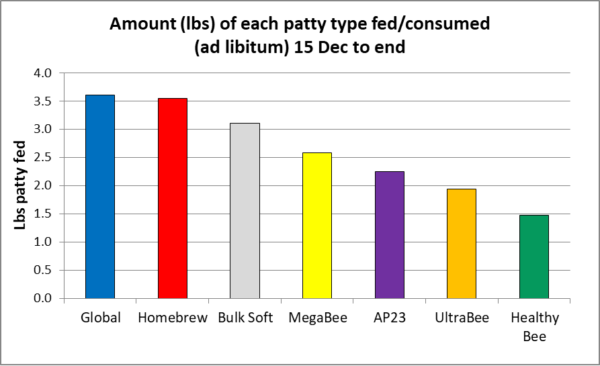
Fig. 2 The reason that I run feeding trials over the winter, is that you really see the results when the colonies start to grow again as the weather warms (in this case, starting in mid-December). Unlike patty consumption during summer, the amounts consumed during late-winter buildup appeared to be mostly a function of colony strength, with the larger, faster-growing colonies consuming greater amounts of the fed diets.
Practical application: Unlike the general lack of relationship between August colony strength and November strength (see Figure 2 in the accompanying article), there was a clear correlation (R2 = 0.38, not shown) between November cluster size and the February grading for colony strength.
RESULTS: LATE-WINTER BUILDUP PRIOR TO ALMOND POLLINATION
The interval between our reinitiation of feeding and the start of the alder bloom gave the diets three weeks to influence colony buildup before the first natural pollen became available. This is an important consideration with regard to field trials of pollen subs, as pointed out by Stanger and Laidlaw [[1]] back in 1974:
Therefore, this work indicated that there is value in feeding during October through January preceding the almond bloom in California to provide colonies with greater populations for more effective almond pollination, but that feeding of pollen, pollen supplements, or pollen substitute is not beneficial after the spring pollen flow begins.
Practical application: I found the same in my field trial of pollen subs in 2013 [[2]]. So by performing final grading at 20 days after the commencement of the alder pollen flow, we’re able to tease out the benefit of artificial feeding before it was affected by the occurrence of the pollen flow (since no workers that might have benefitted from the alder flow would have had time to emerge and affect the cluster size).
Comparison between November and February cluster sizes, by diet type
Every beekeeper notices that there is generally a large colony-to-colony variation in performance in any group of hives, and this field trial was no exception. But looking at average values for each test group does not tell the whole story. So rather than giving you a bunch of means and standard errors, allow me to present the raw data for all 133 hives still alive at the end of the trial, color-coded by diet type, comparing each colony’s February strength to that at the November grading. Take some time to look at the distribution of the colored data points for each diet type (Figure 3).
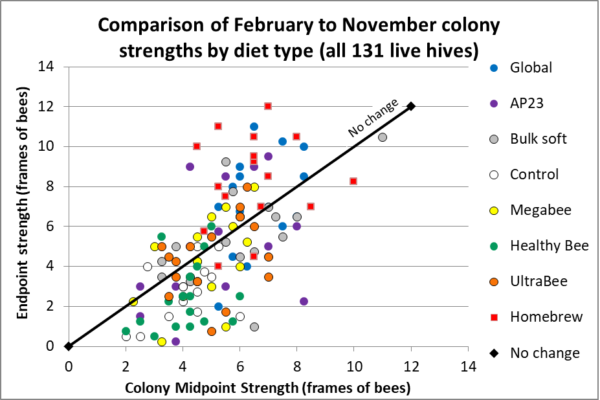
Fig. 3 Cluster size in February relative to that in November (many data points overlap); the trendline indicates no change in strength: colonies that grew are above the black trendline, those that shrunk lie below. In every diet group there were good and poor performers. Focus upon the vertical distances of the data points above or below the “No change” indicator line. On average, the Homebrew and Global colonies grew in strength — the rest of the diet groups had colonies scattered above and below the line during this expected buildup period.
Practical application: Colony growth prior to almonds had a lot to do with overwintering cluster size. Colonies to the left (indicating a smaller winter cluster size) were in general unable to increase in strength to any extent during the buildup period (as indicated by their data points being below the line). On the other hand, those that went into winter with slightly larger clusters (to the right) were often able to grow rapidly (their data points being well above the line), notably some individual hives from the Homebrew, Global, AP23, and Bulk Soft diet groups. I suspect that such vigorous growth also indicated a greater nutritional value of those diets.
Note that the above results may sound contrary to those of the widely-cited study of late-season pollen supplementation by Mattila and Otis [[3]]. That study was performed in an area in which there was a strong autumn pollen flow — a completely different situation than that in many areas of California. In this field trial, the colonies benefitted both from autumn feeding (which allowed them to go into winter with a larger cluster size), as well as from late-winter feeding (similar to the findings of Mattila and Otis in another study [[4]]).
Colony survival
No colonies suffered “Colony Collapse” due to inadequate varroa management. Fewer than 3% of these often-stressed hives exhibited “queen failure” over the course of a nearly 6-month trial. The total colony loss rate was 9% (Figure 4).
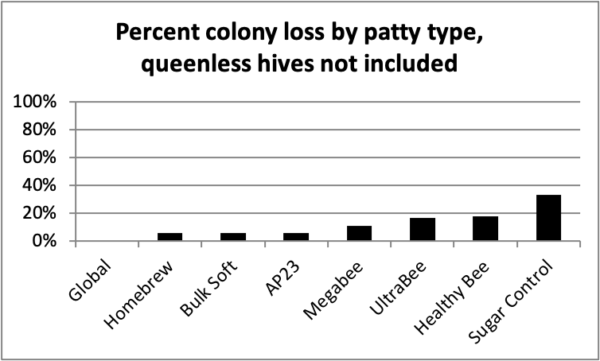
Fig. 4 Only one colony had perished by the midpoint. At the final February grading, I defined a “colony loss” asthose either having died other than due to going queenless, or still queenright but with less than one frame interspace filled with bees (3 colonies).
Practical application: Not surprisingly, colony loss correlated closely with overall colony performance by diet type.
RESULTS OF 1 FEBRUARY GRADING
Changes in colony strength over the long term
From our standpoint, what makes us money are the number of frames covered with bees (cluster size) when we rent the hives for almond pollination. So let’s see how the colony cluster sizes tracked for each diet type, in each of the three test yards, over the entire six-month course of the trial.
Practical application: This will allow us to see whether the results were consistent from yard to yard.
In order to avoid any bias in censoring colonies that went queenless or had other health issues, for each yard I simply censored out an identical number of the poorest-performing hives from each treatment group.
Yard E
This is the same yard in which we ran last year’s pollen sub trial, so we didn’t expect the brief nectar and pollen flow from star thistle in early August (Figure 5). In any case, we stocked this yard the most heavily (72 hives), so that the colonies would be strongly competing for the scant amount of natural pollen coming in from the landscape in late summer and fall.
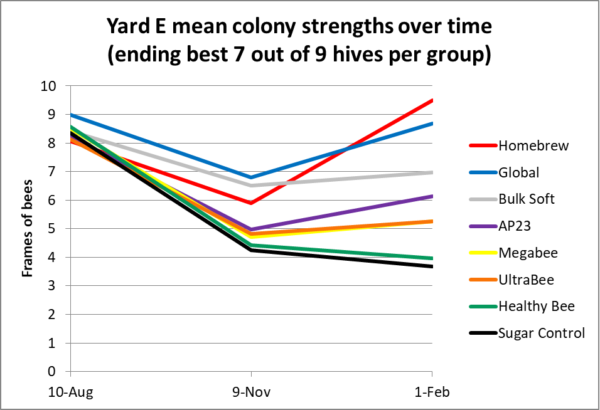
Fig. 5 As expected, the sugar-fed Control colonies went downhill, thus confirming the benefit of feeding pollen sub under these conditions. The benefit of November cluster size is apparent, allowing the larger clusters to grow more rapidly during late-winter buildup (compare the pitches of the upward slopes). Only the Healthy Bee and Sugar controls were unable to grow.
Yard T
The second replicate, Yard T, was a similar-elevation yard in which colonies had performed poorly the last two years. We placed 40 hives there (Figure 6). This yard also enjoyed the brief star thistle pollen flow.
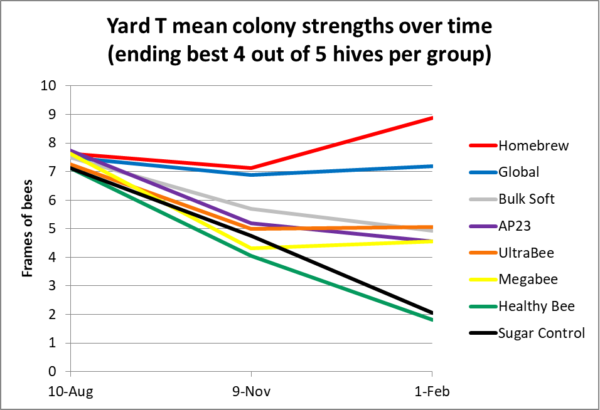
Fig. 6 Similar to Yard E, the importance of winter cluster size was apparent. Homebrew hives took off, with Global lagging a bit in this yard. Note how badly the Healthy Bee and Sugar Controls plummeted in strength.
Yard H
For the third replicate, I placed 32 hives in my higher-elevation home yard (Figure 7), competing with a bunch of other experimental colonies. Our home yard hives really benefit from the feeding of pollen sub, and did not have the benefit of an August pollen flow. This yard got fed when the other yards still had unconsumed sub on them.
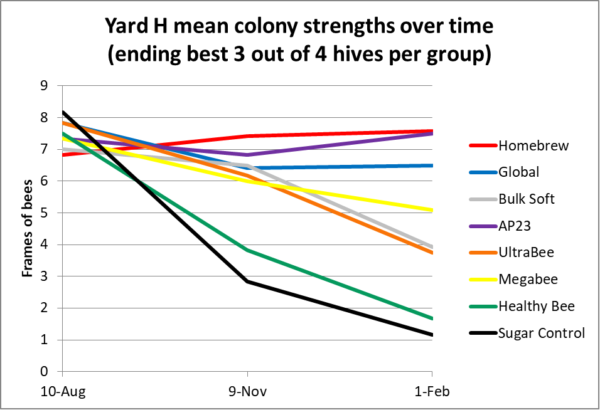
Fig. 7 Yard H was the most nutritionally stressed — the Sugar Controls and Healthy Bee colonies nosedived, with half of the Control colonies dwindling to death. The yard did not benefit from the August star thistle pollen flow, but was fed an additional 2 lbs. of pollen sub instead. Overall, there was less August-November loss of strength compared to the other yards, but conversely, less gain during late-winter buildup (Homebrew, AP23, and Global at least held their own). Despite the overall lack of colony growth, compare the striking difference in performance between the best diets and the poorest.
Practical application: The relative performances of the diets were remarkably consistent from yard to yard, indicating that we can draw conclusions from the data. The take home message appears to be that some diets consistently outperformed others. The better diets allowed some groups to go into winter with heavier bodies and larger winter clusters, thus setting them up with the ability to build up more rapidly upon recommencement of late-winter feeding, dependent again upon the nutritional value of the diet fed.
Additional graphs
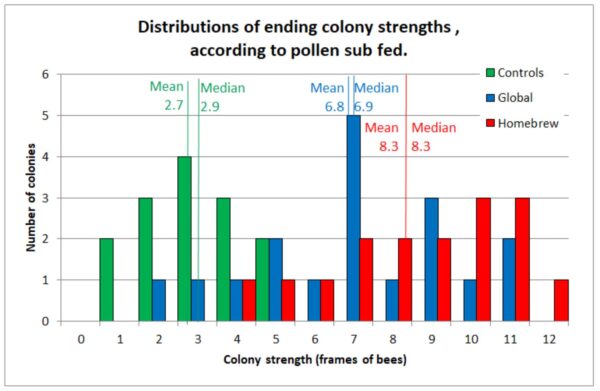
Histograms of ending colony strength distributions for Controls vs Global and Homebrew.
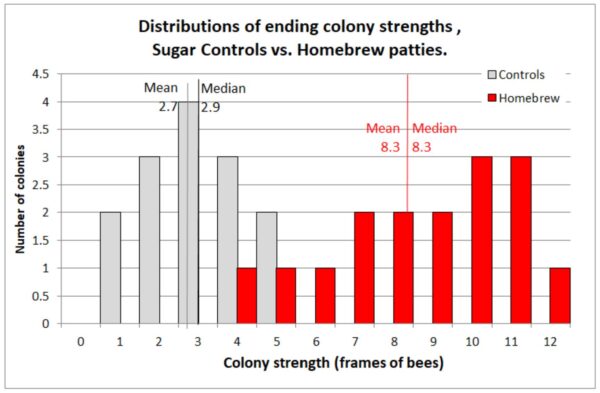
Histograms of ending colony strength distributions for Control vs Homebrew alone.
COLONIES MAKING GRADE FOR ALMONDS
I broke down the colony strength assessments to see how many hives in each test group of 18 made at least 4.5-frame strength on 1 February — assuming that since they had plenty of sealed brood after the alder bloom, that they’d grow to at least 6 frames by grading date in the orchards (Figure 8).
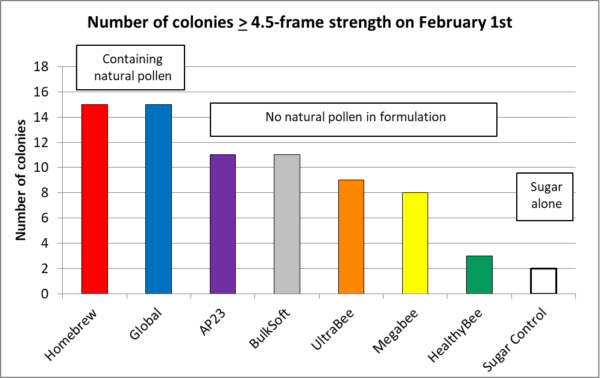
Fig. 8 This year our colonies across the board were weaker than normal; those in the pollen sub trial were no exception. From the above data, one might conclude that pollen sub performance is all about whether they contain natural pollen, but in my next installment I’ll show that that may be mere coincidence.
Practical application: After nearly six months on artificial diets, only 2 out of 18 colonies in the Control group made 5-frame strength come February, compared to 15 out of 18 in the best-performing diets. Although this trial was run in an environment having a short and relatively warm winter, it clearly shows the benefit of nutritional supplementation.
In a number of our almond pollination contracts, we get paid by colony strength, based upon the grading of 10% of the hives. Our minimum required cluster strength for any hive is 5 frames of bees. If the graders hit a hive weaker than that, we don’t get paid for 10 hives, so we generally don’t bother to take any weak hives down to the orchards. But, as with many Western beekeepers, we were tight on strong colonies this year, and hauled down anything that in early February looked as though it would grow to at least 6 frames by grading time. Prior to grading, we popped open all of our hives, and boosted any weak ones (Figure 9).
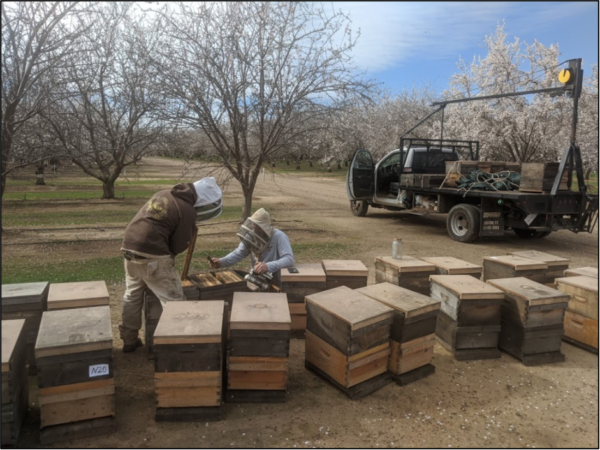
Fig. 9 Eric and Ian, in advance of grading, are boosting weak colonies with frames of bees from the strongest hives (which keeps them from swarming). When we’re getting over $200 per hive, we figure that it’s worth the labor.
OVERALL PERFORMANCE
In light of the above, perhaps the most straightforward way to evaluate the performance of the artificial diets would be to simply add up how many rentable frames of bees in total we got from the 18 hives in each test group (Figure 10).
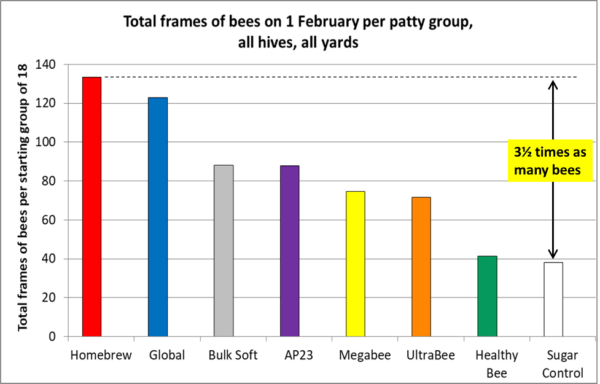
Fig. 10 Our income is based upon how many frames of bees (FOB) we can rent in almonds and then later sell as nucs. There were 133 rentable FOB in the 18 hives in Homebrew group, compared to only 38 frames in the Controls.
Practical application: The 133 FOB in the Homebrew group earned us $3,242 in almonds, whereas the 38 FOB in the Control group returned only $804. I did the math for a cost-benefit analysis; the better subs returned around $5 (above the Control group) in almonds for every dollar spent on the patties. But that was not counting labor, which in this case was excessive, due to the twelve feedings. In practice, we typically feed 2½-lb. patties two to three times.
THE TAKE-HOME
Many Western almond pollinators move their colonies to better pasture during summer (as did I for 20 years). But such pasture is getting harder to find (especially during our prolonged drought). So in order to build our colonies up for almond pollination, some of us depend upon feeding pollen subs (artificial diets). But I realize that not every beekeeper pollinates almonds, or experiences pollen dearths. It’s up to the beekeeper to decide whether it is cost-effective to feed pollen sub in their operation.
Anyway, this trial was not about trying to convince anyone to feed pollen sub, but rather to compare the nutritional values of the artificial diets on the market.
It’s not about “winners” vs. “losers”
I have trepidation about running this sort of “Consumer Report” trial of the products of different manufacturers, with whom I like to maintain friendly relationships (and who I respect for cooperating with me on this trial). During the course of the trial I lamented to my helpers that if it looked as though there was only one “winner,” then that might imply that the other seven products were “losers.”
Practical consideration: This trial was about the long-term feeding of artificial diets. For those who wish to feed only a round or two of pollen sub, any nutritional deficiencies may not be apparent in the short term.
I certainly wasn’t aiming to embarrass any manufacturer, and was surprised by the comparatively poor performances of two of the subs. In my previous testing (controlled and informal), Ultra Bee ranked very high (although in our own operation we prefer its sister product, Bulk Soft). One possibility for the change is that the manufacturer recently switched one of the ingredients (I asked, since we noticed the difference in appearance). As far as Healthy Bee, I strongly suspect that the high level of thyme oil in the formulation that I tested was a problem. Both manufacturers are addressing the issues.
As I’ve said, my sons and I spend a lot of money on pollen sub, and we just wanted to see whether there were appreciable differences in performance between the products on the market. To do so, we fed the test hives for nearly six months on the artificial diets, in order to see whether any nutrient deficiencies might become apparent. We weren’t rooting for any particular products, and our findings are hardly the last word. But what we did find is that the performances of the subs, relative to each other, were fairly consistent from yard to yard, and that some diets outperformed the others. So the Big Question is, why?
COMING NEXT
Next month I will delve into the nutritional analysis of the subs. The two top performers had something in common other than having natural pollen in their formulations. I’ll show how we perhaps might have predicted their performance from their analyses. But most importantly, for the benefit of manufacturers and beekeepers anywhere, I’ll provide a handy calculator in the hope that everyone can improve their pollen sub formulations.
ACKNOWLEDGEMENTS
This research was funded by donations by beekeepers, which allow me to perform these expensive field trials. And we should all thank the manufacturers for donating the patties for the trial. I thank all for their support! I also wish to thank beekeeper Peter Borst, who assisted me greatly in library research.
REFERENCES
[1] Stanger,W & H Laidlaw (1974) Supplemental feeding of honeybees (Apis mellifera Linnaeus). Am. Bee J. 114: 138 -141.
[2] http://scientificbeekeeping.com/a-comparative-test-of-the-pollen-sub/
[3] Mattila, HR & GW Otis (2007) Dwindling pollen resources trigger the transition to broodless populations of long-lived honeybees each autumn. Ecological Entomology 32: 496–505.
[4] Mattila, HR & GW Otis (2006) Influence of pollen diet in spring on development of honey bee (Hymenoptera: Apidae) colonies. J. Econ. Entomol. 99(3): 604-613.
A COMPARATIVE TRIAL OF THE POLLEN SUBS 2020
Part 2
First published in ABJ August 2021
Vincent Riciglianoa and Randy Oliverb
aUSDA-ARS, bScientificBeekeeping.com
Last month I described how we set up our comparative trial of several pollen subs. Now it’s time to bring in my collaborator, Dr. Vincent Ricigliano, to show the results of some of his laboratory analyses of the bee samples taken at the midpoint of the trial, as the colonies went into winter cluster.
A note from the authors: Since Randy started writing this series in the first person, we’re going to continue along that vein, although much of this article will be about Vince’s findings. Since beekeepers are becoming more and more dependent upon supplemental feeding of their colonies, for the benefit of the beekeeping industry we’re doing a deep dive into extracting as much usable information as we can from the data gathered during this field trial of artificial diets.
That said, this article presents a lot of information from the midpoint of the trial — both field measurements and molecular analyses. The midpoint findings presented in this article help us to understand artificial diets in general, and will likely be of special interest to those interested in developing better diets for honey bees. Next month we’ll present the endpoint results, which will really get down to the nitty-gritty of dollars and cents, practical application to beekeepers curious about the pollen subs on the market.
EFFECT OF DIET TYPE UPON COLONY STRENGTH AT THE MIDPOINT ASSESSMENT
After a feeding period of 84 days — during which the colonies depended upon the tested pollen subs and sugar syrup as their main sources of nutrition — the hives went broodless in November as the weather cooled. We graded them for strength on a cold morning, when the clusters were very tight (but which allowed for accurate and consistent grading).
The first question to answer was whether midpoint colony strengths reflected their starting strengths, since I’d intentionally begun the trial with an equal range of starting cluster sizes for each diet type. A scattergram (Figure 1, in which many of the 144 data points overlap) indicates that there was no benefit from starting with a larger cluster size.
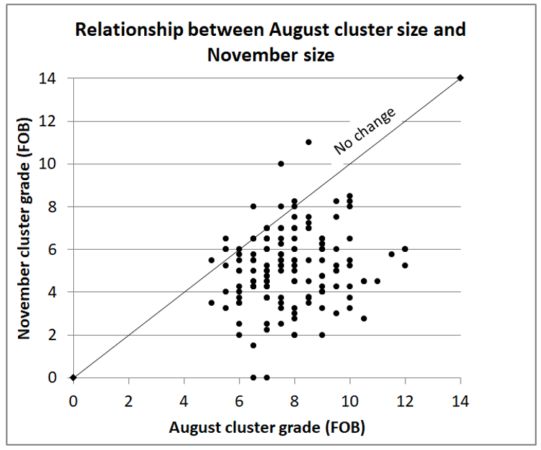
Fig. 1 Change in cluster size from August to November; colonies below the No Change line shrunk in size. The median starting cluster size (in hot-weather grading) was 7.5 frames of bees (FOB), by November (with cold-weather grading); most colonies had shrunk in size (to a median 5.3 FOB). The data above indicate that there was no benefit to starting with a larger cluster size in August, since the larger colonies tended to lose more strength than the smaller ones (as evidenced by the greater vertical drop of the data points from the No Change line from left to right).
Practical application: Being stronger in August did not mean that a colony would be stronger in November. This may have been an artifact of the clusters of the strong colonies being more expanded during hot-weather grading, more than actual bee count.
Since starting cluster size was not that predictive of midpoint size, and since all diet groups started with an equal range of cluster sizes, this means that we can compare the average colony strengths in November by diet type without taking into account starting colony strengths (Figure 2).
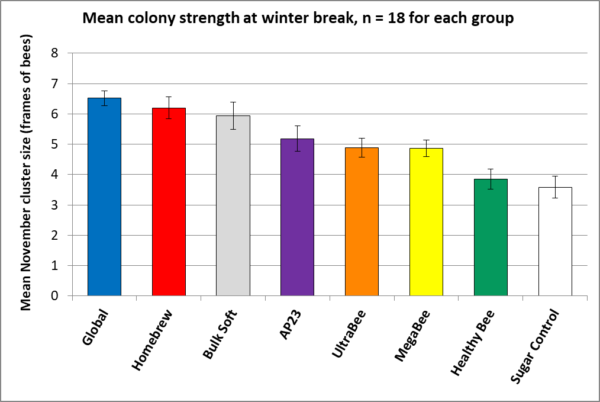
Fig. 2 The larger cluster sizes of the colonies fed the better subs, relative to the Sugar Controls, indicates the positive benefit from feeding pollen sub (a t-test p-value < 0.00001 for Global vs. Control, thus validating the experimental design). The relatively small standard errors indicate that the differences in performance relative to diet type are meaningful. The above data matched our field observations as far as colony preference for (consumption wise), and performance in response to, diet type — with the blue, red, and silver treatment groups being standouts (note that only two of those three diets contained natural pollen).
Practical application: As we’ll see next month, the cluster size of a colony going into winter made a big difference on how they build up for almond pollination. Keep the above ranking of performance of the subs in mind.
OK, now that you’ve got the ranking of how the diet type affected colony performance as far as cluster size at the midpoint, let’s see how diet affected the biology of the bees.
VINCE’S LABORATORY ANALYSES AT THE MIDPOINT
We put a lot of field work into this comparative trial of the diets. But this wasn’t just a test to see which subs were “best,” but rather an opportunity to learn why some diets perform better than others. At the grading in early November, I froze samples of workers vacuumed from the top bars of the broodnests. Vince and his technician Steven Tyler Williams performed weight and molecular analyses on the sampled bees, as well as sending samples of the patties out for nutritional analysis.
At the USDA lab, they removed and dried the heads and thoraces of 15 bees from each sample, and weighed them as a group. This allows us to compare individual bee glandular and muscular development to colony cluster size as a result of being fed each diet (Figure 3).
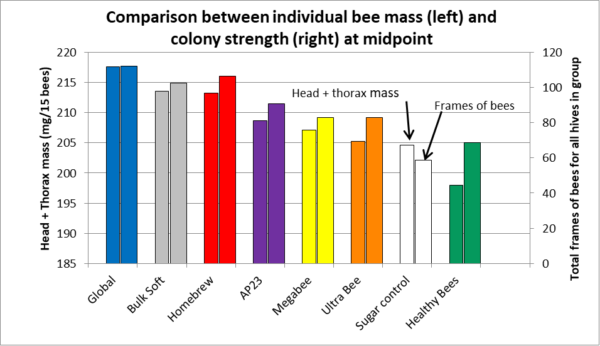
Fig. 3 Average individual bee mass (weight) closely correlated with colony strength (R2 = 0.80 [[1]]), indicating that what’s nutritionally good for the individual bee is good for the colony as a whole.
Practical application: Head and thorax weights are often used as the metric for laboratory studies on bee diet quality; the data above support that assumption. I’ll discuss this in greater depth in a subsequent article.
PATTY CONSUMPTION
Since an artificial diet is of little value if the bees aren’t stimulated to consume it, a question to answer is whether the bees treated the offered patties as food, or as junk to be removed from the hive. The only diet type that we saw being discarded to any extent was the Healthy Bee with thyme oil. Conversely, it was no surprise that the two patty types containing natural pollen were consumed quickly and completely. However, note that the other diets were not far behind (Figure 4).
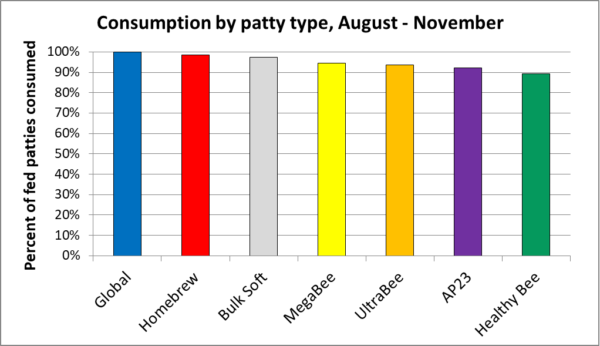
Fig. 4 The bees preferred some formulations over others, but at least 90% of all patty types were consumed during this feeding period. Global and Homebrew, likely due to being 15-20% natural pollen, were the most quickly and completely consumed, but the others were not far behind. There were no appreciable yard-to-yard differences in overall patty consumption — 95% and 96% at the E and T yards; and 97% at the H yard (which was fed 2 lbs. more).
Practical application: Although the bees consumed some subs more eagerly than others, it doesn’t appear that there was a big enough difference in consumption between diet types to account for the differences in colony performance at the midpoint, and reduced consumption may have partially been a function of colony size.
WHY WERE SOME SUBS MORE (OR LESS) PHAGOSTIMULATORY?
The scientific term for stimulating an organism to eat is “phagostimulation” — “phago” meaning “to eat.” So what makes an artificial diet phagostimulatory to the nurse bees (the workers that actually consume the patties)?
BACKGROUND
Although some researchers have proposed that nurse bees can differentiate diets by nutritional quality, I find their arguments unconvincing. On the other hand, in a highly-informative study, Vanessa Corby-Harris [[2]] performed a series of choice assays of natural and nutritionally-supplemented pollens, and came to the conclusion:
… that nutritional value plays a minimal role in nurse bee diet choice … although certain pollens provide a greater benefit per unit of consumption, honey bee nurses either cannot or do not discriminate among pollens based on nutrition.
Practical application: I’m not convinced that bees can tell whether a diet is nutritious or not by taste or smell. But you must make any artificial diet smell or taste “good” to the patty-consuming nurse bees, in order to encourage them to eat it.
Side note: Having recently lost all sense of taste for some months due to radiation treatment of my tongue, I can attest to the importance of sensory phagostimulation to induce what we’d call “the desire to consume” any particular food choice.
I and others have observed that bees clearly have preferences for some natural pollens over others. Each of the patty types smelled different to my human nose, so I don’t doubt that odor was a factor in nurse feeding preference for the tested subs.
NATURAL POLLEN AS A COMPONENT
Back in 1973, USDA researcher Lonnie Standifer found, not surprisingly, that the addition of 5% natural pollen to their tested artificial diet improved consumption and the amount of brood reared, but that there was not much gain from increasing the proportion to 20% [[3]]. Standifer concluded that:
The better performance of colonies fed rations containing pollen may occur because of feeding stimulants present in the pollen rather than because the rations containing no pollen lack nutrients.
Schmidt and Hanna [[4]] later determined that there are a suite of phagostimulatory compounds in pollen. Not surprisingly, in this trial the bees eagerly consumed the two products containing natural pollen, but some of the completely artificial diets were also quickly consumed by the bees. The Global patties are advertised as containing 15% natural pollen (irradiated against pathogens); the Homebrew patties contained 20% pollen by dry weight. The addition of natural pollen to those products means that they were technically “pollen supplement” or “pollen extender” formulations, rather than pollen substitutes (completely “artificial diets”).
It’s well-known that colonies respond well to patties of trapped pollen moistened with sugar syrup. But natural pollen is expensive, may contain agricultural chemicals, can vary greatly in nutritional and phagostimulatory value, and if not sterilized, can transmit the full spectrum of bee pathogens.
Practical application: I’ve got nothing against using trapped pollen for feeding bees, but true “pollen substitutes” are artificial diets that do not contain bee-collected pollen as an ingredient, which allows them to be more standardized and less expensive. Some of the tested artificial diets performed nearly as well as products containing natural pollen, which is very encouraging.
FEEDING ATTRACTANTS OR DETERRENTS
Some of the subs contained lemongrass oil, which contains one of the components of honey bee orientation pheromone (citral). I’m not clear as to whether lemongrass oil is phagostimulatory or merely attracts the nurses to the proximity of the patty. At least one sub also contained spearmint oil and thymol.
One must be careful with essential oils in diets, since bees are strongly repelled by some aromatic essential oils. The Healthy Bee patties that I tested were quite aromatic with thyme oil, which may have unfortunately acted as a feeding deterrent to the bees (and also to Small Hive Beetle). I showed a photo in my previous article of how the bees dragged Healthy Bee patty out of the hive.
MOISTURE AND TEXTURE
The bees seemed to prefer moist patties over drier patties. The tested subs varied widely in texture and moisture content. (I strongly suggest to the manufacturers that they wrap their subs in plastic bags, so that they don’t dry out during storage.)
Vince also had a commercial lab analyze the patties for protein, amino acids, lipids, and sugars. Let’s see whether the amounts of those elements affected how well the bees “liked” the patties.
SUGAR CONTENT
We all know that bees like sugar. And if there is either a natural pollen flow occurring, or if the bees don’t like something about an artificial diet, they will often just suck the sugar out of a patty, and remove the remainder as trash. So how much sugar was in the tested subs (Figure 5)?
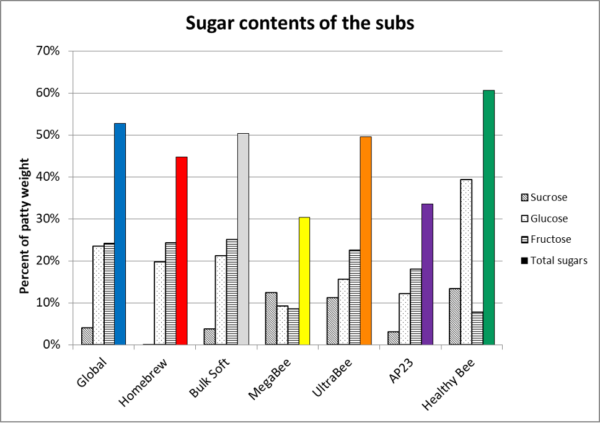
Fig. 5 I ordered the subs from left to right by consumption preference as in the previous graph. The patties ranged from 30% to 60% sugar content. Note that the sugar content did not correlate with consumption preference. Despite AP23 and MegaBee both having low sugar contents, they were still well consumed. Apparently, a high sugar content is not necessary for an artificial diet, nor does it guarantee rapid consumption.
The breakdown of the sugars indicates that most formulations used high-fructose corn syrup (consisting of fructose and glucose) as the main sweetener, likely not only due to its low cost, but because it makes for a patty that maintains its soft texture. Most also contained a lesser amount of sucrose.
PROTEIN CONTENT
The main purpose for feeding pollen sub is to provide protein to the nurse bees. But protein content did not correlate with how well the patties were consumed or performed (Figure 6).
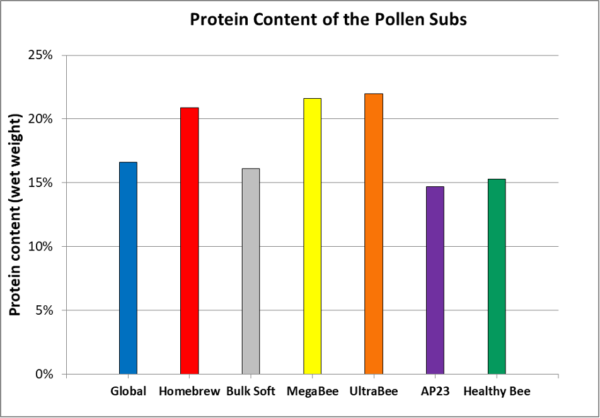
Fig. 6 The diets are ranked from left to right by consumption (from Figure 4). The protein concentration did not correlate with consumption, nor (as we’ll see further along) with performance.
Practical application: The colonies clearly didn’t consume patties according to their protein contents. A strong shot of protein may allow a burst of colony growth [[5]], but as we’ll see, over the long term patties with only 15% protein can perform as well as those with over 20%. This is important to know, since protein is typically the most expensive component of pollen subs. But as I’ll elaborate upon in a subsequent installment, our results suggest that more important than total protein is the balance of the essential amino acids.
LIPID CONTENT (INCLUDING ESSENTIAL FATTY ACIDS AND STEROLS)
Natural pollens vary in their lipid contents, but generally fall within the 3-10% total lipid content range, with the pollen of the bee-attractive and nutritionally complete clovers and mustards falling into the 6-10% range [[6], [7]]. So how important was lipid content as far as consumption? See Figure 7.
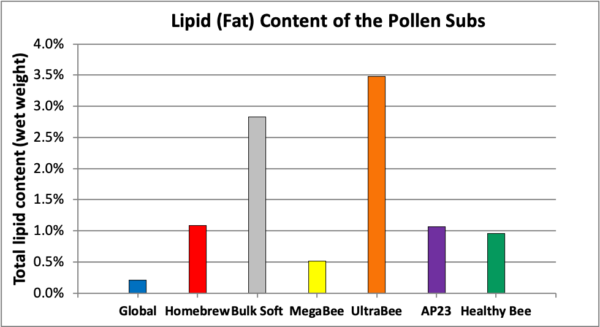
Fig. 7 Again shown in order of consumption. Cleary lipid content did not define how phagostimulatory the subs were. Most surprising to us was that Global, which was one of the most quickly consumed patties, had by far the lowest lipid content.
Australian researcher Rob Manning tested a number of vegetable oils as phagostimulants [[8]], and my own observations are that canola and corn oil appear to be attractive to bees. Vegetable oil may also be added to improve the texture of a sub. The chart above indicates that the manufacturers don’t agree upon how much oil in a diet is optimum.
Practical application of the above findings: Well, it sure didn’t appear to be the sugar, lipid, or protein proportions of the patties that defined how phagostimulatory the formulations were. So based upon these results, it would be hard to come up with any rules of thumb for how to formulate an artificial diet in order to stimulate consumption, other than having enough sugar, and some scent or taste components that are phagostimulatory to the nurses.
MOLECULAR ANALYSIS OF THE GUT MICROBIOME
We’ve heard a lot about how important the gut microbiome is to our health and that of our bees. Vince focused on the “core” microbiome bacterial types since these constitute 90+% of all bacteria in the gut and have functional significances linked to physiology and health (Figure 8).
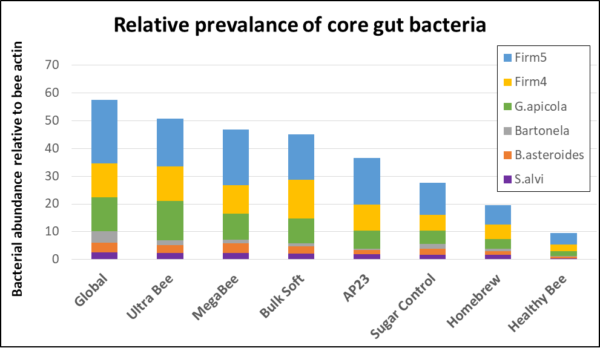
Fig. 8 Of interest is that one might expect to see the greatest amount of core gut bacteria in the two groups fed patties containing natural pollen, but that was only the case with Global. Surprisingly, bees fed Homebrew, with even a greater proportion of pollen, had only a third the amount of bacteria present in Global — and even less than the sugar controls. The thyme oil in Healthy Bee may not have been friendly to the gut microbiome — a result that Vince is currently following up on with laboratory experiments.
The last observation is of interest, since Vince has previously shown that spirulina has great potential as a component of artificial diets [[9]]:
Spirulina diets produced biomarker profiles (thorax weight, head protein content, and beneficial gut bacteria abundance) that were indicative of elevated nutritional states, meeting or exceeding the other diets in some metrics despite reduced consumption.
Practical application: We strongly suspect that it was the added thyme oil in Healthy Bee that negatively affected consumption, head and thorax weight, the gut microbiome, as well as overall colony performance. The last thing that we want to do is to trash spirulina as a potential bee feed component. I’ve been in regular contact with the manufacturer of Healthy Bee, who informed me as I was typing these words that they now offer a Healthy Bee formulation free of thyme oil [[10]].
Although the two extremes in the above graph correlate with colony performance, that’s hardly the case for those diets lying between. Note, however, no matter what the diet type or whether it contained natural pollen, the relative proportions of the core bacterial groups remained consistent.
Practical application: The core microbial gut community appears to be able to maintain proportional homeostasis despite the diet formulation or the presence of natural pollen. That’s good news for the development of artificial diets. Why the bees consuming Homebrew had only a third as many core bacteria as did Global remains an open question, but since it did not hamper Homebrew’s performance, perhaps the amount of bacteria in the gut is not that critical. It is important to keep in mind that gut microbiome dynamics are complex, with their relationship to foraging environment and food sources still poorly understood.
NOSEMA CERANAE
The bee midgut (where pollen sub is actually digested) is also where Nosema ceranae reproduces. In the sampled bees, there was great yard-to-yard and sample-to-sample variation, which prevents us from drawing firm conclusions as to diet type and nosema. However, it occurred to me that since nosema infection intensity generally reflects the amount of pollen that the bees are consuming [[11], [12]], that the amount of nosema in the sampled bees might correlate with the protein concentration of the diet that they had been consuming. That appears to indeed be the case (Figure 9).
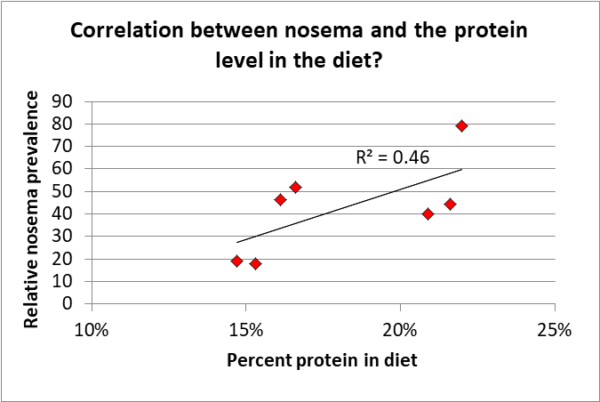
Fig. 9. The trial was not set up to specifically answer this question, but the data certainly suggests that the infection intensity of Nosema ceranae correlated with the amount of protein in the diet.
Practical note: Beekeepers freak out about nosema spore counts, not understanding that spore counts go up relative to the amount of pollen that the bees are consuming. At the same time, the increased nutrition from the pollen largely offsets the negative effects of nosema infection in the bees. This likely also applies to the feeding of pollen sub — spore count will go up, but the bees will still benefit from the supplemental diet.
THE EFFECT OF OXALIC ACID TREATMENT
Not being one to miss an opportunity to squeeze some extra information out of a data set, it occurred to me that all the colonies in the trial had been treated continually with extended-release oxalic acid at a low level [[13]] — that is, except for eight potential breeder colonies spread throughout the yards and fed the same diets, but never having received an oxalic treatment. Aha, I thought, perhaps we can gain some insight into the question of whether extended exposure to oxalic acid affects the gut microbiome (Figure 10).
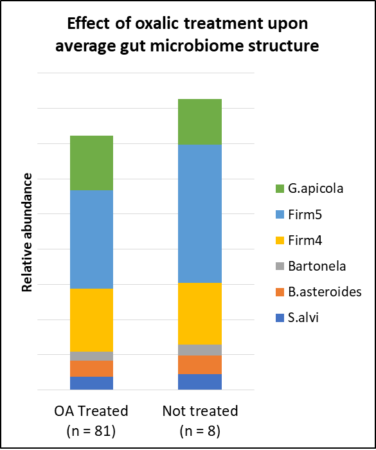
Fig. 10 The trial was not set up to answer this question, and there were not enough samples in the untreated group to draw a firm conclusion, but the above data suggest that extended exposure to a low level of oxalic acid does not adversely affect the gut microbiome of the treated bees.
Practical application: Good news!
OK, since I’m on a roll, Vince also performed qPCR to determine the relative abundance of DWV-A in the same bee samples (low-dose OA-treated vs. untreated near-zero-mite breeders). We frequently monitored the OA-treated hives for varroa, and mite wash counts rarely exceeded a 2% infestation rate. Despite those low infestation rates, the differences in their relative levels of DWV-A in November is striking (Figure 11).
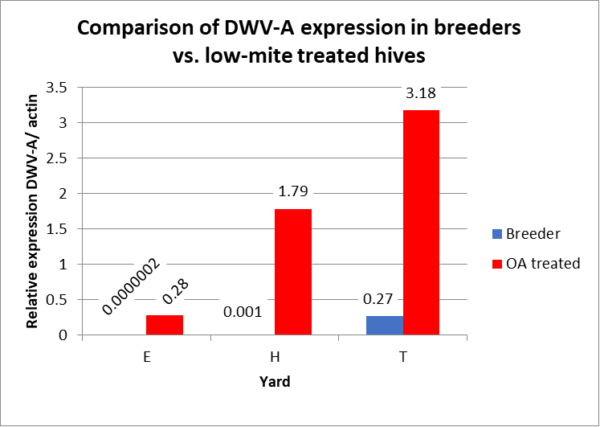
Fig. 11 We were surprised by the huge differences in DWV-A level between the low-mite OA-treated hives, and the few potential breeders that kept mite counts to zero by themselves. Since the DWV levels of the E- and H-yard breeders are too low to show in this non-logarithmic graph, I just put the relative expression numbers above where their blue columns would be. Qualifier: Again, there were only 8 mite-resistant colonies, but their average virus expression levels were anywhere from eleven to over a million times lower than the averages of the analyzed other hives in the same yards.
Practical application: The workers in the varroa-resistant colonies had strikingly lower Deformed Wing Virus levels than did those in the low-mite treated hives. We gotta get serious about selecting for varroa-resistant bee stock!
Molecular analyses such as those above may help us to understand why and how different diets might affect worker physiology and their microbiomes, and how that relates to colony performance.
TAKE HOMES AT THE MIDPOINT
So what have we learned so far?
- The bees consumed most of the diets well, although some were a bit more phagostimulatory than others. Although the bees clearly “liked” natural pollen, it wasn’t a necessary component of a successful diet.
- Total protein in the 15-20% range appears to be adequate, but note that researchers at the Tucson lab found that a 23-30% protein diet worked better than 10% or 50% [[14]].
- Most diets contained sugars in the 50% range (wet weight), but colonies consumed MegaBee well despite it containing only 30% sugars.
- One thing that comes to mind is the necessary protein to carbohydrate (P:C) ratio in a bee diet, the carbohydrate portion consisting of sugars. Royal jelly, the sole diet of young larvae or the queen, has a P:C ratio between 1:1 and 1:2 [[15], [16]]. For newly-emerged workers or nurse bees producing jelly (critical for colony buildup), it’s likely in the range of 1:2 – 1:5. But for foragers (which only require tiny amount of protein for body maintenance), it jumps to something in the vicinity of 1:250. So if one is feeding pollen sub for colony buildup or preparation for winter, the P:C ratios of current pollen subs appears to be in the right ballpark (18% protein and 50% sugar is a 1:2.8 ratio), with the bees able to balance any additional need for sugar by consuming honey or fed sugar syrup.
- HFCS is typically used as the main sugar source, since it maintains patty texture. The optimal amount of sucrose is not clear (if it is necessary at all). So I consider the ideal sugar formulation of a sub to remain an open question.
- It was extremely surprising to us how eagerly the colonies consumed, and how well they performed, on Global, despite it containing only 2% lipids.
- One important question was whether there is a need for pollen exines as a prebiotic for the core bacterial gut microbiome — or do the fiber and complex carbohydrates of the soy meal, corn gluten meal, or brewer’s yeast typically used as protein sources of a diet serve the purpose? Our analysis indicates that the core bacterial microbiome structure remained consistent despite the presence or absence of pollen, or even with the different artificial diet formulations, which is likely good news. In addition, bacterial abundance did not correlate with colony performance, thus making us question whether the amount of bacteria is that important.
- Going into winter, the colonies fed the better subs had clusters half again larger than the Controls, consisting of workers with better-developed heads and thoraces (regrettably, we didn’t measure fat body development). As we’ll see, this gave them an important head start when they began late-winter broodrearing for spring buildup.
TO BE CONTINUED…
OK, you’ve seen the results up to the midpoint, but don’t draw any conclusions yet! After winter break, the “winter bees” reared on these artificial diets then had to build up when we resumed feeding the same diets, prior to going to almonds. This is when the rubber hit the road, and the true performance of the diets became apparent. I’ll also perform a cost-benefit analysis, and then in a following installment suggest why some subs were able to outperform others.
NOTES AND CITATIONS
[1] Not shown is that I ran a linear regression of the data.
[2] Corby-Harris, V, et al (2018) Honey bee (Apis mellifera) nurses do not consume pollens based on their nutritional quality. PLoS ONE 13(1): e0191050.
[3] Standifer, L, et al (1973) Influence of pollen in artificial diets on food consumption and brood production in honey bee colonies. Am. Bee J. 113: 94-95.
[4] Schmidt,J & A Hanna (2006) Chemical nature of phagostimulants in pollen attractive to honeybees. J Insect Behav 19: 521–532.
[5] http://scientificbeekeeping.com/a-comparative-test-of-the-pollen-sub/
[6] Dong, J, et al (2015) Fatty acid profiles of 20 species of monofloral bee pollen from China. Journal of Apicultural Research 54(5): 503-511.
[7] Manning, R (2001) Fatty acids in pollen: a review of their importance for honey bees, Bee World, 82(2): 60-75.
[8] Manning, R, et al (20100 Added vegetable and fish oils to low-fat pollen diets: effect on honey bee (Apis mellifera L.) consumption. Australian Journal of Entomology 49: 182–189.
[9] Ricigliano, V & M Simone-Finstrom (2020) Nutritional and prebiotic efficacy of the microalga Arthrospira platensis (spirulina) in honey bees. Apidologie 51: 898–910.
[10] https://www.healthybeesllc.com/post/back-to-the-roots-of-nutrition-our-new-formula
Field testing of our product without essential oils began around a year ago with commercial beekeepers. So far, the feedback has been great. Even greater royal jelly production than the original, better consumption and “fluffier bees”. Which I normally correlate to good individual physiology due to nutrition…So now we are proud to offer a strictly nutritional version of our product, formulated to provide superior gut health along with nutrition.
[11] Zheng, H, et al (2014) Spore loads may not be used alone as a direct indicator of the severity of Nosema ceranae infection in honey bees Apis mellifera (Hymenoptera:Apidae). J. Econ. Entomol. 107(6): 2037-2044.
[12] Jack, C, et al (2016) Effects of pollen dilution on infection of Nosema ceranae in honey bees. Journal of Insect Physiology 87:12-19.
[13] I had a Pesticide Research Authorization to do so.
[14] Herbert E, H Shimanuki, D Caron (1977) Optimum protein levels required by honeybees (Hymenoptera, Apidae) to initiate and maintain brood rearing, Apidologie 8, 141–146.
[15] Garcia-Amoedo L & L de Almeida-Muradian (2007) Physicochemical composition of pure and adulterated royal jelly. Quim Nova 30(2):257–259
[16] Helm, BR, et al (2017) The geometric framework for nutrition reveals interactions between protein and carbohydrate during larval growth in honey bees. Biol Open 6(6): 872–880.






 Fig. 6 I took this photo on the day of final grading. The cluster barely covered three frames, but was rearing as much brood as it could keep warm. There are about 1500 pupae on this side, and only 445 adult workers (yes, I counted ‘em). The 7-frame colonies contained three full frames of brood. It’s easy to see how colonies can grow quickly once pollen becomes available.
Fig. 6 I took this photo on the day of final grading. The cluster barely covered three frames, but was rearing as much brood as it could keep warm. There are about 1500 pupae on this side, and only 445 adult workers (yes, I counted ‘em). The 7-frame colonies contained three full frames of brood. It’s easy to see how colonies can grow quickly once pollen becomes available.



























































 x
x



























